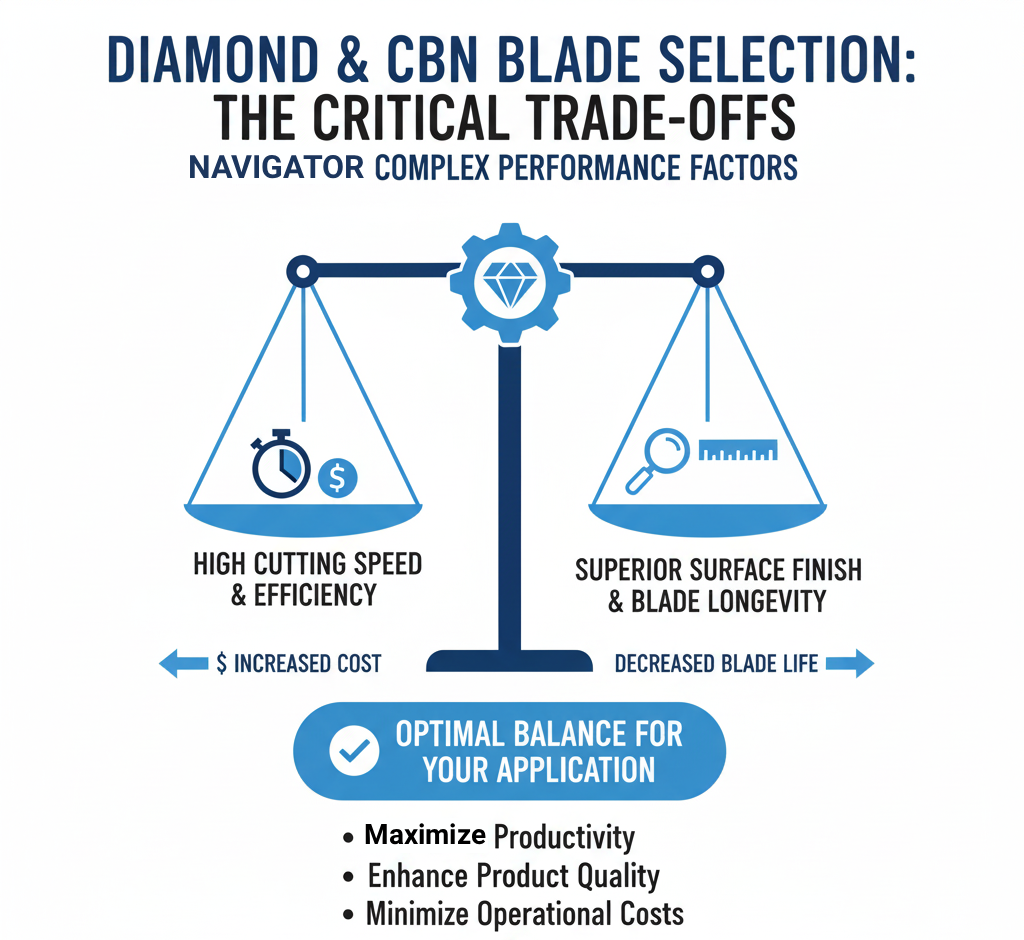Precision & Ultra Thin Diamond Blade Guide
-
Posted by
 Ayan Sadyk
Ayan Sadyk

Table of Contents
ToggleDiamond and CBN blades are available in an extensive array of varieties, each differing in bond types, manufacturing methods, and design specifics. Ultra Thin & High Precision Diamond Blades are particularly versatile, applicable in a wide range of processes including Slicing, Dicing, Wafering, Cut-off, Singulation, Grooving, Slotting, Cross Sectioning, Sample Preparation, Gang Sawing, Slabbing, and Rough Cutting. Understanding the nuanced differences between each blade type and their intended applications is important for users aiming to maximize the performance of their cutting operation.
Share this Article with Friend or Colleague
To assist users from novices to experienced manufacturing engineers, researchers, and professional craftsmen, this comprehensive guide has been written. This guide is designed to show the critical variables that influence the success of any diamond sawing operation. Each blade is tailored for specific applications and may perform differently under various conditions. What proves effective in one scenario may not work in another. Through this guide, users will gain essential insights to make informed selections, ensuring they choose the right diamond & cbn blade for their specific material and application on the first attempt.
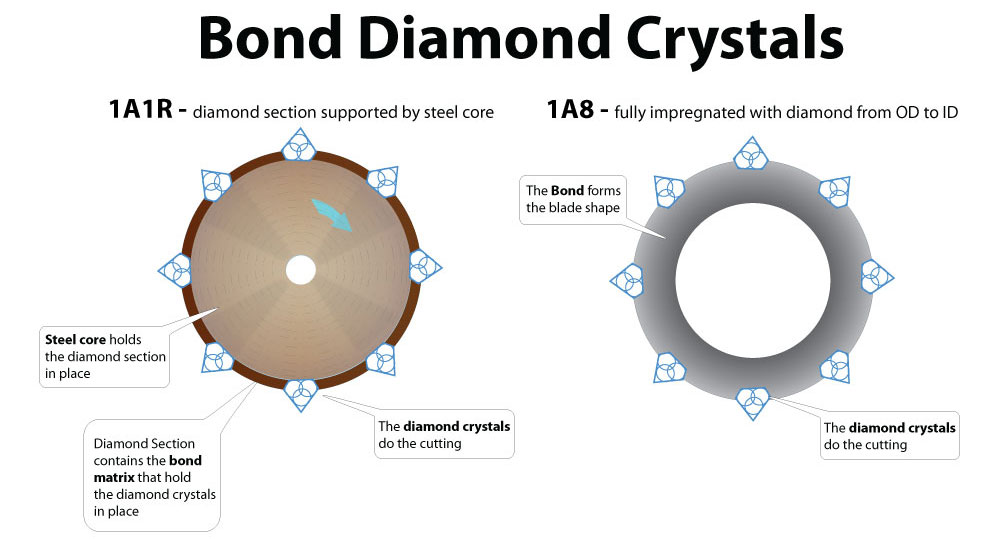

How Diamond & CBN Cutting Blades/ Cutting Wheels Work?
Diamond and CBN blades are advanced cutting tools that utilize exposed diamond or CBN particles embedded in a bond matrix. These particles act as tiny cutting edges that wear down slowly during cutting, exposing new, sharp edges for efficient material slicing. The blades can achieve surface speeds up to 30 meters per second, akin to highway speeds, which facilitates the efficient removal of material in the form of small chips. Find out more: How Diamond & CBN Blades Work >>>
The effectiveness of these blades depends on several factors: the concentration of diamond or CBN particles, the hardness of the bond matrix, and the size of the particles, which influence the size of the chips produced. The thickness of the blade determines the width of the cut and affects the blade’s overall stability and wear rate.
Choosing the right blade involves considering the feed rate, cutting speed, and depth of cut to optimize cutting efficiency and extend blade life. This careful selection is crucial for achieving precise cuts and minimal material waste in applications ranging from construction to the manufacturing of advanced electronics.
SMART CUT® technology
SMART CUT is an advanced technology that redefines the standard in cutting and drilling. Diamonds are oriented inside matrix, so that every diamond is better able to participate in cutting action. SMART CUT™ open bond bond design makes sure every diamond is in the right place and at the right time, working where you need it most. You get maximum use of diamond and bond. Find out more..
Some of the advantages of SMART CUT™ in Diamond Blades include:
SMART CUT® Difference
- More Consistent & Uniform Overall Performance
- Faster Machining Action
- Minimal Loss of Material
- Easier to Use
- Minimal Chipping
- Minimal Machining Noise
- Minimal Tool Dressing / Diamond Rexposure
How SMART CUT ® Bond Works?
The sharpest and finest quality diamonds or CBN crystals that go into a SMART CUT® Diamond Bond, immediately penetrate into the material, grinding and polishing as they cut.

Diamonds or CBN Crystals are activated only at the exposed layer. As Bond Matrix layer begin to wear out, diamonds in a new Bond Matrix layer are immediately activated, substituting the already used up diamond layer. The SMART CUT® Bond Diamond Bond makes sure every diamond is in the right place and at the right time, working where you need it most.
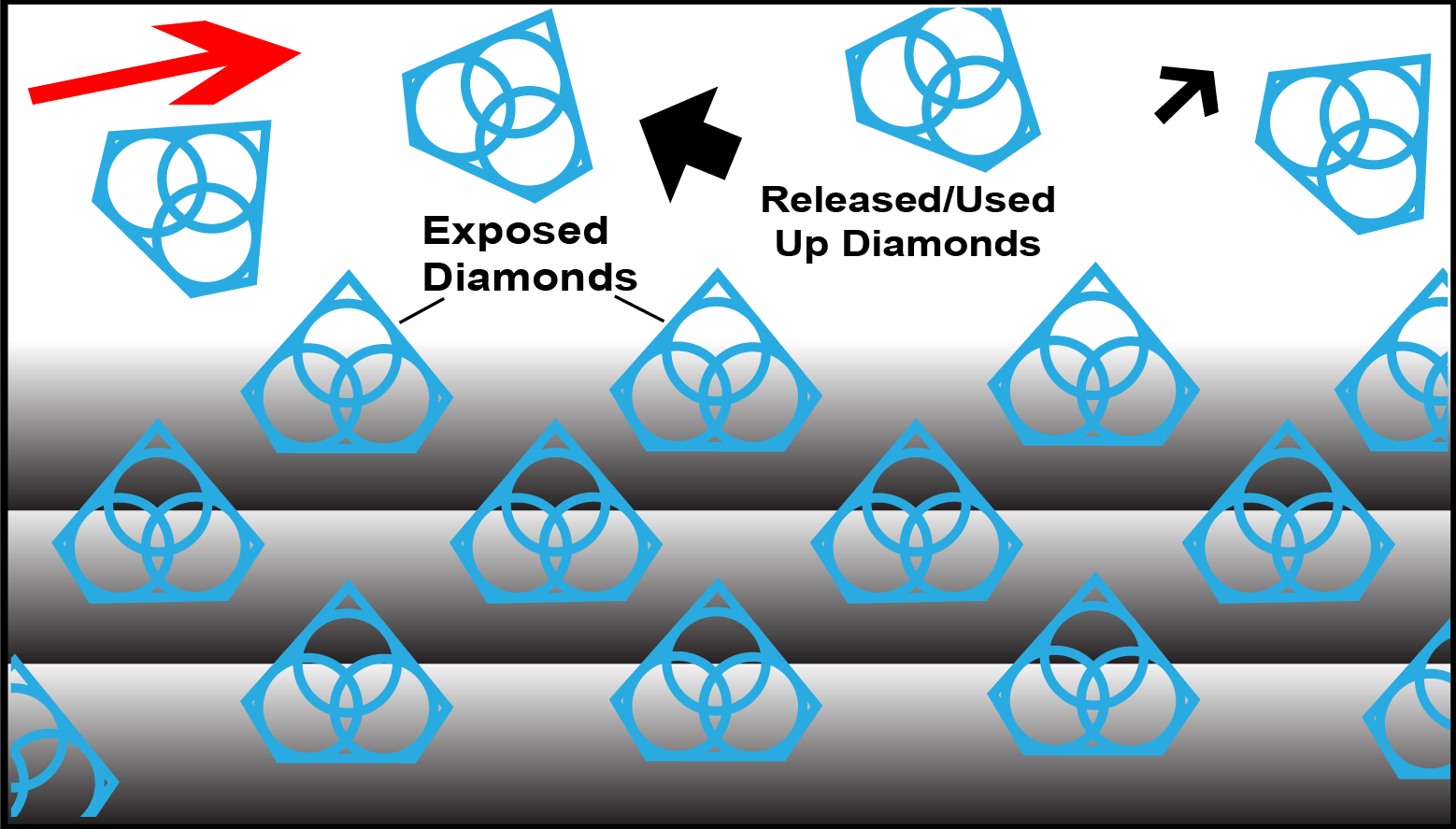
The newly exposed diamonds don't effect diamonds already working on the material. Unlike many other diamond bonds, diamonds in a SMART CUT® remains sharp and grow sharper with each cut, prolonging product life and consistent performance.
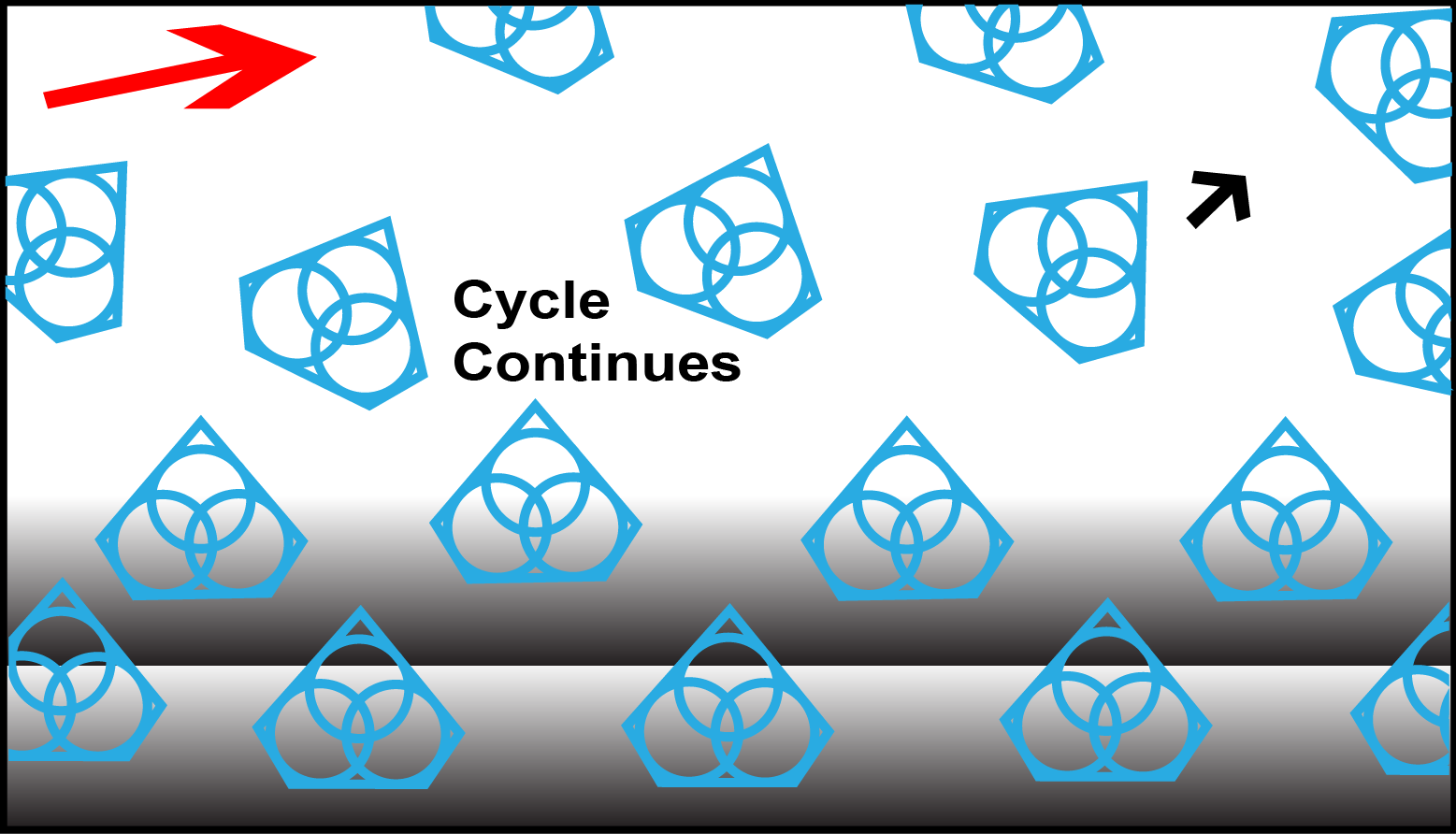
This advanced formulated open diamond bond design insures minimal chipping, fast cut, constant speed of cut, minimal cutting noise, and most important of all, consistent performance.
What is the Difference Between diamond & cbn cut-off blades, diamond & cbn cut-off wheels, diamond & cbn slicing blades, and diamond & cbn cutting blades
The terms "diamond cut-off blades," "diamond cut-off wheels," "diamond slicing blades," and "diamond cutting blades" are often used interchangeably, much like how we might refer to a car, vehicle, or automobile. While they generally refer to the same basic tool—a blade embedded with diamond particles for cutting—they come in various types and specifications, each tailored to specific applications, much like cars that come in different models, configurations, and powertrains.
These terms usually describe circular tools designed for cutting through hard and brittle materials, with variations in thickness, edge type, and intended use—ranging from precision laboratory work to heavy-duty industrial cutting. Some blades are specialized for creating thin, uniform slices of materials like silicon wafers or ceramics, similar to how certain cars are designed for performance or fuel efficiency. Other blades serve as a broad category, encompassing all diamond-embedded cutting tools, much like referring to any vehicle as a "car." These can be designed for various applications, from cutting construction materials like concrete and stone to the precision cutting of metals and composites in a laboratory setting.
While the terms may be used interchangeably, understanding the specific type of blade—just as you would with a vehicle—can help ensure you select the right tool for the job, maximizing efficiency, precision, and durability.
Different Types of Cutting Process that use Diamond & CBN Blades
Diamond & CBN blades are used for different process and applications. Here are just some of the process where these cutting blades are used:
Slicing: This involves cutting thin slices from bulk materials, often used in the manufacturing of components from delicate materials like crystals or ceramics.
Dicing: Dicing is primarily used in the semiconductor industry to cut wafers into individual semiconductor chips. Ultra Thin & High Precision Diamond Blades ensure minimal substrate damage and high precision in chip size.
Wafering: Similar to dicing, wafering is the process of slicing semiconductor wafers from a bulk crystal, typically silicon. The precision of the diamond blades ensures that wafers are cut to the exact thickness required with smooth surface finishes.
Cut-off: This process involves severing materials using a perpendicular cut. It's used across various industries for cutting parts to length or for sectioning prior to inspection or further processing.
Singulation: Singulation is the process of separating connected, but individually complete units, such as die or components on a semiconductor wafer, ensuring each unit is isolated without damage.
Grooving: Grooving involves cutting a groove into the surface of a material. This is often used in the fabrication of microfluidic devices or in applications requiring precise embedding of parts.
Slotting: Similar to grooving, slotting involves cutting a slot in a material, but typically deeper or through the entire workpiece. It's crucial for assembly operations where parts must interlock or fit together precisely.
Cross Sectioning: This process involves cutting a cross-section of a material for examination or analysis. It's used extensively in materials science to study the internal structure of materials under a microscope.
Sample Preparation: This involves preparing samples for testing or analysis. Precision is key here to ensure that the integrity of the sample is maintained and that the surface is representative of the whole.
Gang Sawing: This method uses multiple blades to cut several pieces of material at once. It’s particularly useful in the stone industry for cutting multiple slabs of stone simultaneously.
Slabbing: Slabbing is the process of cutting large blocks of material, like stone or concrete, into slabs. This is commonly used in the construction and monument industries.
Rough Cutting: This is the initial process of cutting a material into rough pieces before further processing. It's less about precision and more about reducing a larger block into more manageable sizes.
Micro-sectioning: Cutting small, precise sections for microscopic analysis, particularly in electronics for quality control and failure analysis.
Edge Trimming: Trimming the edges of materials to very precise dimensions, crucial in the fabrication of precision components.
Wafer Dicing: Separating wafers into individual semiconductor chips with high precision and minimal substrate damage.
Channel Cutting: Creating narrow channels in materials, which is critical in microfluidics and other applications requiring precise fluid paths.
Angled Cutting: Allows for cutting at specific angles for components that require precise geometric configurations.
Deep Cutting: Enables deeper cuts without compromising the structural integrity of the material, useful in geology and construction material testing.
Notching: Used for making notches in materials, a critical process in semiconductor manufacturing and material stress testing.
Scoring: Lightly cutting a surface to create a weak point for controlled cracking or breaking, often used in glass and ceramic industries.
Diamond & CBN Blades Specifications & Comparison to Other Blades Types
Diamond and CBN blades are renowned for their exceptional hardness and durability, with diamond being the hardest naturally occurring material on Earth and CBN close behind. This remarkable hardness allows them to slice through almost any material, from metals and gemstones to ceramics and composites, ensuring a longer lifespan than standard abrasives and reducing operational costs through fewer replacements.
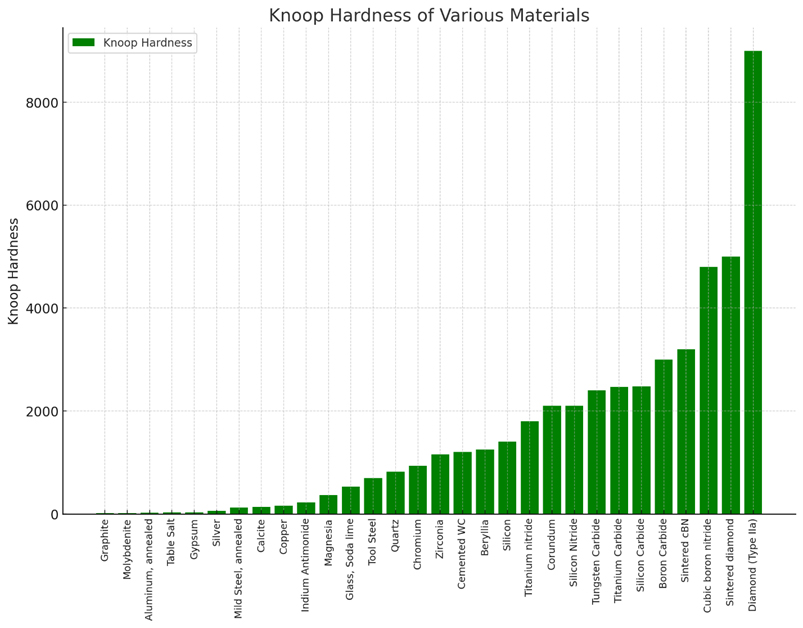
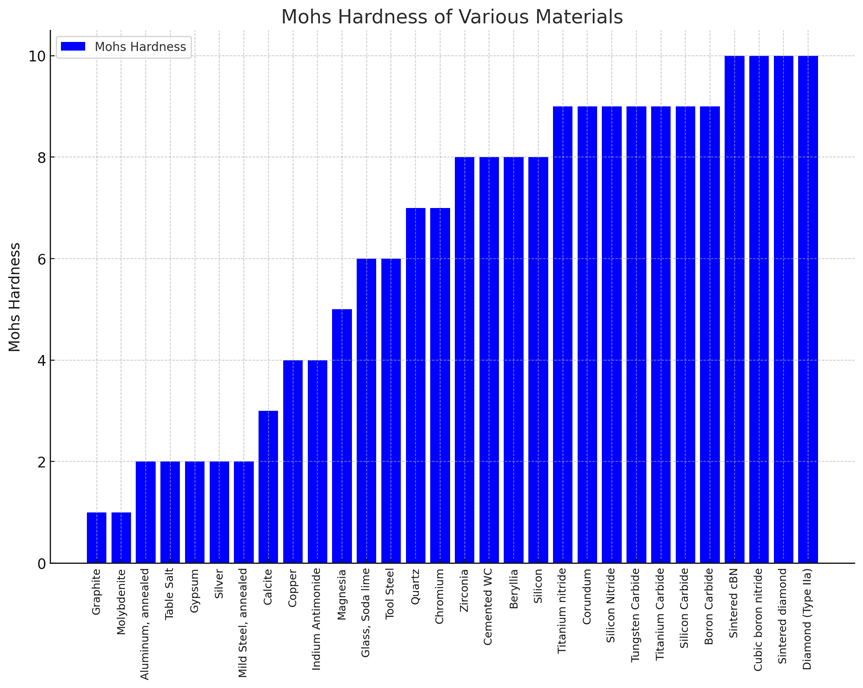
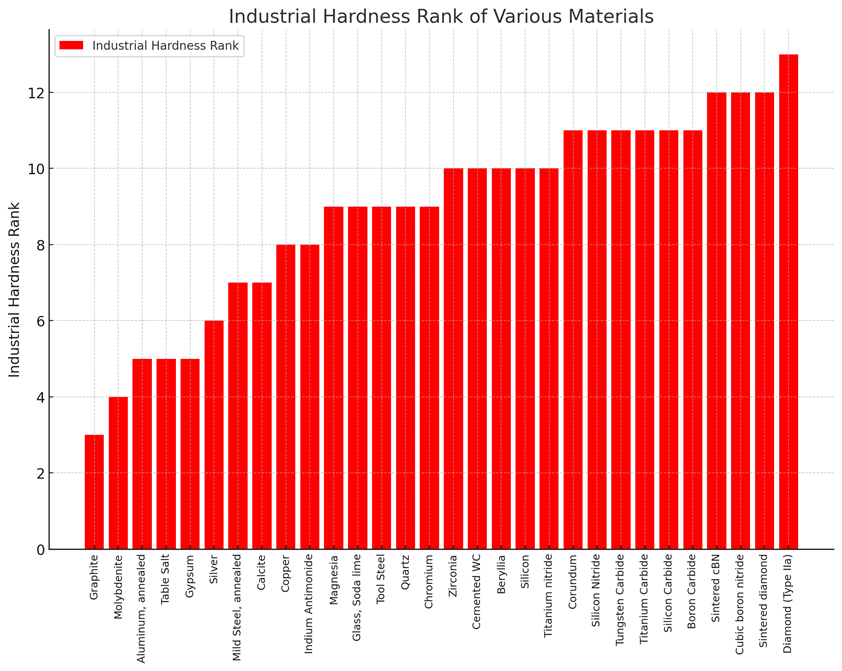
Diamond & cbn blades provide level of a cutting quality that other abrasives cannot match. They produce clean, sharp, and precise cuts essential in fields requiring exact dimensions and minimal material wastage, such as semiconductor manufacturing, gemstone processing, and precision engineering.
Diamond cutting blades stand out for their excellent thermal conductivity, allowing quick heat dissipation during cutting. This property is vital when handling materials sensitive to high temperatures, as it helps prevent thermal damage and maintains the integrity of both the blade and the material.
Additionally, diamond and CBN are chemically inert against most materials at high temperatures, making them particularly effective for cutting ferrous metals, which could react with other abrasives like silicon carbide or aluminum oxide. Their chemical stability ensures they maintain cutting effectiveness even under adverse conditions, making them invaluable for a wide range of industrial applications.
Diamond Blades
Diamond blades are specialized cutting tools that are widely used across various industries for their unmatched ability to cut through extremely hard and dense materials. These blades are embedded with diamond particles, the hardest known material, which gives them the capability to perform precise and efficient cutting operations on materials such as stone, concrete, ceramics, glass, and even some metals.
The design of a diamond blade typically involves bonding synthetic diamond particles to the edge of a steel core, either through a sintering process, resin bond, hybrid bond, electroplating, or vacuum brazing. The diamonds act as the cutting teeth, grinding through the material as the blade rotates. Because of the hardness of the diamond particles, diamond blades are exceptionally durable and can maintain their cutting efficiency for longer periods compared to other types of blades.
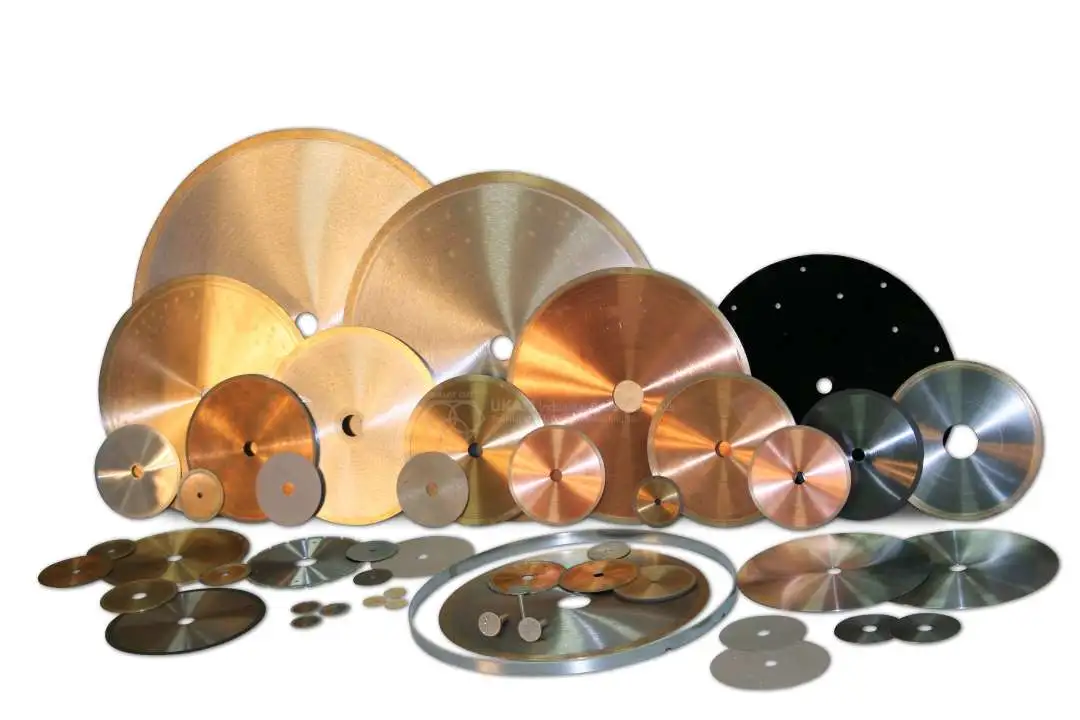

Diamond blades are used in a wide range of applications, from construction and demolition (cutting concrete, asphalt, and stone) to manufacturing and fabrication (cutting ceramics, glass, and advanced composites). They are also essential in the precision industries, such as semiconductor manufacturing and optics, where exacting cuts and minimal material loss are critical.
One of the key benefits of diamond blades is their ability to maintain a sharp cutting edge throughout their lifespan, which leads to cleaner cut quality and less material chipping. However, the blade’s effectiveness depends heavily on matching the blade type to the specific material and cutting conditions. For example, a blade designed for cutting concrete may not perform as well when used on softer materials like tile or glass.
Diamond blades typically operate at high RPMs, allowing them to take full advantage of the diamond’s hardness to grind through materials quickly. However, because diamond blades generate significant heat during cutting, proper cooling (using water or other lubricants) is essential to prevent the blade from overheating and to prolong its lifespan.
CBN Blades
Materials recommended for cutting with CBN:
-
 Alloy steels (45-68 RC)
Alloy steels (45-68 RC)
-
 Carbon tool steels (45-68 RC)
Carbon tool steels (45-68 RC)
-
 Die steel (45-68 RC)
Die steel (45-68 RC)
-
 High speed steel (45-68 RC)
High speed steel (45-68 RC)
-
 Chilled cast iron
Chilled cast iron
-
 Ni Hard
Ni Hard
-
 Forged steel
Forged steel
-
 Meehanite iron
Meehanite iron
-
 Moly chrome steel rolls
Moly chrome steel rolls
-
 Inconel 600
Inconel 600
-
 Rene
Rene
-
 Monel
Monel
-
 Stellite
Stellite
-
 Colmonoy
Colmonoy
-
 Waspoloy
Waspoloy

CBN (Cubic Boron Nitride) blades are another category of high-performance cutting tools, primarily used for cutting ferrous metals (those containing iron) and other materials that would quickly wear down diamond blades. Cubic Boron Nitride is the second hardest material known, after diamond, but it has superior thermal stability and chemical resistance when cutting ferrous materials. This makes CBN blades the preferred choice for applications involving hardened steels, cast iron, superalloys, and other tough metals.
Find more information about CBN (cubic boron nitride)>>>
Like diamond blades, CBN blades are designed by embedding CBN particles onto the blade’s cutting edge. These particles are typically bonded using similar methods, such as sintered (metal bond), resin bond, electroplated, braised bond process, to create a blade that can withstand the high temperatures and forces encountered when cutting hard metals. The CBN particles maintain their sharpness and cutting ability even under extreme conditions, making these blades ideal for precision metalworking tasks.
CBN blades are widely used in industries such as automotive, aerospace, tool manufacturing, medical, sample preparation, where they are used cutting operations that require a high degree of precision and durability. One of the main advantages of CBN blades is their resistance to chemical reactions with ferrous metals. While diamond reacts with iron at high temperatures, leading to rapid wear and loss of cutting efficiency, CBN remains stable and retains its cutting edge, allowing for longer blade life and consistent performance.
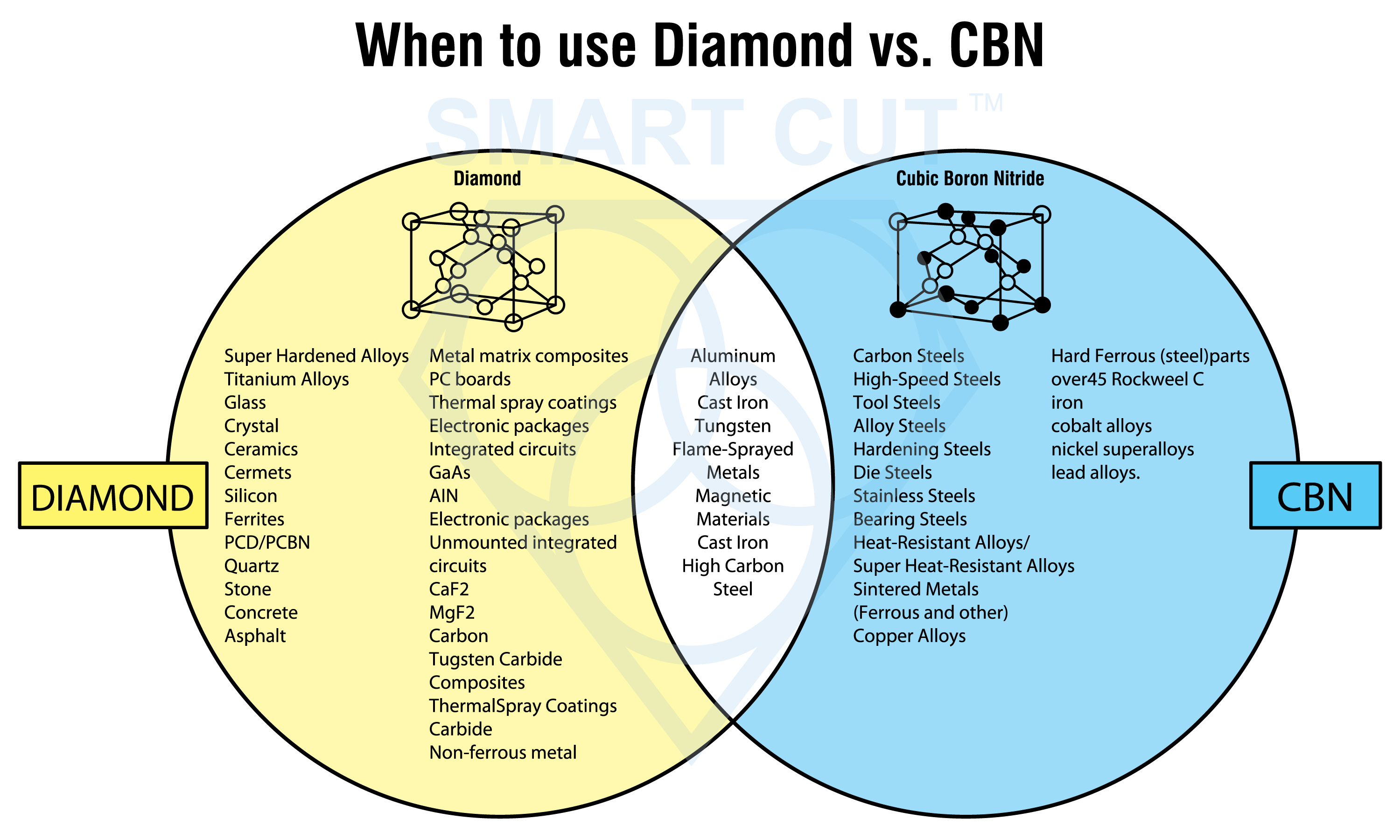
CBN blades also operate at high RPMs, but like diamond blades, they require proper cooling to manage the heat generated during cutting. Water, oil, or synthetic coolants are often used to keep the blade and workpiece cool, reduce friction, and extend the blade’s life.

Tungsten Carbide Blades
Tungsten carbide blades are known for their exceptional hardness and durability, making them a popular choice for applications that require cutting through tough and abrasive materials. Tungsten carbide is a composite material, typically made by combining tungsten carbide powder with a binder metal, such as cobalt, to create a blade that is both hard and wear-resistant.
Tungsten carbide blades are particularly effective in cutting applications involving metals, composites, and other dense materials. Their high hardness allows them to maintain a sharp edge for extended periods, even under high-stress conditions. This makes them ideal for use in industries such as automotive, aerospace, and manufacturing, where precision and longevity are crucial.
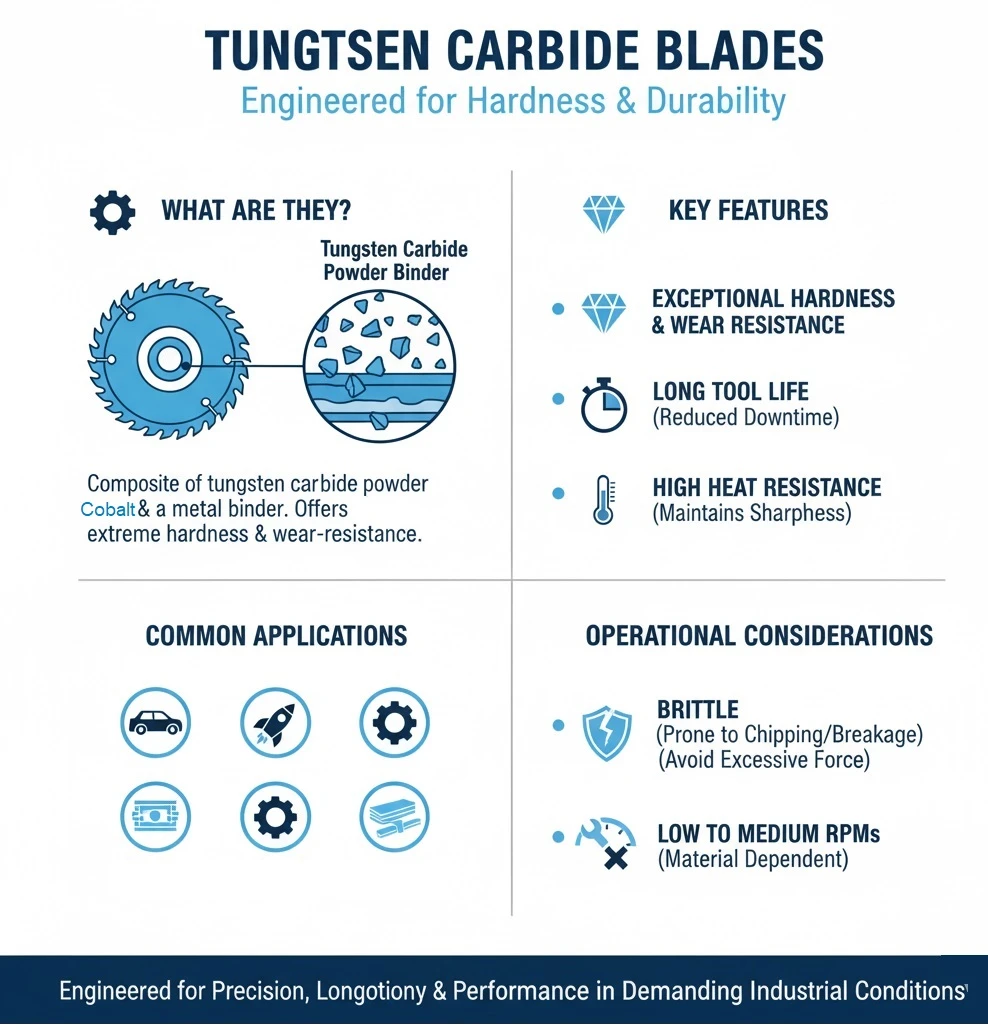 One of the key advantages of tungsten carbide blades is their ability to withstand high temperatures generated during cutting. This heat resistance, combined with their hardness, allows them to cut through materials that would quickly wear down other types of blades. However, tungsten carbide blades are also brittle, meaning they can be more prone to chipping or breaking under extreme pressure or impact.
One of the key advantages of tungsten carbide blades is their ability to withstand high temperatures generated during cutting. This heat resistance, combined with their hardness, allows them to cut through materials that would quickly wear down other types of blades. However, tungsten carbide blades are also brittle, meaning they can be more prone to chipping or breaking under extreme pressure or impact.
In terms of RPMs, tungsten carbide blades typically operate at low to medium speeds , depending on the material being cut. The blade’s rigidity and heat resistance enable it to maintain performance at these speeds, but care must be taken to avoid excessive force that could cause damage.
CVD Diamond Blades
CVD (Chemical Vapor Deposition) diamond blades are cutting tools that utilize a layer of synthetic diamond produced through a chemical vapor deposition process. This method involves depositing a thin, uniform layer of diamond onto a substrate, typically made of tungsten carbide or another suitable material, under specific conditions of temperature and pressure. The resulting CVD diamond coating offers many of the benefits of natural diamond, such as extreme hardness and wear resistance, but with enhanced thermal stability and uniformity.
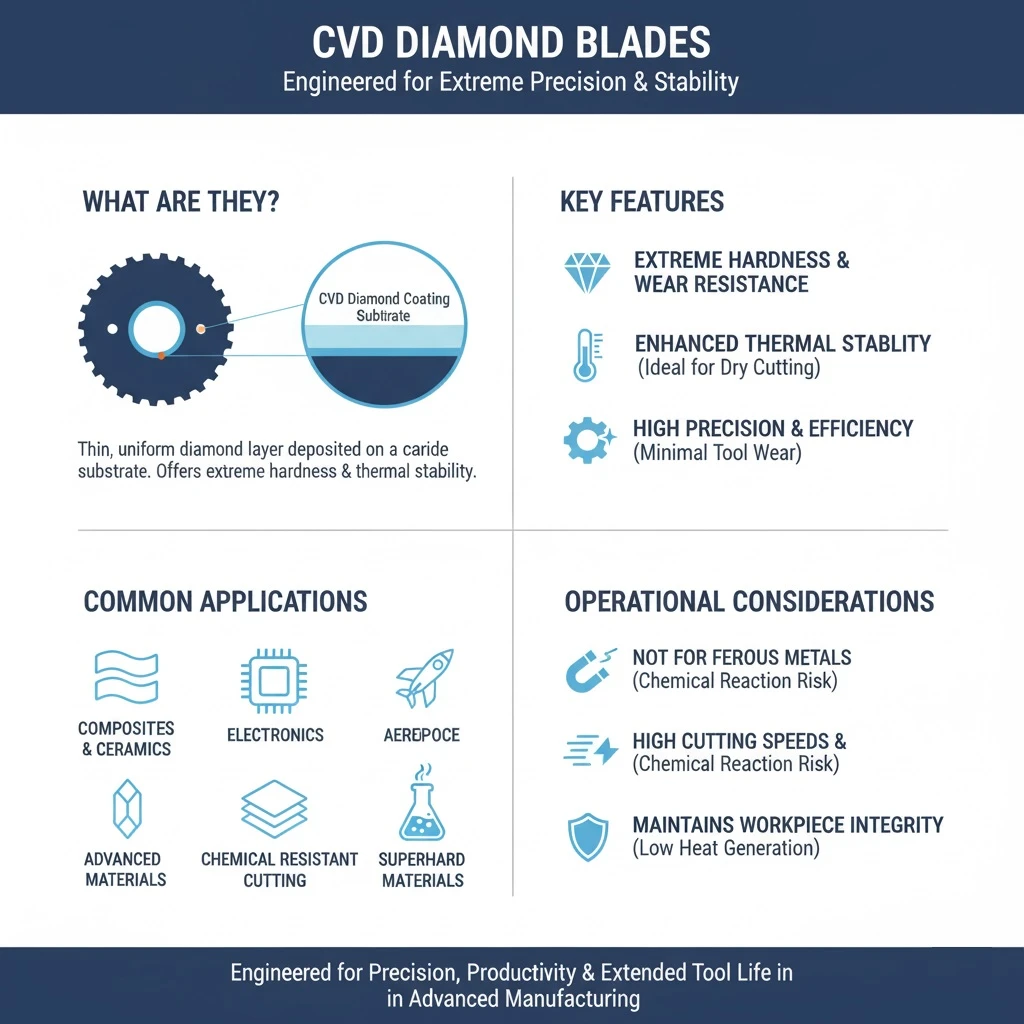
CVD diamond blades are prized for their ability to perform precise, high-performance cutting on a wide range of materials, including non-ferrous metals, composites, ceramics, and various superhard materials. The thin diamond coating allows for high cutting speeds and minimal tool wear, making CVD diamond blades ideal for applications requiring a high degree of accuracy and efficiency. They are commonly used in industries such as aerospace, electronics, and advanced manufacturing, where cutting-edge precision is critical.
One of the key advantages of CVD diamond blades is their ability to maintain sharpness over extended periods, even under harsh operating conditions. The uniform diamond layer provides consistent cutting performance and reduces the need for frequent blade changes, thus improving productivity. Additionally, CVD diamond blades are highly resistant to chemical reactions, making them suitable for machining materials that would otherwise cause rapid wear on conventional tools.
CVD diamond blades also excel in dry cutting applications where lubrication or cooling is not feasible. The thermal conductivity of the diamond helps dissipate heat away from the cutting edge, reducing the risk of thermal damage to both the blade and the workpiece. This makes them particularly useful in applications where maintaining the integrity of sensitive materials is essential.
PCD Diamond Blades
PCD (Polycrystalline Diamond) blades are another advanced cutting tool that incorporates diamond, but with a different manufacturing process and structure compared to CVD diamond blades. PCD is created by sintering together numerous small diamond particles under high pressure and temperature, forming a polycrystalline structure. This diamond layer is then typically bonded to a carbide substrate, resulting in a tool that combines the hardness of diamond with the toughness and impact resistance of carbide.
PCD diamond blades are known for their exceptional durability and wear resistance, making them suitable for cutting abrasive materials that would quickly wear down other types of blades. These blades are commonly used for cutting composites, wood, laminates, plastics, non-ferrous metals, and other abrasive materials. The polycrystalline structure of the diamond layer provides multiple cutting edges, allowing the blade to maintain sharpness over extended periods, even in challenging applications.
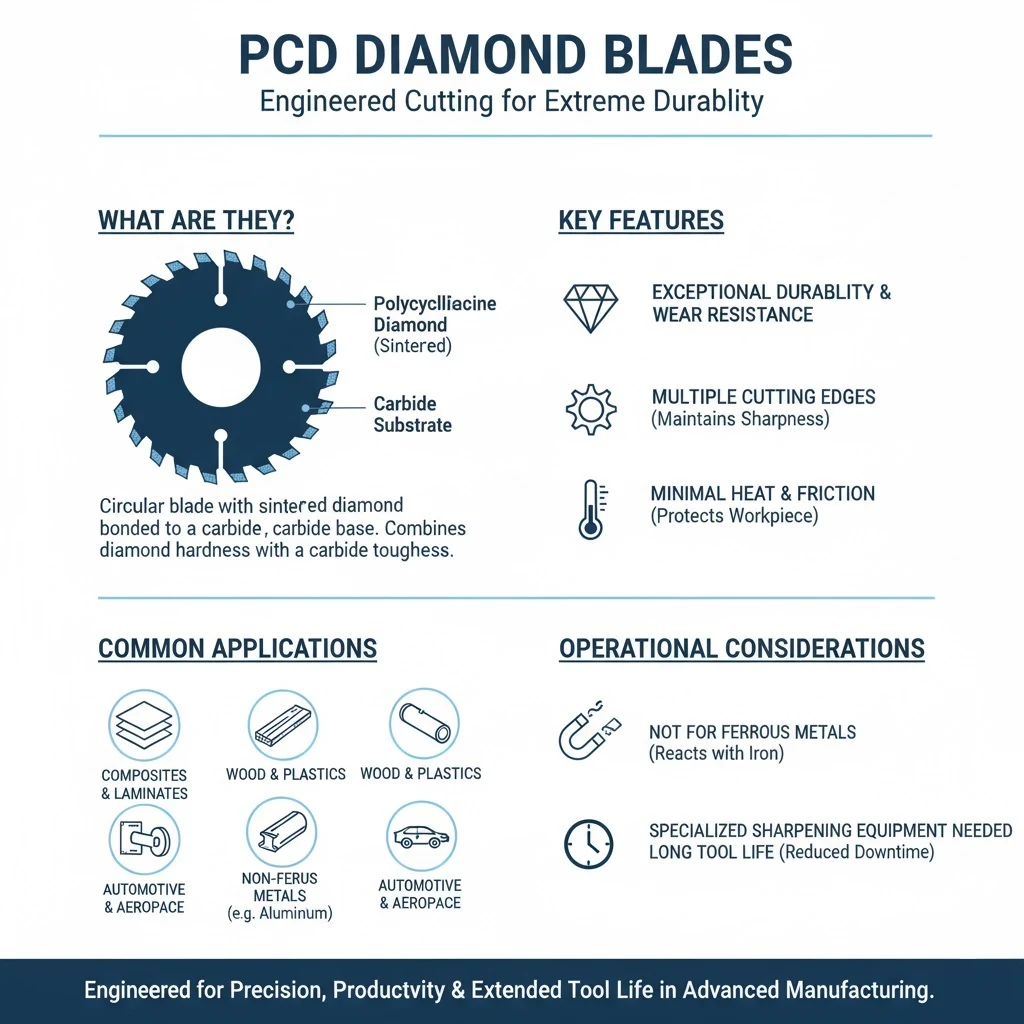
The wear resistance of PCD diamond blades is particularly beneficial in high-volume manufacturing processes, where consistent performance and long tool life are critical to maintaining productivity and reducing downtime. PCD blades are often used in industries such as woodworking, automotive, aerospace, and construction, where they are employed for tasks ranging from precision trimming of composite materials to high-speed machining of aluminum and other non-ferrous metals.
One of the key benefits of PCD diamond blades is their ability to cut materials with minimal heat generation and friction, which helps to preserve the integrity of the workpiece and prevent thermal damage. The toughness of the PCD structure also allows these blades to withstand the impact and stress associated with high-speed cutting operations, reducing the risk of chipping or breakage.
However, while PCD diamond blades are incredibly durable, they are more challenging to sharpen and require specialized equipment for maintenance. Additionally, PCD is not suitable for cutting ferrous metals, as the carbon in the diamond can react with iron at high temperatures, leading to rapid wear and tool degradation.
Abrasive Blades
Abrasive cut off blades are designed for cutting through tough materials such as concrete, brick, masonry, and various metals. Instead of relying on sharp edges, abrasive blades use a combination of hard particles, such as aluminum oxide or silicon carbide, bonded together to grind through the material. These blades are common in construction, demolition, and metalworking industries.
The key feature of abrasive blades is their ability to cut through extremely hard or dense materials that would dull or damage traditional blades. They are particularly effective for cutting tasks that involve stone, tile, or metal pipes. However, abrasive blades wear down as they are used, with the cutting surface gradually being consumed during the process. This means they have a relatively short lifespan compared to other blade types, but their effectiveness in specific applications makes them indispensable.
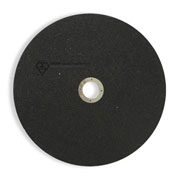
Abrasive blades generate significant heat and dust during cutting, so proper cooling and ventilation are important to maintain performance and safety. They typically operate at lower to medium RPMs, as excessive speed can increase wear and reduce blade life. The choice of RPM depends on the material’s hardness and density, with harder materials requiring slower speeds to avoid excessive heat and wear.
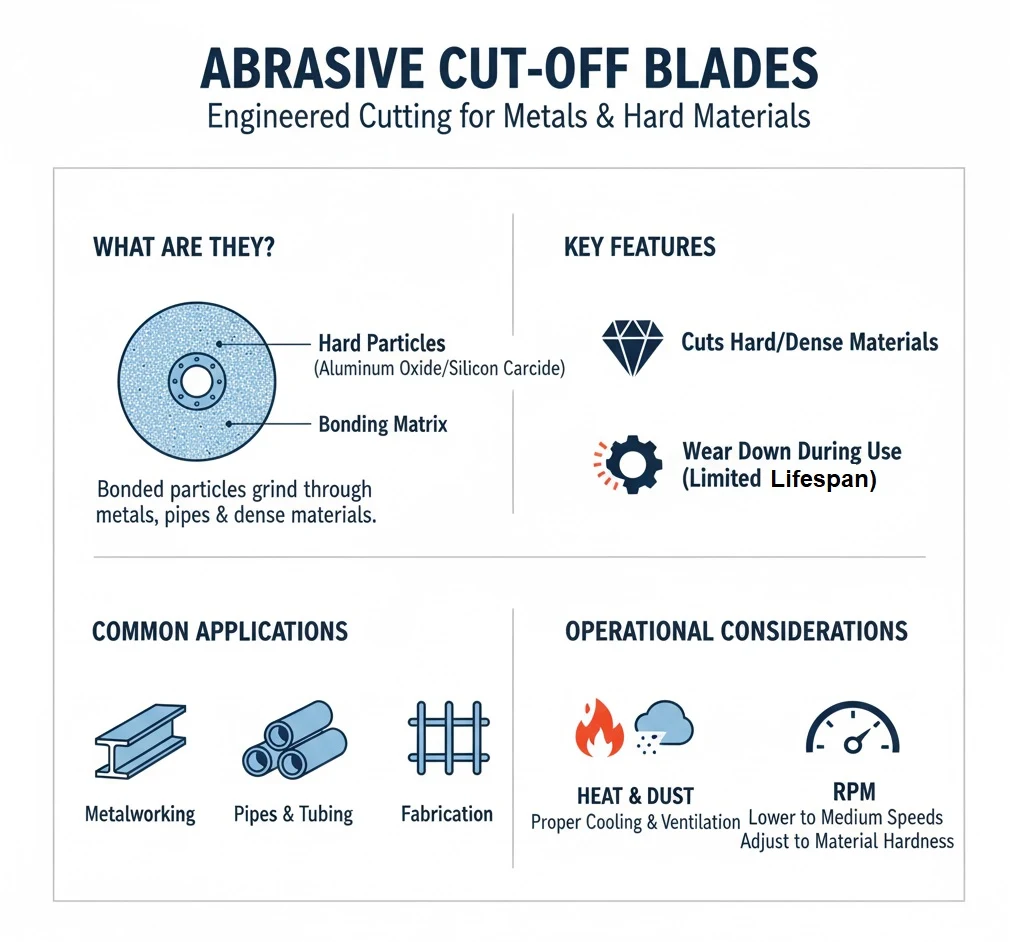
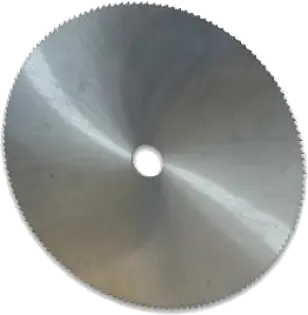
High-Speed Steel Blades
High-speed steel (HSS) blades are made from a special type of steel alloy that is designed to withstand the high temperatures generated during cutting. HSS blades are commonly used for cutting softer metals, wood, plastics, and other materials that do not require the extreme hardness of carbide or the grinding action of abrasive blades.
The primary advantage of high-speed steel blades is their toughness and resistance to heat, which allows them to operate at higher speeds without losing their cutting edge. This makes them ideal for applications where speed and efficiency are important, such as in woodcutting, metal fabrication, and plastic processing.
High-speed steel blades are versatile and can be used for a wide range of cutting tasks. They are less brittle than tungsten carbide blades, making them more forgiving in applications where impact resistance is important. However, they do wear down faster than carbide blades and may need to be sharpened or replaced more frequently.
In terms of RPMs, high-speed steel blades are designed to operate at high speeds, taking full advantage of their heat resistance and toughness. They are particularly effective in applications where high throughput is required, but care must be taken to ensure that the material being cut does not exceed the blade’s capabilities, as this could lead to overheating or premature wear.
Diamond & CBN Blades Compared to Other Blade Types: Tungsten Carbide, Abrasive, & High Speed Steel
Diamond and CBN (Cubic Boron Nitride) blades are some of the most serious advancements of cutting technology. These type of cutting blades provide superior performance compared to tungsten carbide, abrasive, and high-speed steel blades. Known for being the hardest materials, diamond and CBN blades grind away material at the micro and nano scale. This allows them to efficiently cut materials starting from a hardness of 40 on the Rockwell scale and higher, which is a capability that conventional blades struggle to match.
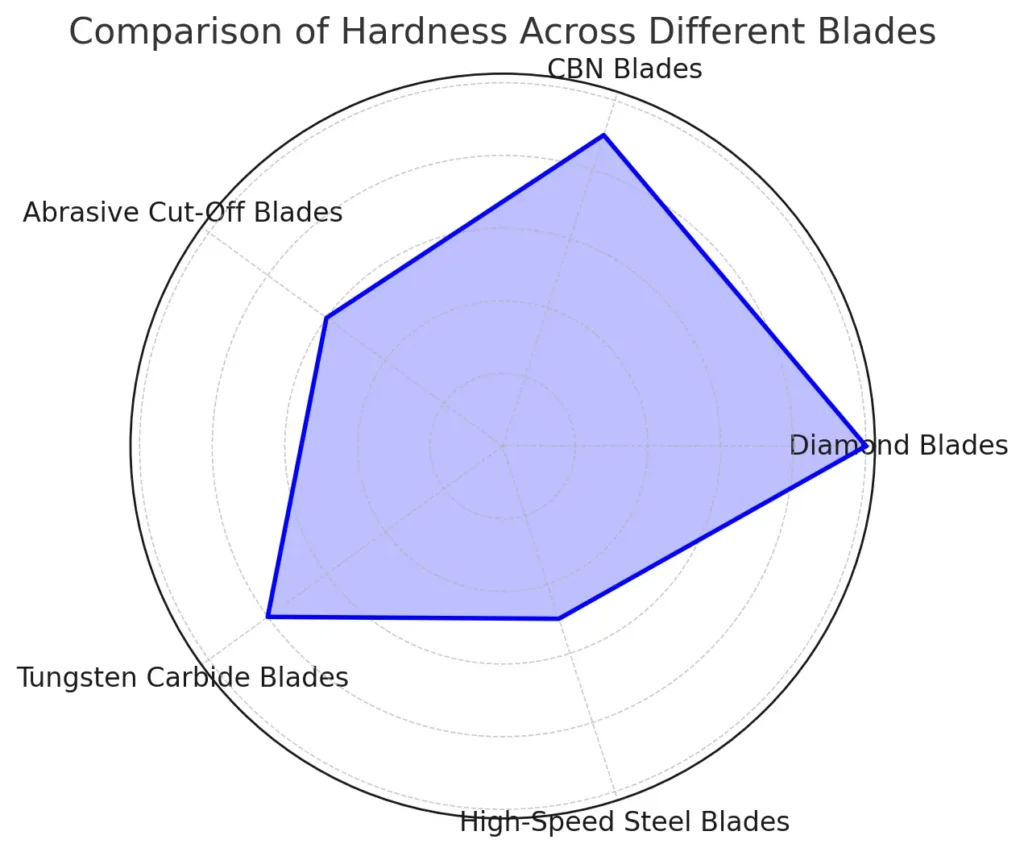
Both diamond and CBN blades excel in cutting the hardest materials, including those that are challenging for traditional abrasives and metal blades. This exceptional ability makes them indispensable in industries requiring utmost precision and efficiency, such as gemstone processing, advanced ceramics manufacturing, and the fabrication of high-tech equipment. Unlike other blades that may tear or excessively wear when faced with tough materials, diamond and CBN blades produce smoother surface finishes. This quality is critical in fields like optics and semiconductor manufacturing, where the finish can directly influence the functionality of the final product.
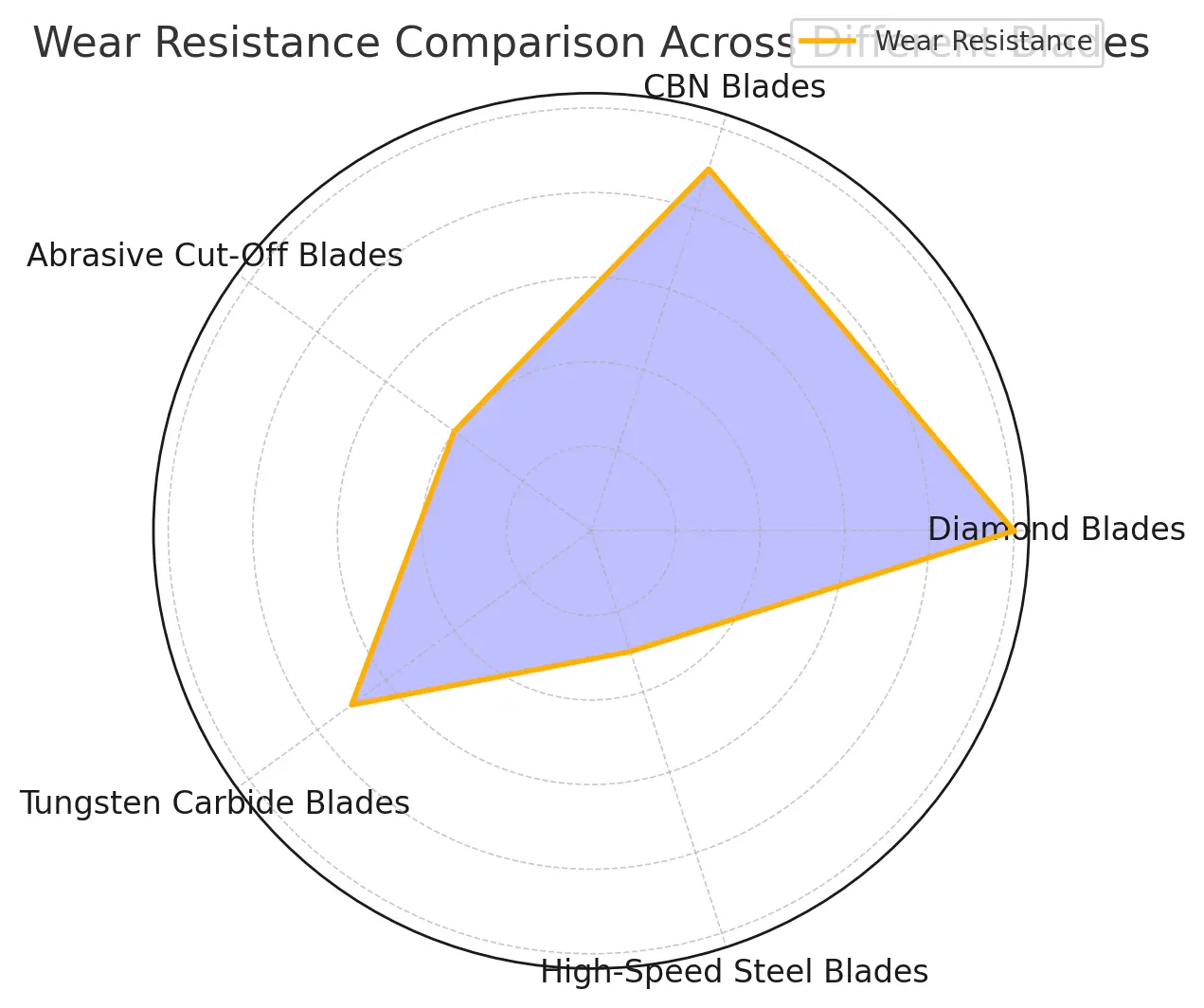
The inherent qualities of diamond and CBN, such as extraordinary wear resistance and natural strength, ensure these blades offer consistent performance over their lifespan. This durability is especially valuable in high-volume production settings, ensuring predictable and reliable results. The longevity of these blades also leads to lower operational costs over time, making them a cost-effective choice despite their higher initial price.
In contrast to carbide or high-speed steel blades, which primarily cut using a sharp edge, diamond and CBN blades grind away material. This method not only minimizes the force exerted on the material, thereby reducing the risk of damage, but also enhances the overall cutting process. Diamond’s superior thermal conductivity, and similarly CBN’s, helps efficiently dissipate heat during cutting operations, protecting both the blade and the material from thermal damage.
Versatility is another significant advantage of diamond and CBN blades. They are not confined to cutting but are also excellent for grinding and shaping a variety of materials. From delicate operations in jewelry making to robust construction materials cutting, these blades prove effective in a wide array of applications.
Diamond and CBN blades are exceptionally suited for a broader range of materials and applications compared to other types like tungsten carbide, abrasive, and high-speed steel blades. Their versatility stems from their unmatched hardness and excellent thermal conductivity, allowing them to operate efficiently across a diverse array of cutting scenarios.
Diamond and CBN blades not only surpass tungsten carbide, abrasive, and high-speed steel blades in cutting performance and durability, but also offer significant environmental and safety advantages. Both diamond and CBN are materials that reduce waste due to their longevity and efficiency.
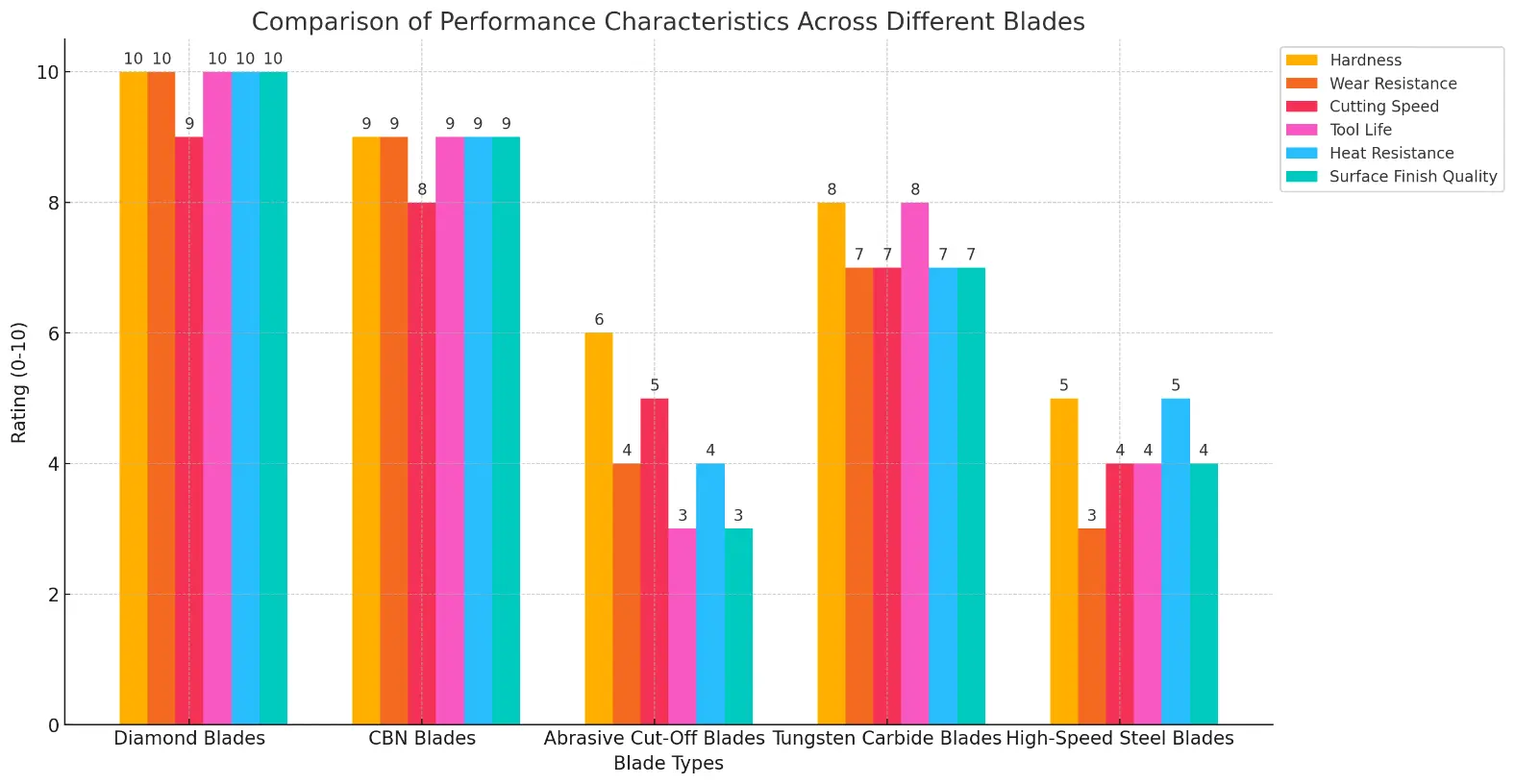
The prolonged life span of these blades means fewer blade changes and less material waste generated during the cutting process. This attribute aligns well with sustainable manufacturing practices, helping industries reduce their environmental footprint by minimizing the disposal of used blades and the energy consumption associated with the manufacturing of replacements.
Advantages:
-
 Cross-application capabilities
Cross-application capabilities
-
 Superior long life
Superior long life
-
 More consistency in performance
More consistency in performance
-
 More durability
More durability
-
 Less material deformation
Less material deformation
-
 Lower tool costs relative to work done
Lower tool costs relative to work done
-
 Faster cutting that lowers labor costs
Faster cutting that lowers labor costs
-
 Increased production
Increased production
-
 Less power consumed and less strain on machinery
Less power consumed and less strain on machinery
-
 Less waste due to excessive breakage or inability to control production tolerances
Less waste due to excessive breakage or inability to control production tolerances
-
 Smoother cutting that may eliminate further finishing
Smoother cutting that may eliminate further finishing
-
 Nearly constant blade diameter and cutting ability throughout blade life
Nearly constant blade diameter and cutting ability throughout blade life
-
 Minimal chipping
Minimal chipping
-
 Minimal machining noise
Minimal machining noise
-
 Minimal tool dressing / diamond re-exposure
Minimal tool dressing / diamond re-exposure
Comparison Table For Different Types of Cutting Blades
|
Parameter |
Diamond Blades |
CBN (Cubic Boron Nitride) Blades |
Abrasive Cut-Off Blades |
Tungsten Carbide Blades |
High-Speed Steel (HSS) Blades |
|---|---|---|---|---|---|
|
Material Composition |
Made of diamond, the hardest naturally occurring material |
Made of cubic boron nitride, second hardest material |
Typically made from a composite of abrasive materials like aluminum oxide or silicon carbide |
Made of tungsten carbide, a very hard and dense material |
Made from high-speed steel, less hard than tungsten carbide |
|
Hardness |
Extremely hard, capable of cutting the hardest materials |
Very hard, suitable for cutting hard materials such as hardened steels and nickel-based alloys |
Hard, but tends to wear faster than diamond or CBN |
Very hard, suitable for cutting hard and abrasive materials |
Less hard, suitable for softer materials |
|
Wear Resistance |
Very high wear resistance, lasts longer than most other blades |
High wear resistance, though slightly less than diamond |
Lower wear resistance, requires more frequent replacement |
High wear resistance, but can be brittle |
Lower wear resistance, suitable for applications without extensive wear |
|
Cutting Speed |
Very high cutting speeds are possible |
High cutting speeds, slightly lower than diamond |
Moderate cutting speeds |
Moderate to high cutting speeds, depending on the material |
Lower cutting speeds compared to carbides and diamond |
|
Applications |
Ideal for cutting very hard materials like ceramics, glass, and stone |
Used for metals that are difficult to cut with other materials, including high-alloy steels |
Commonly used for cutting metals and materials that do not require a fine finish |
Often used in woodworking, metalworking for hard materials |
Used in general-purpose cutting applications on softer materials |
|
Cost |
Highest among the listed types |
High, generally lower than diamond but higher than most others |
Lowest among the listed types, making them cost-effective for many applications |
Higher than HSS but may approach diamond depending on the application |
Most cost-effective for a wide range of applications |
|
Finish Quality |
Provides a very smooth finish |
Provides a smooth finish, suitable for precision applications |
Generally provides a rougher finish compared to diamond or CBN |
Good finish, better than HSS but not as fine as diamond or CBN |
Provides a satisfactory finish, not suitable for precision cuts |
|
Heat Resistance |
Excellent heat resistance, does not degrade quickly |
Excellent heat resistance |
Moderate heat resistance, may degrade under high temperatures |
Good heat resistance |
Moderate heat resistance, can lose temper at higher temperatures |
|
Flexibility in Use |
Less flexible, primarily used for specific high-hardness applications |
Less flexible, best used for specific metal-cutting applications |
More flexible, used widely in various cutting operations |
More flexible than diamond, used in a variety of cutting operations |
Highly flexible, used in a wide range of applications |
|
Tool Life |
Longest, due to high durability and wear resistance |
Long, but generally shorter than diamond |
Shorter than diamond, CBN, and carbide blades due to higher wear rate |
Longer than HSS, depending on usage |
Shorter compared to diamond and carbide, varies widely based on application |
|
Compatibility with Coolants |
Generally high, as coolants can help reduce the risk of thermal damage |
Generally high, especially necessary when cutting hard metals |
Moderate, depends on the specific abrasive material used |
High, as coolants help prevent overheating and extend blade life |
Moderate, especially beneficial in extending tool life and improving cuts |
Blade Outside Diameter
When selecting a diamond or CBN blade, the outside diameter (OD) is a critical factor that influences many aspects of cutting performance. Diamond and CBN blades typically have outside diameters ranging from as small as 0.5 inches (12.7 mm) to as large as 48 inches (1,219 mm) or more for specialized applications. These diameters are carefully chosen based on the specific needs of the application, the properties of the material being cut, and the capabilities of the cutting machine.

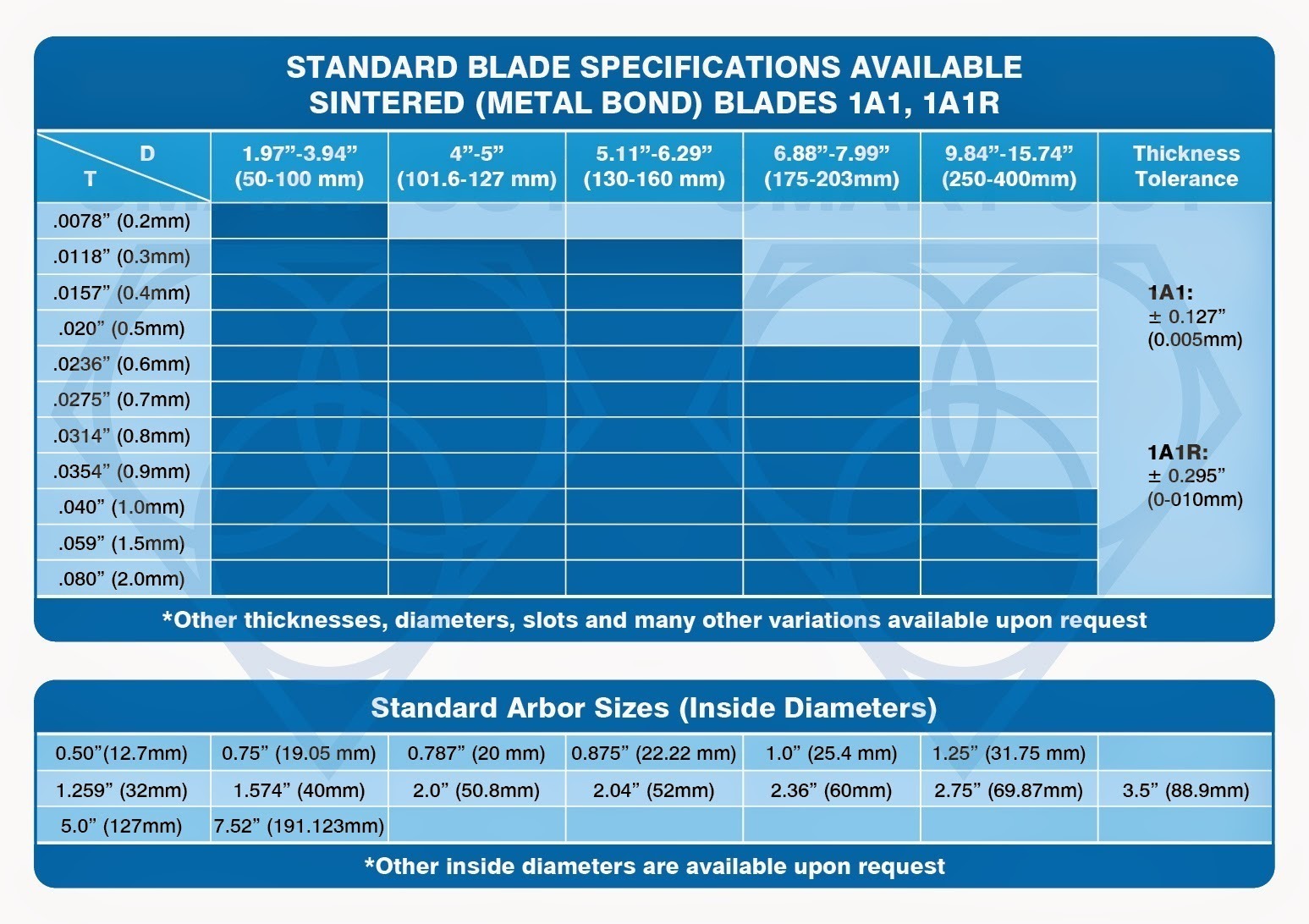
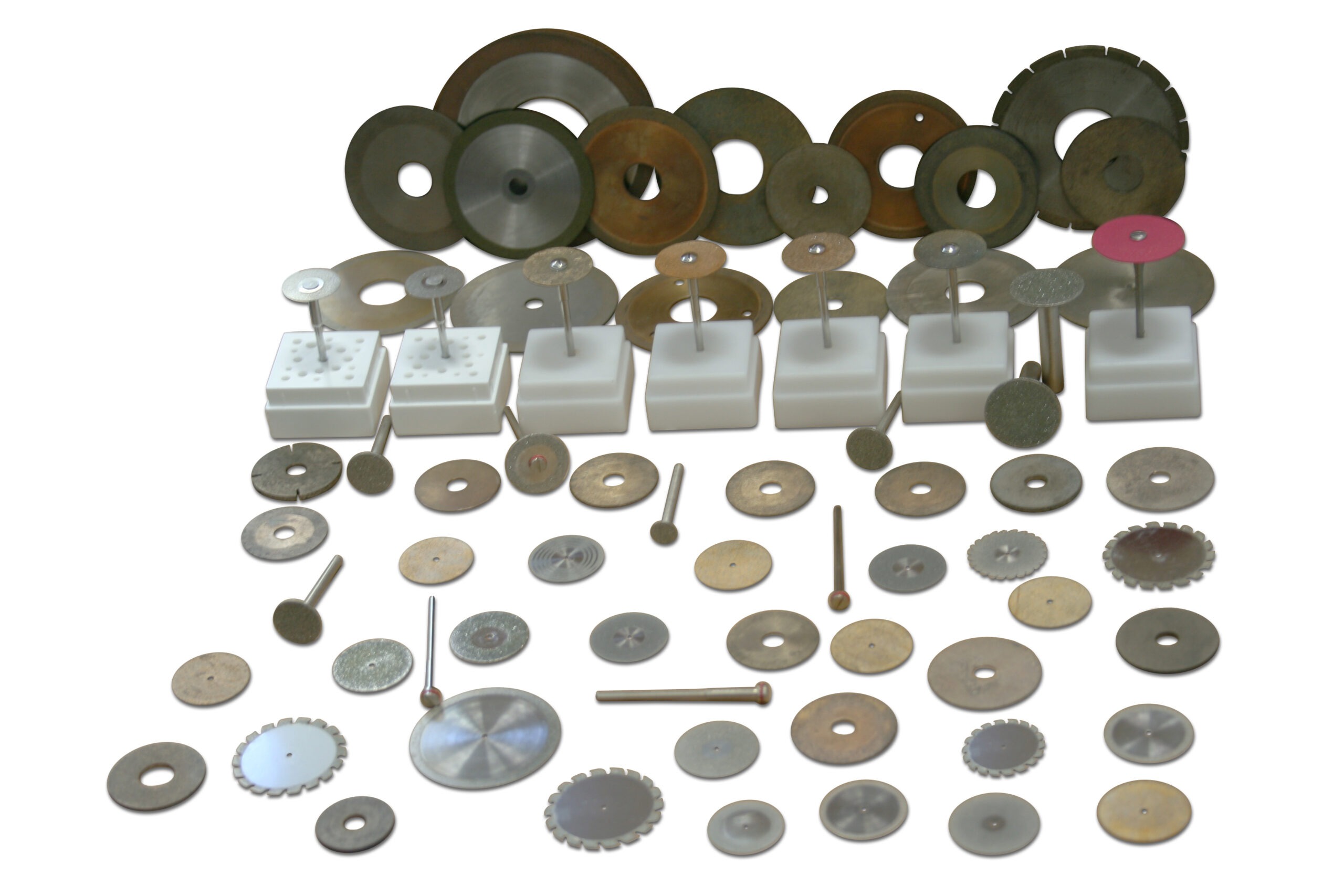
Smaller Diamond & CBN Blade Diameters
Smaller diameters, typically ranging from 0.5 inches to 4 inches, are often used in slicing, dicing, trimming, slotting, grooving of micro and precision applications such as microelectronics, advanced ceramics, and precision optics. These small blades allow for intricate and detailed cuts with high precision and minimal material waste. These are typically used on large variety of dicing saws, low and high speed saws, hand held tools such as Dremel, etc.
Medium Diamond & CBN Blade Diameters
Larger diameter diamond & cbn blades are usually considered to be between 4” (100mm) to 14” (350mm) diameter. These sizes are common in industrial sectors like automotive, aerospace, and general manufacturing, offering a balance between cutting capacity and machine compatibility.
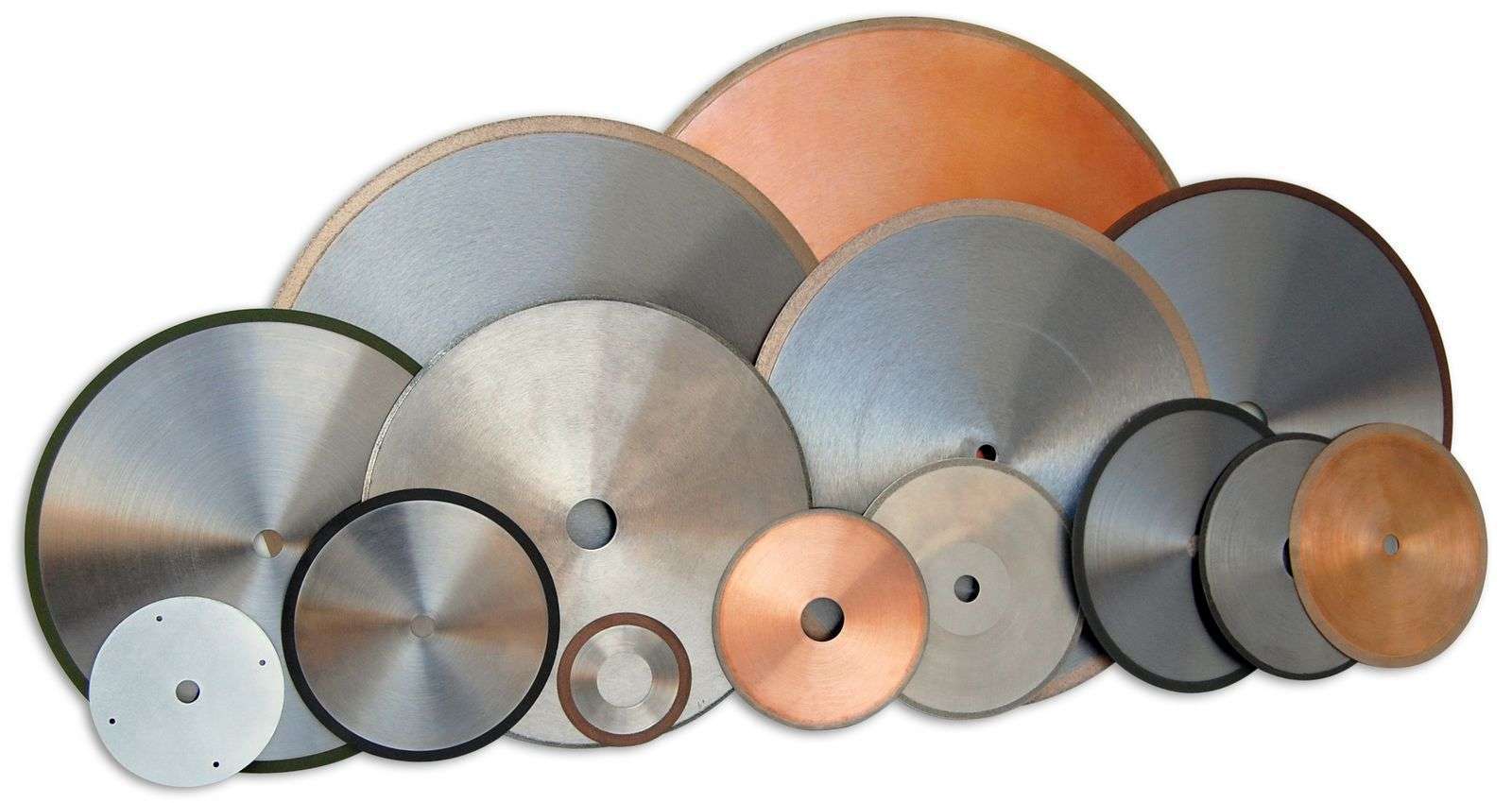
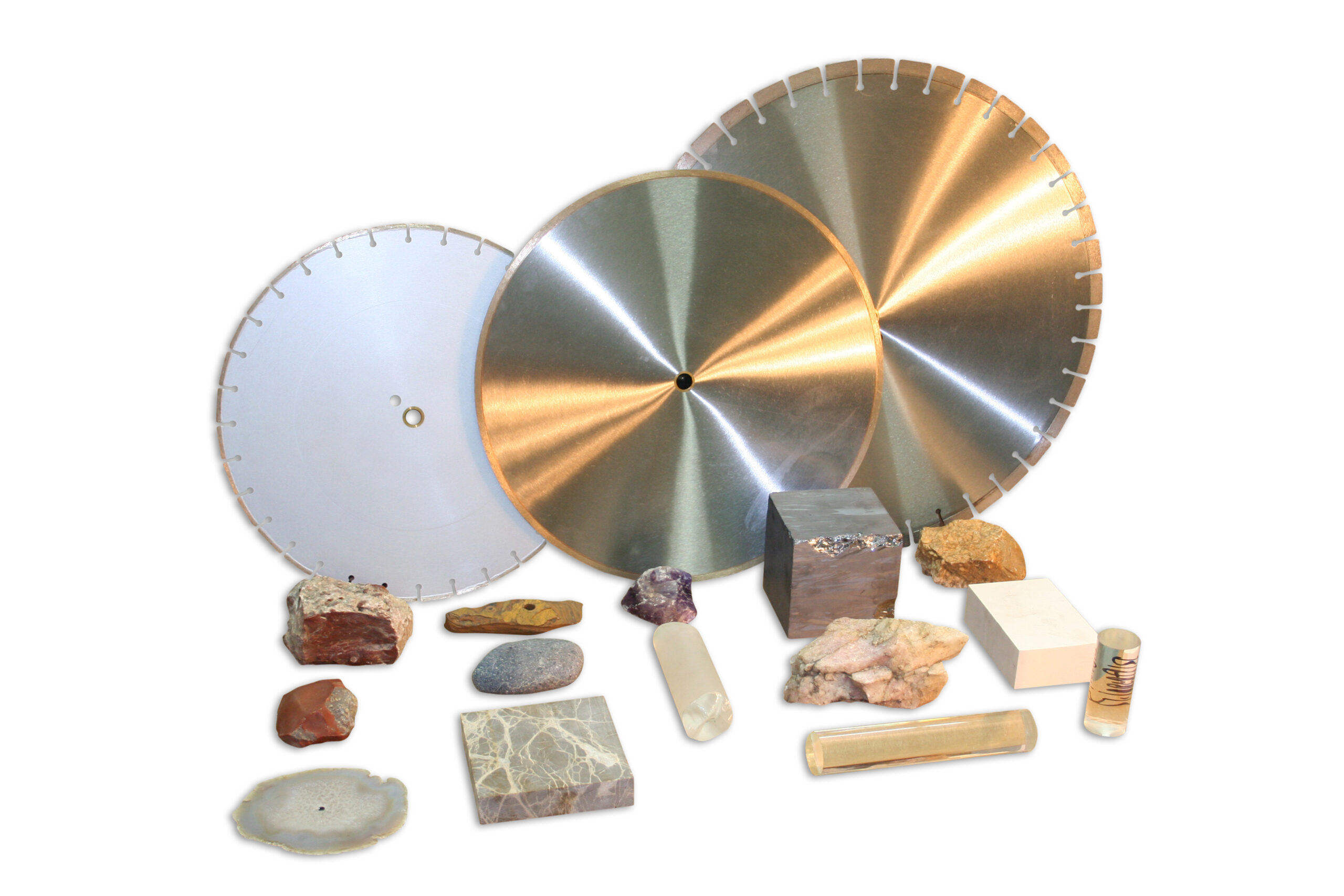
Large Diamond & CBN Blade Diameters
For large-scale or heavy-duty cutting and slabbing of larger diameter of materials typically most people use 16” (400mm) to 48”. These larger blades are used in stone, semi precious stone, construction, mining, glass, semiconductor and other industries where cutting large or dense materials is necessary.
The outside diameter of a blade is crucial because it directly affects several key factors, including cutting depth, surface speed, stability, machine compatibility, and blade wear. A larger diameter allows for deeper cutting capability, which is important for applications like slab sawing or trenching, while smaller diameters are better suited for shallow, precise cuts. Surface speed, or the speed at which the blade's edge moves through the material, is also influenced by the OD. Larger blades generate higher surface speeds at the same RPM, which can improve cutting efficiency but may also lead to overheating and increased wear if not properly managed.
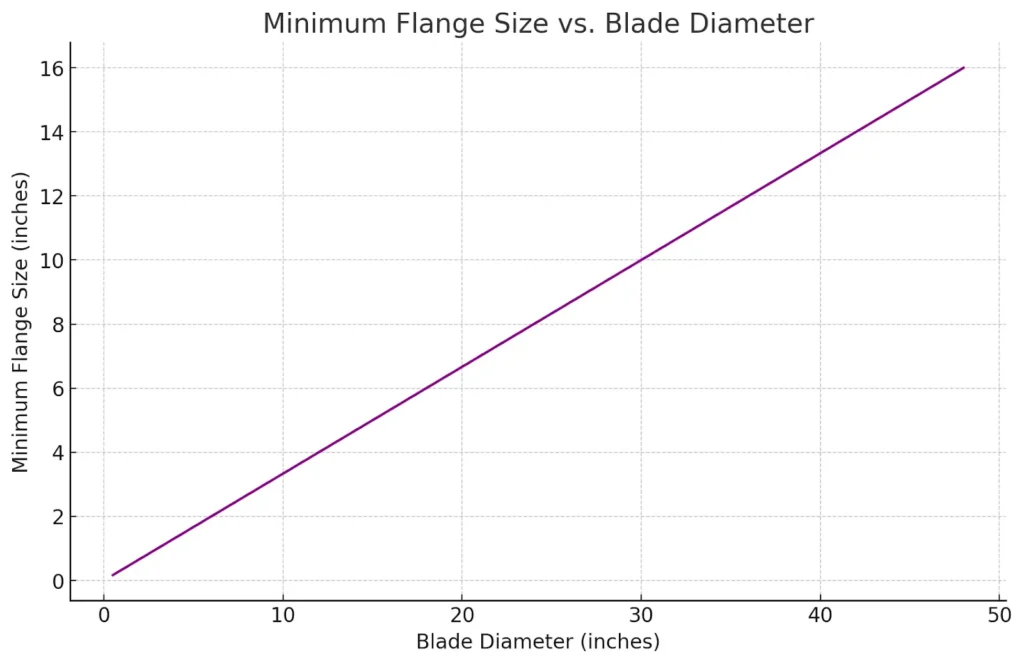
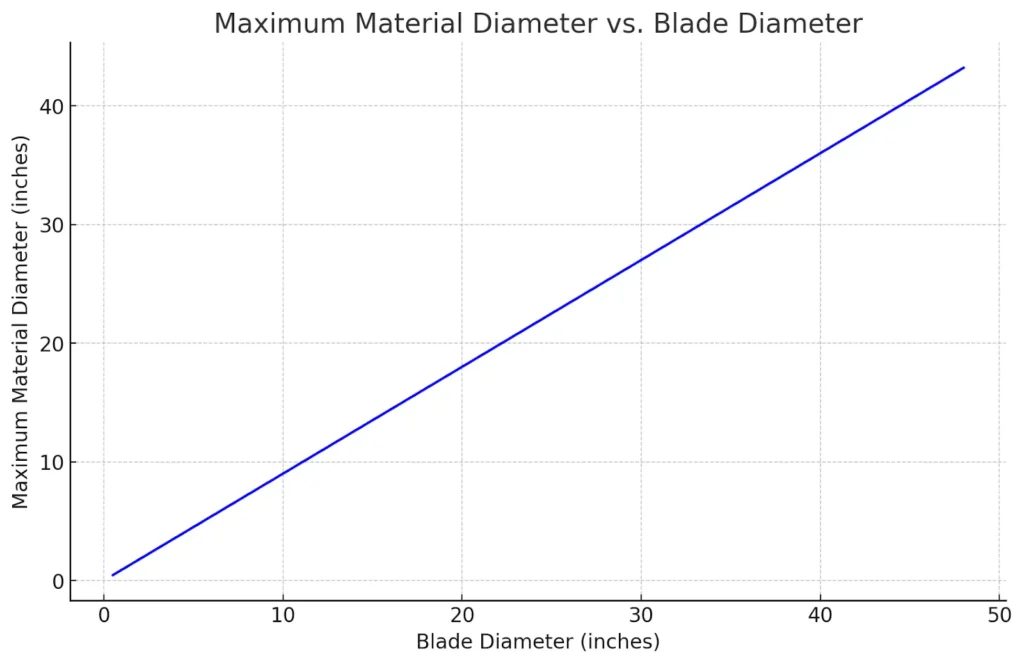
Stability is another important consideration. Larger blades are more prone to vibration and instability, particularly if the blade is thin relative to its diameter. This can lead to inaccuracies, increased wear, and potential blade damage. Smaller blades, by contrast, generally offer better stability, allowing for precise cuts with minimal vibration. Additionally, the OD must be compatible with the cutting machine's spindle and power capacity. Larger blades require more powerful machines with appropriate spindle sizes, while smaller blades are more versatile and can be used on a wider range of machines.
Blade wear is often distributed over a larger area in large diameter blades, potentially extending the blade’s lifespan. However, the wear rate also depends on factors such as material hardness, cooling, and blade speed. Smaller blades, with a more concentrated wear area, might wear out faster in high-demand applications, but they are easier to control and replace.
The OD of a blade is also closely linked to other blade attributes such as thickness, segment design, and cutting speed. Largest diameter continuous rim blades can be produced are 20” (500mm) diameter. Larger blades would have to be produced with segments. The spacing between the segments can be controlled. The smaller the spacing/distance between segments the better the cut quality. Larger spacing between segments the faster the cutting speed.
Larger diameter blades often require thicker designs to maintain stability during cutting, while smaller blades are thinner to allow for precision and minimal material loss. Segment design and bonding must also be adjusted for larger diameters to manage heat and wear, with more aggressive bonds or additional cooling slots often necessary. Cutting speed and feed rate are also influenced by OD; larger blades allow for faster feed rates due to higher edge speeds, but this must be balanced against the material properties to avoid overheating and excessive wear.
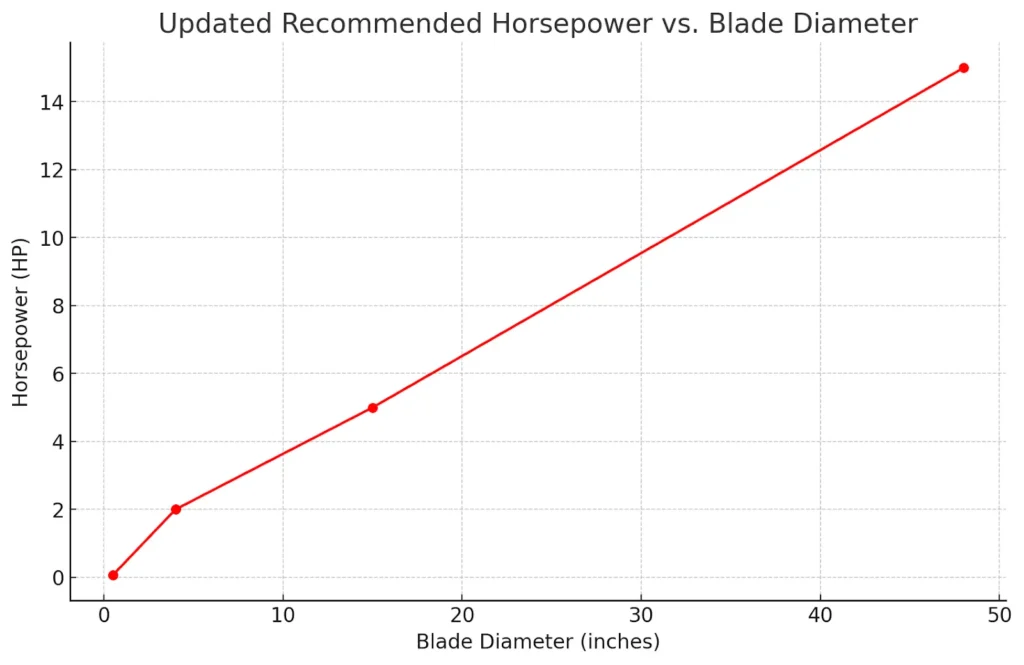
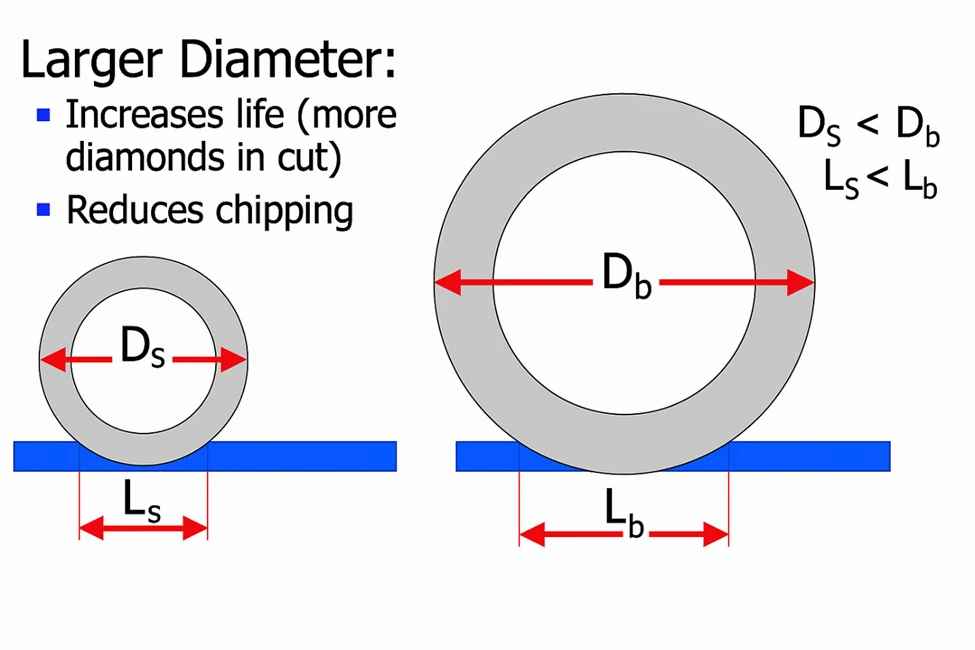
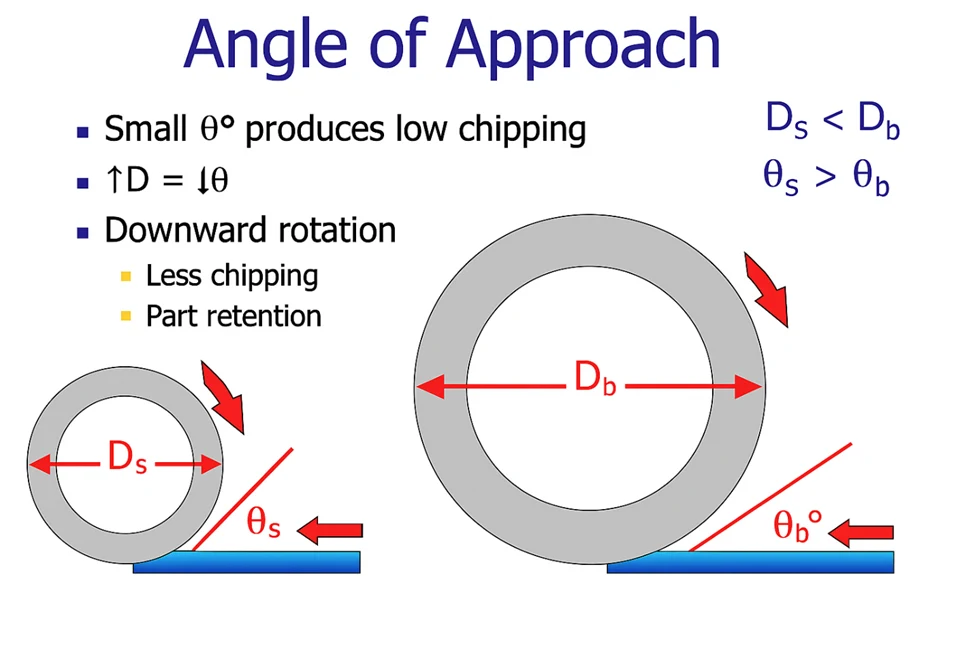
|
Blade Diameter Category |
Typical Applications |
Key Performance Factors |
Machine Compatibility |
Stability Considerations |
Wear Characteristics |
|---|---|---|---|---|---|
|
Small (0.5" to 4") |
Microelectronics, advanced ceramics, precision optics |
High precision, minimal material waste |
Used on dicing saws, handheld tools (e.g., Dremel) |
High stability, minimal vibration |
Faster wear due to concentrated area |
|
Medium (4" to 14") |
Automotive, aerospace, general manufacturing |
Balance between cutting capacity and precision |
Compatible with a wide range of industrial machines |
Moderate stability, suited for deeper cuts |
Moderate wear, balance between precision and durability |
|
Large (16" to 48") |
Stone, construction, mining, glass, semiconductor |
Deep cutting capability, high surface speed |
Requires powerful machines with large spindles |
Prone to vibration and instability, especially if thin relative to diameter |
Wear distributed over a larger area, potential for extended lifespan |
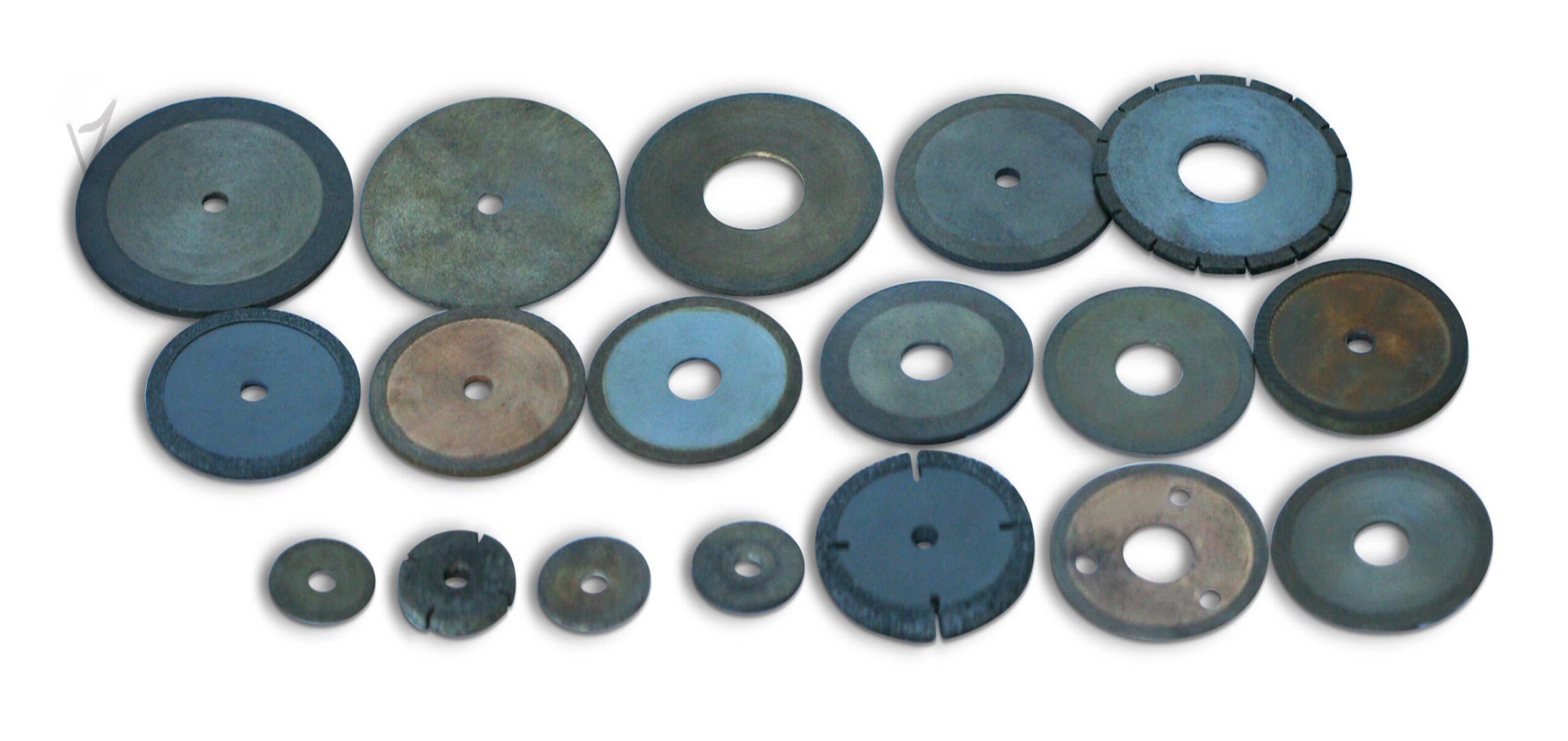
Inside Diameter (Arbor Size)
The inside diameter, or arbor size, of a diamond or CBN blade is another critical factor that significantly impacts the blade's performance and compatibility with cutting equipment. The arbor size refers to the diameter of the hole in the center of the blade that fits onto the spindle of the cutting machine. Different type of cutting equipment have different type of arbor sizes. Common arbor sizes range from as small as 5/8 inch (15.875 mm) to larger diameters like 1 inch (25.4 mm), 1.0” (25.4mm) 1.25 inches (31.75 mm), 32mm or even 2 inches (50.8 mm) and beyond for industrial and specialized equipment.
Arbor size is important because it directly influences the blade's stability during operation, its compatibility with the cutting machine, and the overall safety and efficiency of the cutting process. A properly matched arbor size ensures that the blade fits securely on the spindle, which is essential for maintaining balance and preventing vibration during cutting. If the arbor size is too large or too small for the spindle, it can result in wobbling, uneven cuts, or even blade breakage, posing a significant safety risk.
The choice of arbor size also depends on the specific application and the type of cutting machine being used. Smaller arbor sizes, such as 5/8 inch or 1 inch, are typically used in on large variety of tile saws, masonry saws, trim saws, slabbing saws, handheld saws, benchtop machines, and other portable cutting tools. These sizes are sufficient for smaller blades and lighter-duty applications where precision and maneuverability are important.
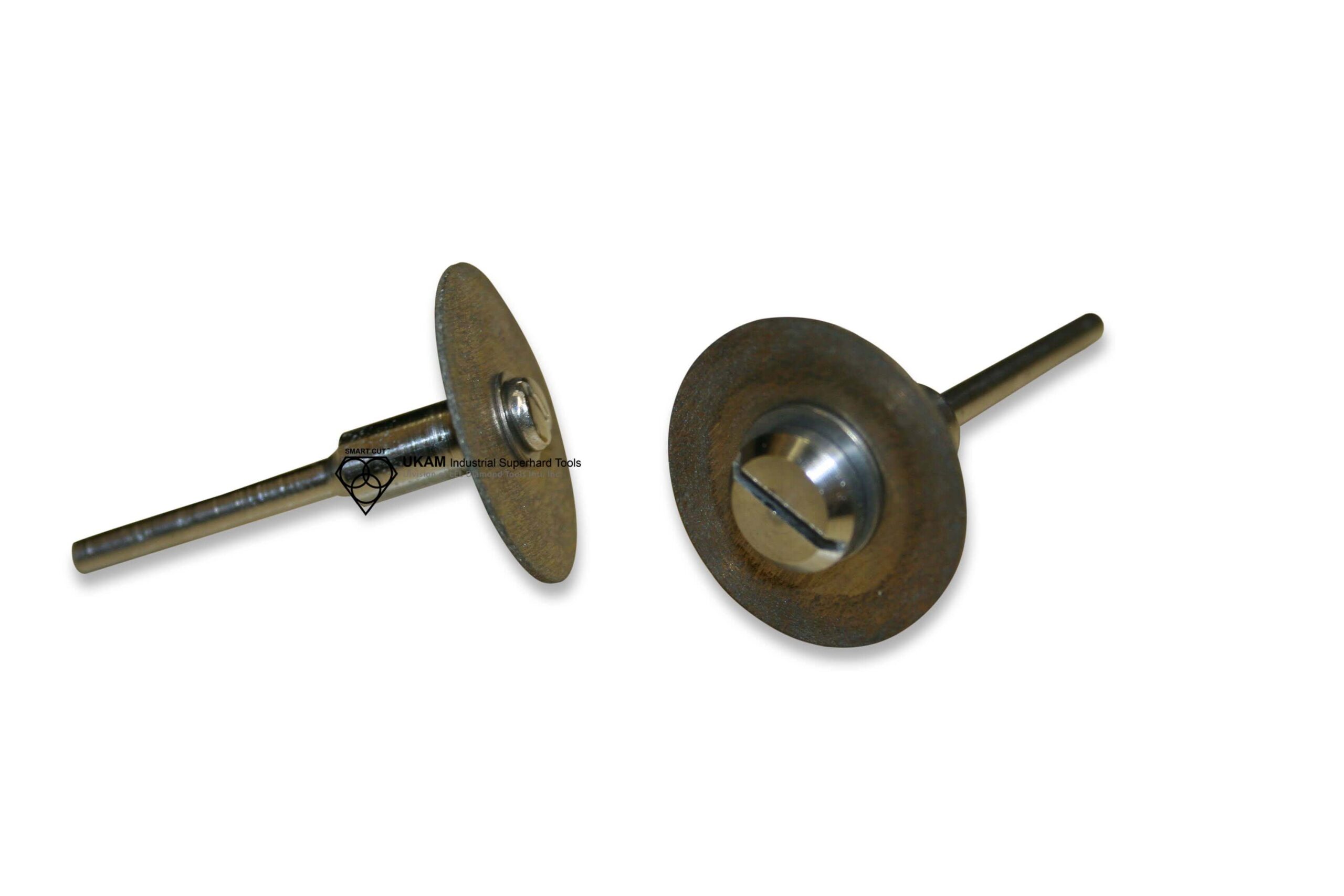
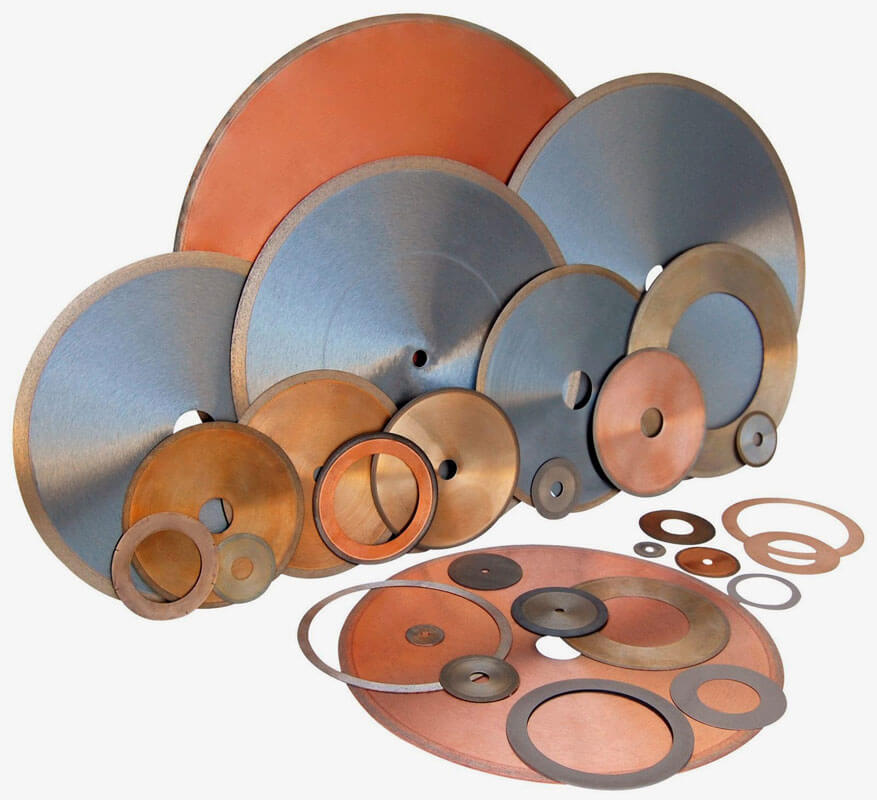
Larger arbor sizes, like 1.25 inches or more, are common in industrial-grade equipment designed for heavy-duty cutting tasks. Such as surface grinders, abrasive cut off saws. These larger arbors provide the necessary support and stability for larger blades, which are often subjected to greater forces during cutting.
Larger diameter inside diameters are usually used for gang sawing operation. Some of the more common gang arbor sizes include 2.75”, 3.5”
Most of the inside diameter of most of our diamond and cbn blades can be machines same day to almost any size if needed. Also most blades can be bushed to almost any size as well.
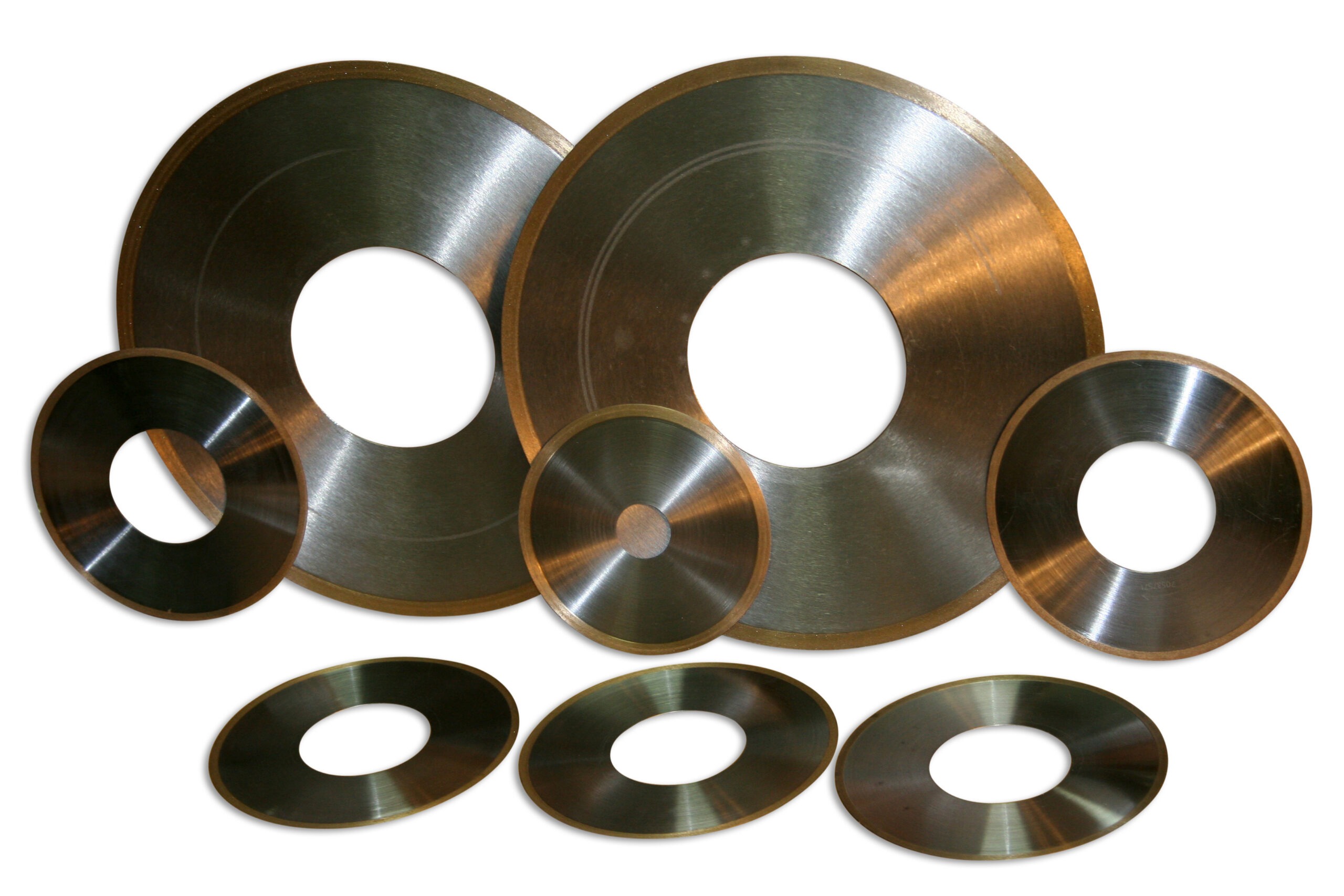
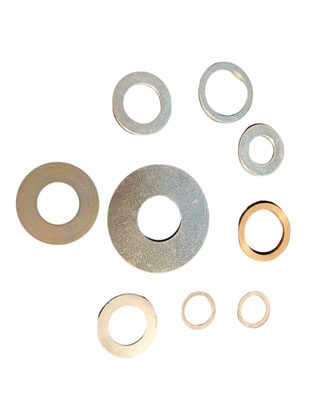
In addition to stability, the arbor size also affects the ease of blade installation and removal. A well-matched arbor size allows for quick and secure mounting of the blade, minimizing downtime and ensuring that the blade can be easily replaced when worn. For machines that are used frequently or in high-production environments, selecting the correct arbor size can contribute to more efficient operations and reduced maintenance time.
At the same time, the arbor size should be considered in conjunction with other blade attributes such as outside diameter, thickness, and diamond section designed (continuous rim, slotted, or segmented) design. For instance, larger blades with thick kerf thickness often require larger arbors to provide adequate support and maintain balance during high-speed operations. Conversely, smaller, thinner blades may work well with smaller arbors, where precision cutting and minimal vibration are the primary concerns.
|
Arbor Size Category |
Typical Applications |
Stability & Safety |
Compatibility & Installation |
Impact on Blade Attributes |
|---|---|---|---|---|
|
Small (5/8", 1") |
Tile saws, masonry saws, trim saws, handheld saws, benchtop machines |
High precision, minimal vibration, increased safety risks if mismatched |
Easily compatible with portable and lighter-duty machines, quick mounting and removal |
Suited for smaller, thinner blades requiring precision |
|
Medium (1.25", 32mm) |
General industrial machines, such as some grinders and medium-duty saws |
Moderate stability, essential for medium-scale operations |
Requires tools with appropriate spindle size, straightforward blade changes |
Adequate for medium blades, balancing support and flexibility |
|
Large (2" and beyond) |
Heavy-duty equipment like large surface grinders, abrasive cut off saws |
Enhanced stability necessary for handling larger forces, reduces vibration significantly |
Needs heavy-duty machines with large spindle capacities, may complicate blade changes |
Essential for large blades with thick segments, supports high-speed operations |
Diamond & CBN Kerf Thickness
Diamond and CBN cutting blades have a kerf thickness that typically ranges from as thin as 10 microns (thinner than .001”) to as wide as .250” (6.35mm). The kerf thickness generally increases with the blade diameter, proportionally adjusting to the blade’s size. The kerf represents the width of the cut made by the blade, essentially the amount of material removed as the blade passes through the material. The importance of kerf thickness cannot be overstated, as it directly affects cutting efficiency, material waste, and overall blade performance.

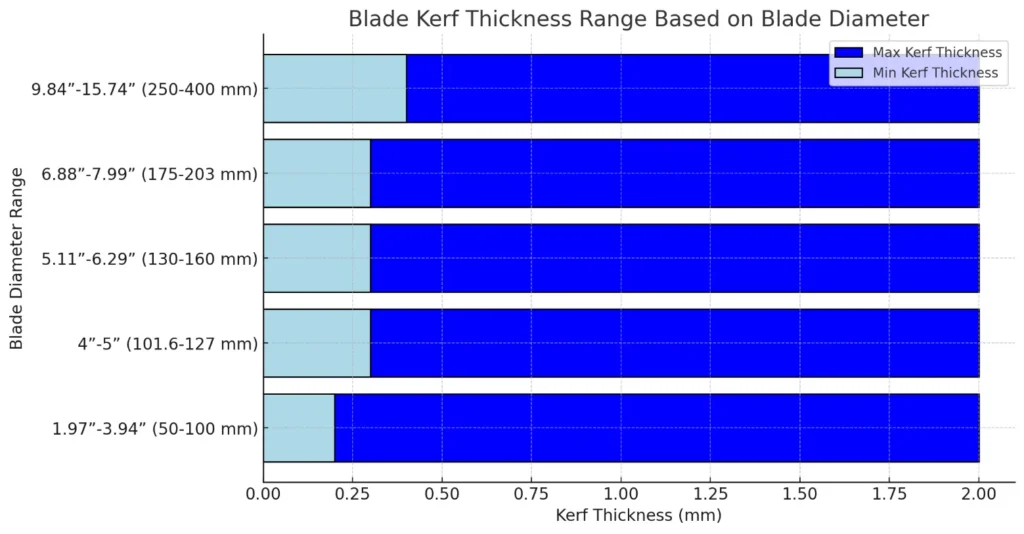
Selecting the optimal blade thickness for your specific material or application involves considering a wide array of factors. These include the desired cutting speed, the load or feed rate, and the diameter, thickness, hardness, density, and shape of the material being cut. Additionally, the skill and experience level of the operator play a significant role in determining the appropriate kerf thickness. Thicker diamond or CBN blades offer greater rigidity, allowing them to withstand higher loads and feed rates without flexing or wobbling. This rigidity also makes them more durable and forgiving when it comes to operator error or misuse. As a result, thicker kerf blades are particularly well-suited for environments where multiple users share the same equipment, such as in educational settings or large production facilities. These blades are ideal for less experienced or novice saw operators, including students and beginners, as they provide a greater margin of error and reduce the risk of blade damage during use.
On the other hand, thinner kerf blades are designed for applications where precision is important. They minimize material loss and are often used in high-precision industries such as microelectronics, optics, and advanced materials research. However, these thinner blades require careful handling and expert operation to avoid deflection and to maintain accuracy. They are best suited for experienced users who can manage the delicate balance between cutting speed, feed rate, and material properties.
|
Attribute/Variable |
Correlation to Kerf Thickness |
|---|---|
|
Blade Diameter |
Larger blade diameters generally require thicker kerf to maintain stability and prevent deflection. |
|
Material Hardness |
Harder materials may necessitate thicker kerfs to reduce blade flexing and ensure a clean cut. |
|
Material Thickness |
Thicker materials often benefit from a thicker kerf to handle the increased load and maintain cutting accuracy. |
|
Cutting Speed |
Higher cutting speeds can be supported by thicker kerf blades, which provide greater stability and durability. |
|
Feed Rate |
Higher feed rates may require thicker kerfs to withstand the increased force and prevent blade deflection or breakage. |
|
Material Density |
Dense materials can exert more pressure on the blade, so a thicker kerf may be needed to handle the load effectively. |
|
Material Shape |
Irregular or complex shapes might require a thicker kerf for added stability during cutting to avoid deflection or error. |
|
Operator Skill Level |
Less experienced operators benefit from thicker kerfs, which are more forgiving to operator error and reduce the risk of blade damage. |
|
Application Precision |
High-precision applications often use thinner kerfs to minimize material loss and achieve finer cuts. |
|
Blade Rigidity |
Thicker blades, with thicker kerfs, provide greater rigidity, reducing the risk of wobbling or bending during cutting. |
|
Cut Quality |
Thicker kerfs can produce rougher cuts, while thinner kerfs typically offer finer, more precise finishes. |
|
Material Cost |
Expensive materials may favor thinner kerfs to reduce waste, while more affordable materials might tolerate thicker kerfs. |
|
Blade Wear Rate |
Thicker kerf blades distribute wear over a larger surface area, potentially extending blade life compared to thinner kerfs. |
Diamond & CBN Blade RPM’s
When using diamond or CBN blades, understanding the appropriate blade speed, measured in revolutions per minute (RPM), is crucial for optimizing cutting performance, blade longevity, and overall operational efficiency. The RPM at which a blade operates significantly impacts the quality of the cut, the wear rate of the blade, and the safety of the operation.
Blade diameter and RPM are inversely related: as the blade diameter increases, the RPM should decrease to maintain the correct surface speed—the speed at which the blade’s cutting edge moves through the material. This surface speed, often expressed in meters per second (m/s), is critical for effective cutting. If the RPM is too high for a large blade, it can generate excessive heat, leading to blade warping, material damage, and increased wear. Conversely, if the RPM is too low for a small blade, it may result in inefficient cutting, increased cutting time, and potential blade stalling.

For example, smaller blades with diameters ranging from 0.5” to 2” (12.7-50 mm) typically operate at higher RPMs, often between 15,000 to 30,000 RPM, allowing for the high surface speeds necessary for fine, precision cuts in delicate materials. As blade diameter increases, such as in blades ranging from 4” to 5” (101.6-127 mm), the RPM decreases to a range of 6,000 to 18,000 RPM to ensure safe and effective cutting. For large blades, such as those with diameters of 30” to 48” (762-1220 mm), the RPM can drop significantly, ranging from 500 to 2,000 RPM, as these blades are used for heavy-duty cutting tasks that require lower speeds to manage the forces involved and maintain stability.
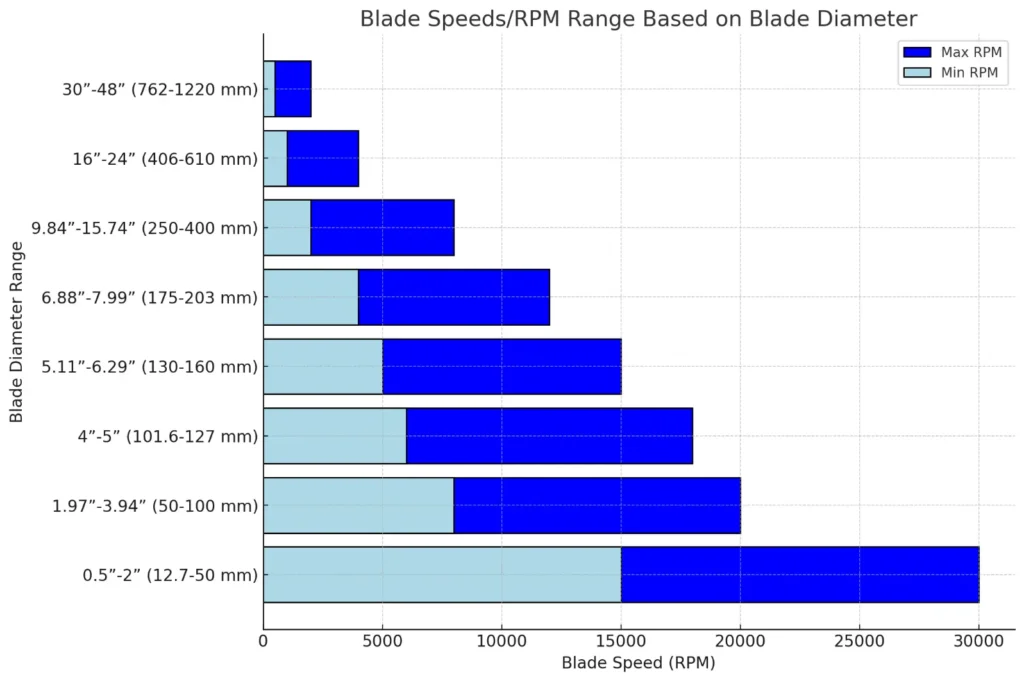
This chart provides a comprehensive visual guide to selecting the appropriate RPM for different blade diameters, helping to ensure optimal performance and safety in your cutting applications.
Several factors influence the selection of the appropriate RPM for diamond and CBN blades. The type and hardness of the material being cut are important—harder materials like ceramics or hardened steels generally require lower RPMs to avoid overheating and ensure a controlled, efficient cut. Material thickness and density also play a role; thicker or denser materials often necessitate lower RPMs to prevent excessive resistance or heat buildup. The desired cut quality is another important consideration—high-quality surface finishes often require precise control over RPM, with slower speeds necessary for intricate cuts or when a smooth finish is critical.
Diameter, kerf thickness, Blade bond type and diamond edge design also influence RPM selection. Blades with harder bonds or specialized segment designs can often withstand higher RPMs, while softer bonds may require lower speeds to prevent rapid wear. Machine capabilities must also be considered—machines with higher horsepower can maintain consistent RPMs under heavy loads, allowing for more flexibility in selecting blade speed. However, it’s essential to match the blade’s capabilities with the cutting machine specifications to avoid damage. Coolant use can also influence RPM by reducing friction and heat generation, enabling higher cutting speeds, particularly at higher RPMs. The operator’s skill level is another factor—less experienced operators may benefit from using lower RPMs, which provide more control and reduce the risk of errors or accidents, while advanced users can push the RPM limits to achieve faster cutting speeds.
Running a blade at an incorrect RPM can lead to several issues, including excessive heat generation, which can warp the blade, damage the material, and shorten blade life. Operating at too low an RPM can cause the blade to drag through the material, resulting in poor cut quality, increased material chipping, and longer cutting times. Improper RPMs, whether too high or too low, can also accelerate blade wear, requiring more frequent replacements and increasing operational costs. At the same time, over-speeding a blade can lead to catastrophic failures, including blade breakage, which poses significant safety risks. Find out more about possible issues: Diamond & CBN Troubleshooting Guide
Variables that influence the RPMs of diamond and CBN blades and their correlation:
|
Attribute/Variable |
Correlation to Blade RPMs |
|---|---|
|
Blade Diameter |
Larger blade diameters require lower RPMs to maintain optimal surface speed and prevent overheating and wear. |
|
Material Type and Hardness |
Harder materials require lower RPMs to avoid overheating and excessive wear on the blade. Softer materials can be cut at higher RPMs. |
|
Material Thickness and Density |
Thicker and denser materials generally require lower RPMs to ensure effective cutting and to avoid overloading the blade. |
|
Desired Cut Quality |
Higher cut quality often necessitates lower RPMs to ensure precise, smooth finishes and to avoid chipping or rough edges. |
|
Blade Bond Type |
Blades with harder bonds can typically handle higher RPMs, while softer bonds may require lower speeds to prevent rapid wear. |
|
Blade Segment Design |
Specialized segment designs may allow for higher RPMs by improving cooling and reducing wear, while standard designs may need lower RPMs. |
|
Machine Power/Capability |
Machines with higher horsepower can maintain higher RPMs under load, but RPMs should still be matched to blade and material specifications. |
|
Coolant Use |
Effective use of coolant allows for higher RPMs by reducing friction and heat buildup, thus protecting both the blade and material. |
|
Operator Skill Level |
Less experienced operators may need to use lower RPMs to maintain control, while skilled operators can safely use higher RPMs. |
|
Heat Sensitivity of Material |
Materials that are sensitive to heat require lower RPMs to prevent thermal damage, even if the material itself is soft or easy to cut. |
Diamond & CBN Blade Tolerances
Precision is paramount when it comes to diamond and CBN blades, and achieving that precision hinges on maintaining tight manufacturing tolerances. Tolerances refer to the permissible variations in the dimensions of the blade, including its outside diameter, inside diameter, kerf thickness, kerf relief, and other critical measurements. Adhering to these tolerances ensures that the blade performs consistently, meets the required specifications for the application, and integrates seamlessly with the cutting machinery.
Outside Diameter Tolerances - The outside diameter (OD) of a diamond or CBN blade is a critical dimension that directly influences cutting depth, stability, and surface speed. Precise control over the OD tolerance is essential to ensure that the blade fits properly within the machine's specifications and operates at the intended RPM.

Typical tolerances for the outside diameter of diamond and CBN blades can range from ±0.1 mm to ±0.5 mm, depending on the blade’s size and the application’s requirements. For smaller, precision blades used in microelectronics or fine cutting applications, tighter tolerances are necessary to achieve the high level of accuracy required. Larger blades used in construction or heavy-duty applications may have slightly wider tolerances but still need to be carefully controlled to avoid issues with balance and cutting efficiency.
Maintaining strict outside diameter tolerances is vital for ensuring that the blade's edge tracks correctly during cutting, avoiding deviations that could lead to uneven cuts or material damage.
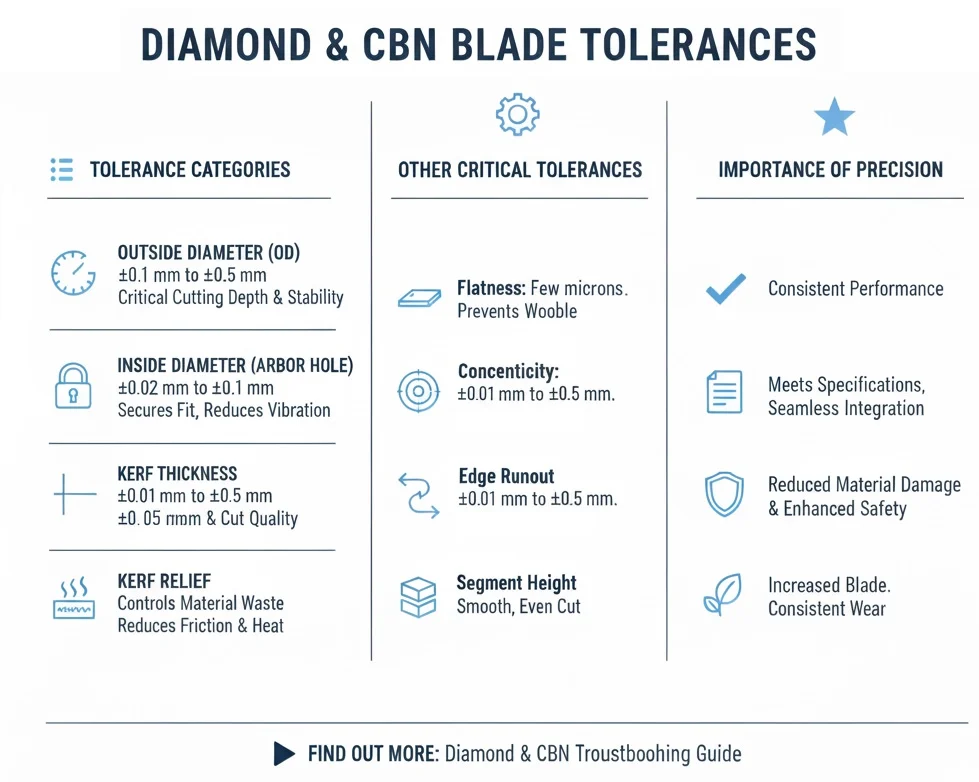
Inside Diameter (Arbor Hole) Tolerances - The inside diameter, or arbor hole, is another crucial tolerance that determines how securely the blade fits onto the machine’s spindle. A precise fit is essential for maintaining the blade’s stability during operation, reducing vibration, and ensuring accurate cuts.
Arbor hole tolerances are typically very tight, often within the range of ±0.02 mm to ±0.1 mm, to ensure a snug fit that prevents any wobble or misalignment. Even slight variations in the inside diameter can lead to significant issues, such as blade slippage, imbalance, or excessive wear on both the blade and the machine. This tight control over the inside diameter tolerance ensures that the blade remains firmly seated during cutting, providing consistent performance and extending the blade's life.
Kerf Thickness Tolerances - Kerf thickness refers to the width of the cut made by the blade, and maintaining tight tolerances here is critical for controlling material waste, cut quality, and overall precision. The kerf thickness tolerance typically ranges from ±0.01 mm to ±0.05 mm, depending on the application.
For applications requiring high precision, such as in the semiconductor or optics industries, the kerf thickness must be meticulously controlled to ensure minimal material loss and to produce the exact desired cut width. In industrial applications where robustness and durability are prioritized, slightly wider tolerances may be acceptable, but even in these cases, maintaining a consistent kerf is crucial to avoid uneven cuts or increased material waste.
Precise kerf thickness tolerances also contribute to the blade’s overall stability and cutting efficiency, as variations can affect the blade’s ability to track properly through the material.
Kerf Relief Tolerances - Kerf relief refers to the design feature that reduces the amount of material in the blade's body, often through the use of cooling slots or other forms of material removal. This feature is essential for reducing friction, dissipating heat, and preventing blade warping during high-speed cutting.
The tolerances for kerf relief are typically controlled within ±0.05 mm to ±0.1 mm, depending on the blade’s design and application. Maintaining consistent kerf relief tolerances ensures that the blade can operate efficiently without generating excessive heat or experiencing deformation. This is particularly important in high-speed or heavy-duty cutting applications where the blade is subjected to significant stress and heat.
Other Tolerances
In addition to the critical tolerances for outside diameter, inside diameter, kerf thickness, and kerf relief, several other tolerances must be managed to ensure the blade's overall performance and reliability:
-
 Flatness: The flatness of the blade, particularly in larger diameter blades, is crucial to prevent wobbling or deviation during cutting. Flatness tolerances are often controlled within a few microns, ensuring the blade remains stable and provides a clean, accurate cut.
Flatness: The flatness of the blade, particularly in larger diameter blades, is crucial to prevent wobbling or deviation during cutting. Flatness tolerances are often controlled within a few microns, ensuring the blade remains stable and provides a clean, accurate cut.
-
 Concentricity: This refers to how centered the blade is relative to its arbor hole. Poor concentricity can cause imbalance, leading to vibration and poor cut quality. Tolerances for concentricity are typically very tight, often within ±0.01 mm to ±0.05 mm.
Concentricity: This refers to how centered the blade is relative to its arbor hole. Poor concentricity can cause imbalance, leading to vibration and poor cut quality. Tolerances for concentricity are typically very tight, often within ±0.01 mm to ±0.05 mm.
-
 Edge Runout: Edge runout measures the wobble or deviation of the blade’s cutting edge as it rotates. Tight control over edge runout is necessary to ensure the blade cuts smoothly and evenly. Runout tolerances are usually kept within a range of ±0.01 mm to ±0.05 mm.
Edge Runout: Edge runout measures the wobble or deviation of the blade’s cutting edge as it rotates. Tight control over edge runout is necessary to ensure the blade cuts smoothly and evenly. Runout tolerances are usually kept within a range of ±0.01 mm to ±0.05 mm.
-
 Segment Height: For segmented blades, the height of each segment relative to the blade’s surface must be consistent to ensure even wear and cutting performance. Segment height tolerances are typically controlled within ±0.1 mm.
Segment Height: For segmented blades, the height of each segment relative to the blade’s surface must be consistent to ensure even wear and cutting performance. Segment height tolerances are typically controlled within ±0.1 mm.
Table that outlines the correlation between various tolerances for diamond and CBN blades:
|
Tolerance Type |
Influence on Blade Performance |
Correlation with Other Tolerances |
|---|---|---|
|
Outside Diameter (OD) |
Affects cutting depth, stability, and surface speed. Precise OD ensures proper fit in the machine and accurate cutting. |
Correlates with kerf thickness and edge runout. Variations in OD can lead to inconsistent kerf thickness and increase the likelihood of edge runout, impacting overall cut quality and blade balance. |
|
Inside Diameter (Arbor Hole) |
Ensures a secure fit on the spindle, reducing vibration and maintaining cutting accuracy. |
Directly correlates with concentricity. An incorrect inside diameter can cause poor concentricity, leading to imbalance, vibration, and uneven wear on the blade. |
|
Kerf Thickness |
Controls material removal, cut quality, and blade stability. Precision in kerf thickness is crucial for minimizing waste and achieving desired cut width. |
Correlates with OD and flatness. Variations in kerf thickness can affect flatness and edge runout, potentially causing the blade to wobble or cut unevenly, leading to poor cut quality and increased material waste. |
|
Kerf Relief |
Reduces friction, heat generation, and prevents warping. Proper kerf relief maintains blade efficiency in high-speed operations. |
Correlates with blade flatness and edge runout. Inconsistent kerf relief can lead to uneven heat distribution, affecting flatness and increasing the risk of runout, which compromises the blade’s cutting accuracy. |
|
Flatness |
Ensures the blade remains stable and cuts evenly without wobbling. Flatness is critical for high-precision applications. |
Directly affects kerf thickness and edge runout. Poor flatness can cause variations in kerf thickness and increase edge runout, leading to irregular cuts and reduced blade life. |
|
Concentricity |
Keeps the blade centered relative to the arbor hole, reducing vibration and improving balance during cutting. |
Correlates with inside diameter and edge runout. Poor concentricity, often due to incorrect inside diameter, increases runout and vibration, leading to imprecise cuts and potential damage to the blade and machine. |
|
Edge Runout |
Minimizes wobble during rotation, ensuring smooth and accurate cuts. |
Affected by OD, kerf thickness, flatness, and concentricity. High edge runout can cause irregular cuts, excessive wear, and potential blade failure, especially at high speeds. |
|
Segment Height |
Ensures even wear and consistent cutting performance in segmented blades. |
Correlates with OD and flatness. Uneven segment height can affect blade balance and stability, leading to variations in kerf thickness and reduced cutting efficiency. |
Diamond & CBN Blade Edge Types
When selecting a diamond or CBN blade, one of the important considerations is the edge type, which significantly impacts the blade’s cutting performance, speed, and suitability for various materials. The four primary edge types for diamond and CBN blades are continuous rim, slotted, segmented, and serrated. Each edge type offers distinct advantages and is tailored to specific cutting applications.
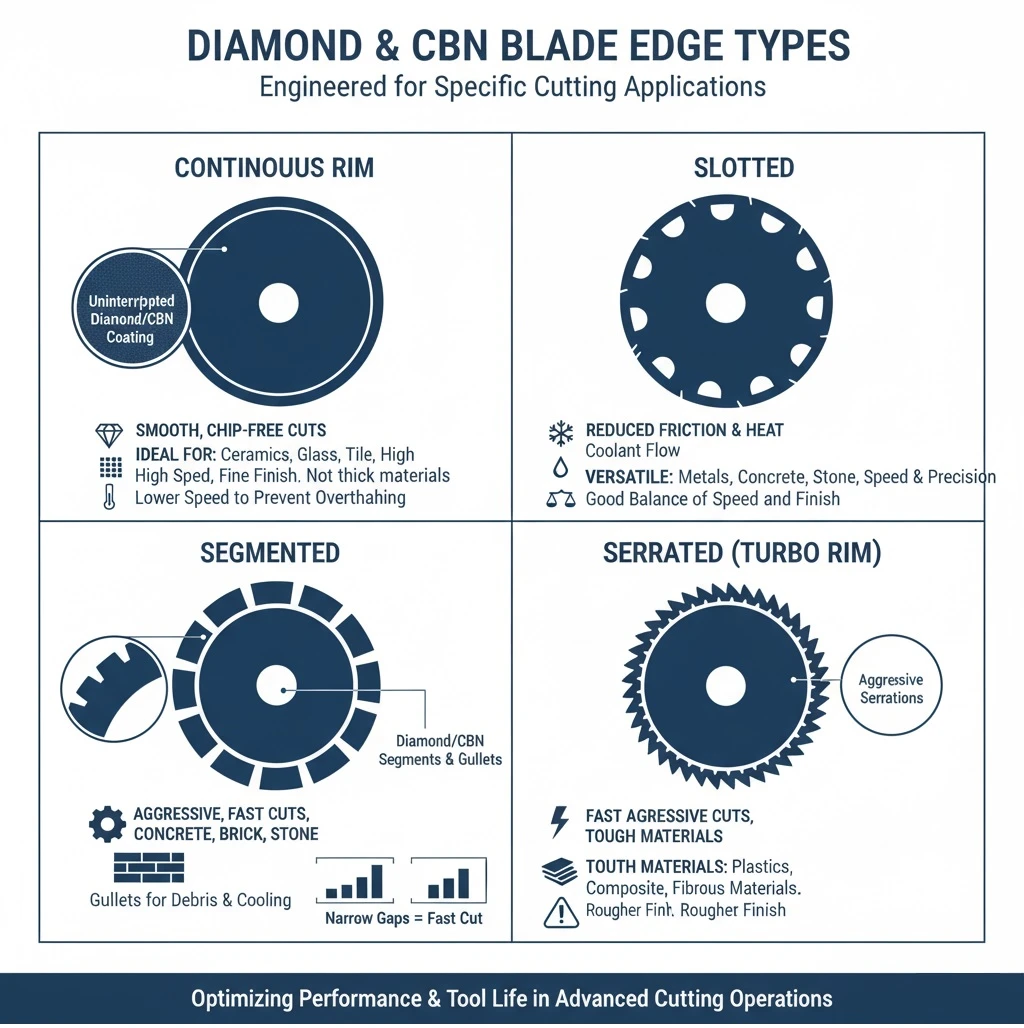
Continuous Rim

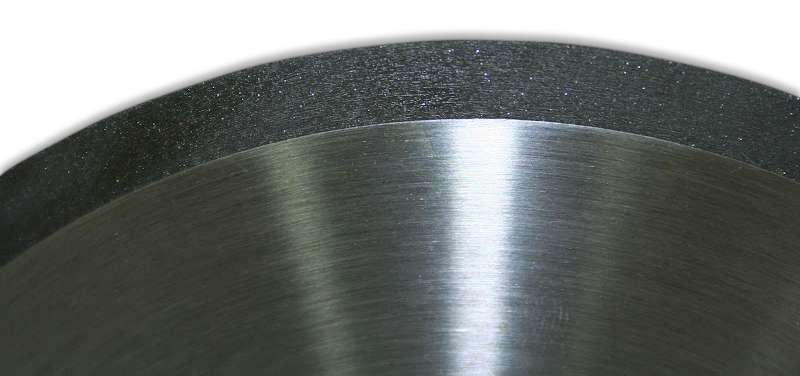
A continuous rim blade features an uninterrupted edge that is completely coated with diamond or CBN particles. This design provides a smooth, even cutting surface, making it ideal for precision cutting tasks that require a clean, chip-free finish. Continuous rim blades are particularly well-suited for cutting brittle materials such as ceramics, glass, porcelain, and tile.
The continuous edge allows the blade to maintain constant contact with the material, reducing the risk of chipping and providing a fine finish. These blades typically operate at higher speeds and are often used in applications where surface finish quality is critical. However, continuous rim blades may not be the best choice for cutting thicker or more abrasive materials, as they can overheat and wear out more quickly without adequate cooling.

Slotted
Slotted blades feature strategically placed slots along the edge of the blade, which serve several important functions. The slots help reduce friction by allowing air or coolant to flow more freely around the blade, effectively cooling it during cutting operations. This cooling effect reduces the risk of overheating and helps extend the blade’s life, particularly when cutting harder or more abrasive materials.
The slots also allow for better debris removal, preventing clogging and maintaining cutting efficiency. Slotted blades are versatile and can be used for cutting a variety of materials, including metals, concrete, and stone. They strike a balance between cutting speed and precision, offering good performance in applications where both are important.
Segmented
Segmented blades are designed with distinct segments along the edge, separated by gullets (deep grooves). These segments are usually bonded with diamond or CBN particles, making them highly durable and efficient at cutting through hard and abrasive materials such as concrete, brick, and stone. The gullets between the segments provide a space for debris to escape, enhancing the blade’s cutting speed and preventing overheating.
The segmented design also allows for better cooling, as the gaps between the segments facilitate airflow and reduce the risk of thermal damage to the blade and the material being cut. Segmented blades are ideal for heavy-duty cutting applications where speed and durability are more important than a smooth finish. However, the segmented design can produce a rougher edge compared to continuous rim blades, making them less suitable for precision tasks where finish quality is paramount.
The narrower the spacing between the segments the better the cut quality, wider the spacing between the segments the faster the cutting speed/
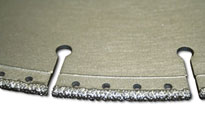

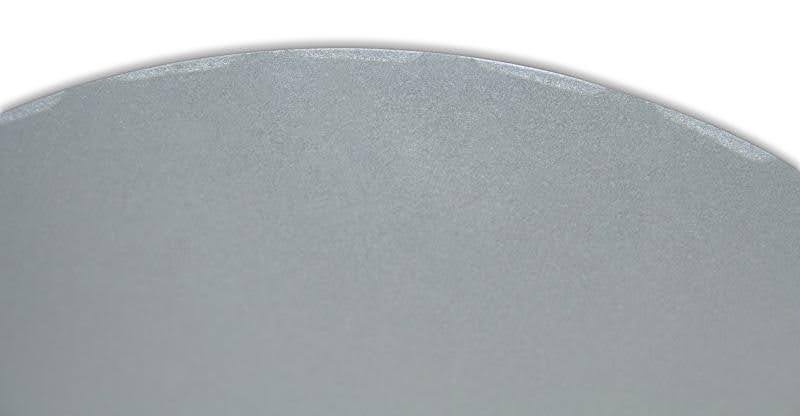
Serrated
Serrated blades feature a jagged, toothed edge, similar to a saw blade. This design allows the blade to aggressively bite into the material, making it particularly effective for cutting through tough, fibrous, or composite materials. The serrations create multiple points of contact, distributing the cutting force more evenly and reducing the risk of binding or overheating.
Serrated blades are commonly used in applications that involve cutting plastics, and composite materials where a fast, efficient cut is needed. The serrated edge provides excellent cutting speed, but the trade-off is a rougher finish compared to smooth-edged blades like the continuous rim. These blades are ideal for tasks where speed and material removal are prioritized over surface finish.
Diamond & CBN Blade Depth/Height
The diamond depth, also known as diamond height, is a important aspect of diamond blade design that significantly influences the blade's cutting performance, durability, and overall cost-effectiveness. This measurement refers to the vertical thickness of the diamond layer on the blade, extending from the edge of the steel core to the outermost tip of the diamond-covered edge. The amount of diamond material present in this layer directly affects how well the blade performs over time and how long it can maintain its cutting ability.
A greater diamond depth allows the blade to retain its cutting efficiency for an extended period, as there is more diamond material available for the cutting process. This makes the blade last longer and reduces the frequency of replacements, which can be particularly cost-effective in applications that require high-volume cutting. On the other hand, a blade with a shallower diamond depth may wear out more quickly, necessitating more frequent changes and potentially increasing operational costs.
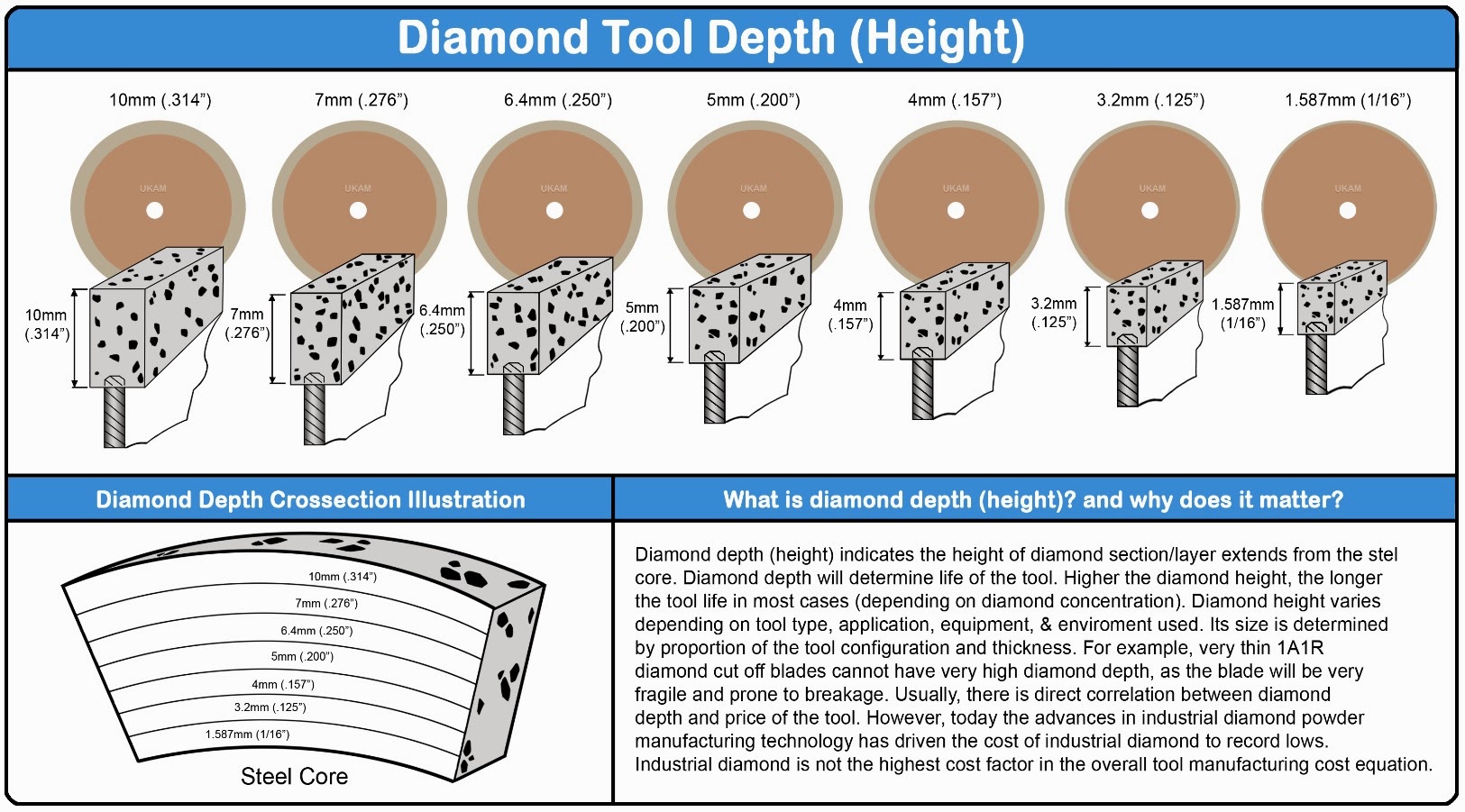
The suitability of a specific diamond depth depends largely on the intended application. For instance, blades designed for heavy-duty tasks like cutting concrete, stone, or asphalt require a greater diamond depth to endure the demands of these tough materials. The increased diamond material provides the necessary durability and cutting power to manage these challenging applications. In contrast, for precision work such as cutting ceramics, glass, or delicate composites, a shallower diamond depth may suffice. These materials typically cause less wear on the blade, and a shallower depth can also allow for more controlled, precise cuts.
Additionally, diamond depth plays a role in cooling and heat dissipation during cutting operations. As the blade cuts through material, heat is generated at the point of contact. Blades with a greater diamond depth have more material to absorb and dissipate this heat, reducing the risk of overheating and extending the blade's lifespan. This cooling effect is crucial, especially in high-speed cutting environments.
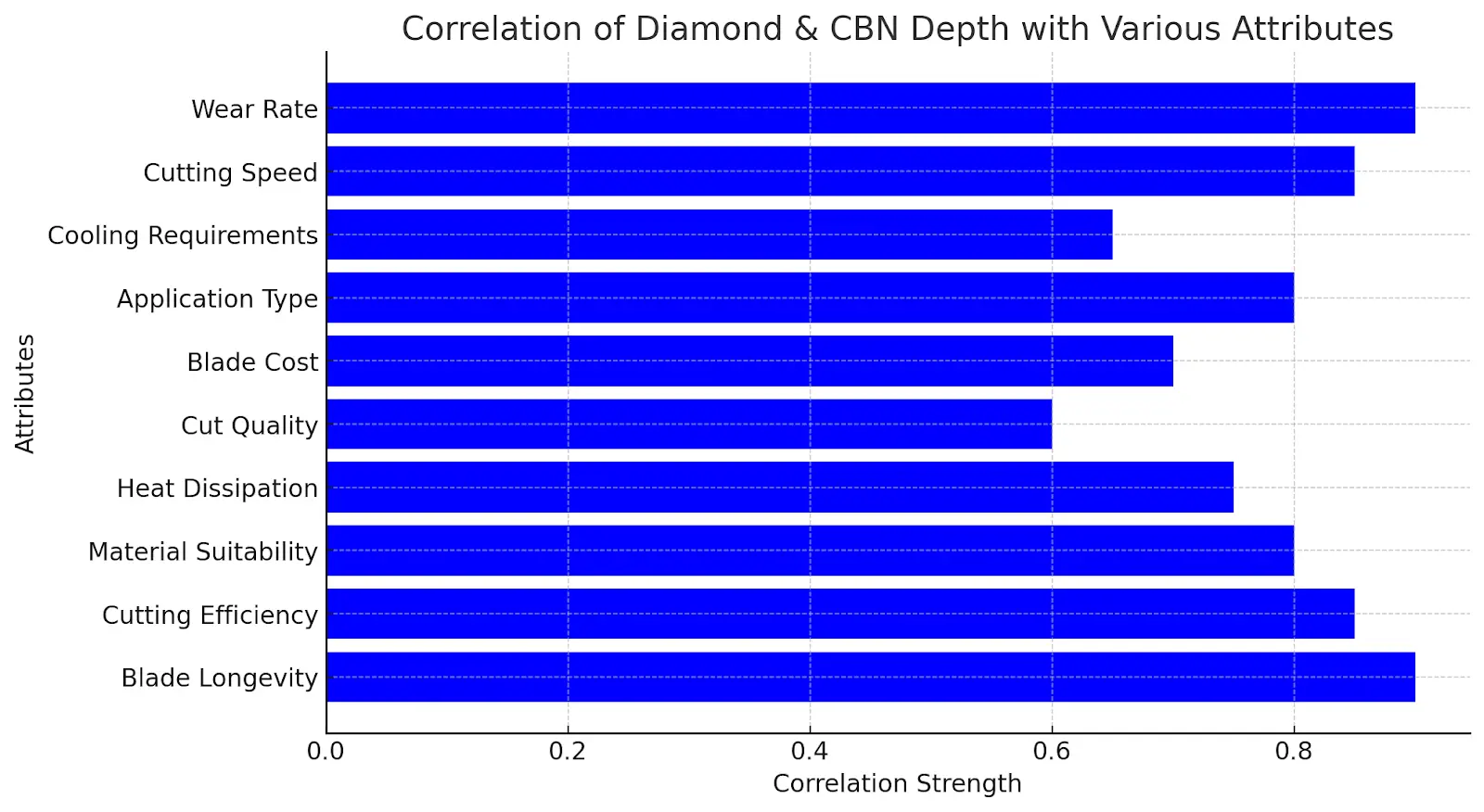
While blades with a deeper diamond layer tend to be more expensive due to the increased amount of diamond material used, the higher initial cost is often offset by the longer lifespan and improved cutting performance. This is especially true in demanding applications where the blade's durability is important. However, the decision to choose a blade with greater diamond depth should be balanced against the specific needs of the application, considering factors like cutting speed, the type of material being cut, and the overall cost implications.
Selecting the appropriate diamond depth involves understanding the relationship between this dimension and the blade's performance. A deeper diamond layer is generally best for heavy-duty applications where long-lasting cutting power is essential, while a shallower layer is often sufficient for precision work that demands accuracy over endurance. By carefully considering the material being cut and the specific requirements of the cutting operation, users can choose the right diamond blade to achieve optimal performance and longevity.
Table outlining the correlation between diamond & CBN depth and other variables and attributes:
|
Variable/Attribute |
Correlation with Diamond & CBN Depth |
|---|---|
|
Blade Longevity |
Greater diamond depth generally increases blade longevity, allowing for more cuts before the blade needs replacement. |
|
Cutting Efficiency |
A deeper diamond layer enhances cutting efficiency, especially in hard or abrasive materials, by providing more cutting material. |
|
Material Suitability |
Deeper diamond depth is suited for tougher, more abrasive materials (e.g., concrete, stone), while shallower depths are better for softer or delicate materials (e.g., ceramics, glass). |
|
Heat Dissipation |
Blades with more diamond material can dissipate heat more effectively, reducing the risk of overheating during cutting operations. |
|
Cut Quality |
Shallower diamond depth may allow for finer, more controlled cuts, ideal for precision applications, while deeper depths offer durability but may result in slightly rougher cuts in some applications. |
|
Blade Cost |
Blades with a greater diamond depth tend to be more expensive due to the increased amount of diamond material used. |
|
Application Type |
Heavy-duty applications benefit from greater diamond depth for enhanced durability, while lighter-duty tasks may not require as much diamond material. |
|
Cooling Requirements |
Blades with greater diamond depth may require less intensive cooling because of better inherent heat dissipation. |
|
Cutting Speed |
Deeper diamond layers support higher cutting speeds without sacrificing blade life, especially in high-demand environments. |
|
Wear Rate |
A greater diamond depth generally leads to a slower wear rate, extending the effective working life of the blade. |
Diamond & CBN Balde Abrasive Types
Each of these materials—natural diamond, synthetic diamond, synthetic diamond coated, and CBN—has unique properties that make it suitable for specific industrial applications. The choice between them depends on the material being worked on, the required precision, the operational environment, and cost considerations. By selecting the appropriate diamond or CBN type, manufacturers can optimize their cutting, grinding, and finishing processes to achieve the best possible results.
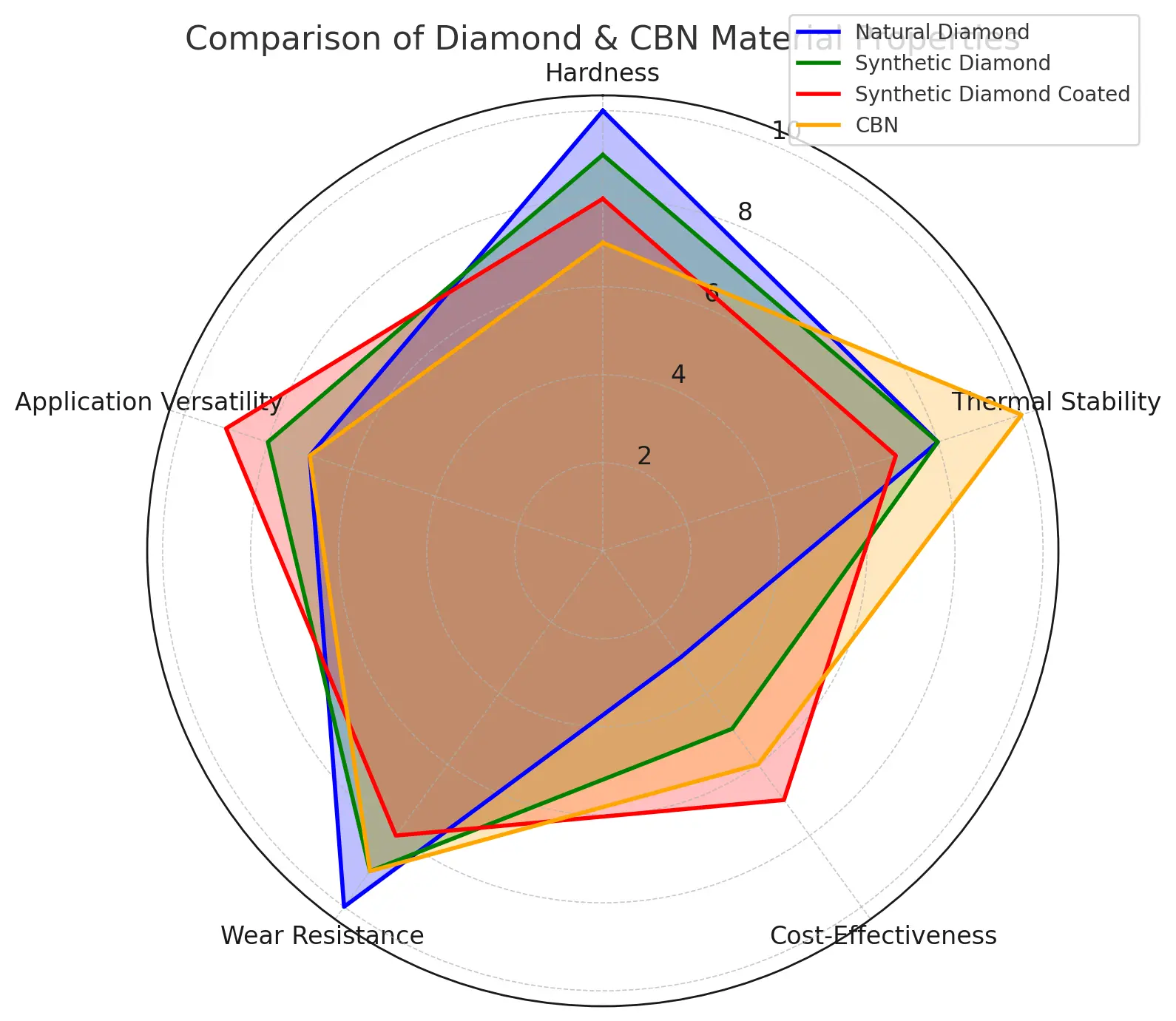
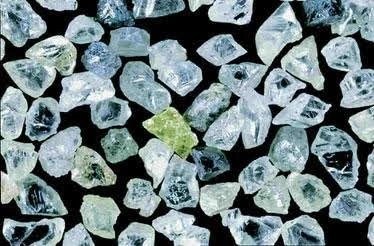
D - Natural Diamond
Natural diamonds are the hardest known material and have been used in cutting and grinding applications for many years. These diamonds are sourced directly from nature and are highly valued for their unmatched hardness and wear resistance. Natural diamond is ideal for applications requiring precise cutting, especially on extremely hard materials like glass, ceramics, and certain metals. However, due to the rarity and cost of natural diamonds, they are typically reserved for high-precision, specialized applications.
MD - Synthetic Diamond
Synthetic diamonds, also known as lab-grown or industrial diamonds, are created through a controlled process that mimics the conditions under which natural diamonds form. These diamonds are engineered to have consistent quality and performance, making them highly reliable for industrial use. Synthetic diamonds are the most widely used in diamond & cbn blades because they offer a cost-effective alternative to natural diamonds while still delivering excellent hardness and durability.
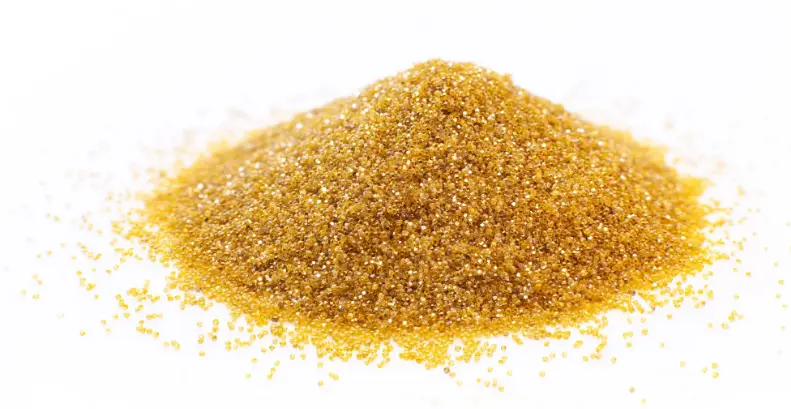
MDC - Synthetic Diamond Coated
Synthetic Diamond Coated (MDC) materials involve a coating of synthetic diamond on another substrate, typically a metal or carbide. This coating enhances the cutting or grinding performance by providing the hardness and wear resistance of diamond on a more flexible or durable base material. MDC tools are often used in applications that require the cutting edge of diamond but also benefit from the toughness and shock resistance of the underlying substrate. This combination makes MDC tools highly effective in industries such as aerospace, automotive, and metalworking.
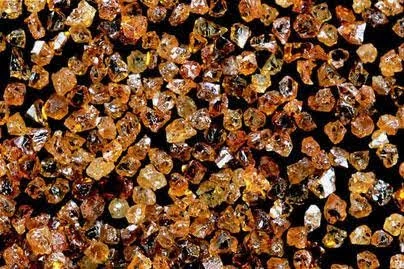
CBN - Cubic Boron Nitride
Cubic Boron Nitride (CBN) is the second hardest material after diamond and is particularly effective for cutting and grinding ferrous (iron-based) materials, where diamond would wear down too quickly due to chemical reactions with iron. CBN is used extensively in the manufacturing of cutting tools, particularly for hardened steel, cast iron, and other tough metals. CBN tools offer excellent thermal stability and maintain their sharpness and cutting ability even under high temperatures and stress, making them ideal for heavy-duty and high-precision machining.
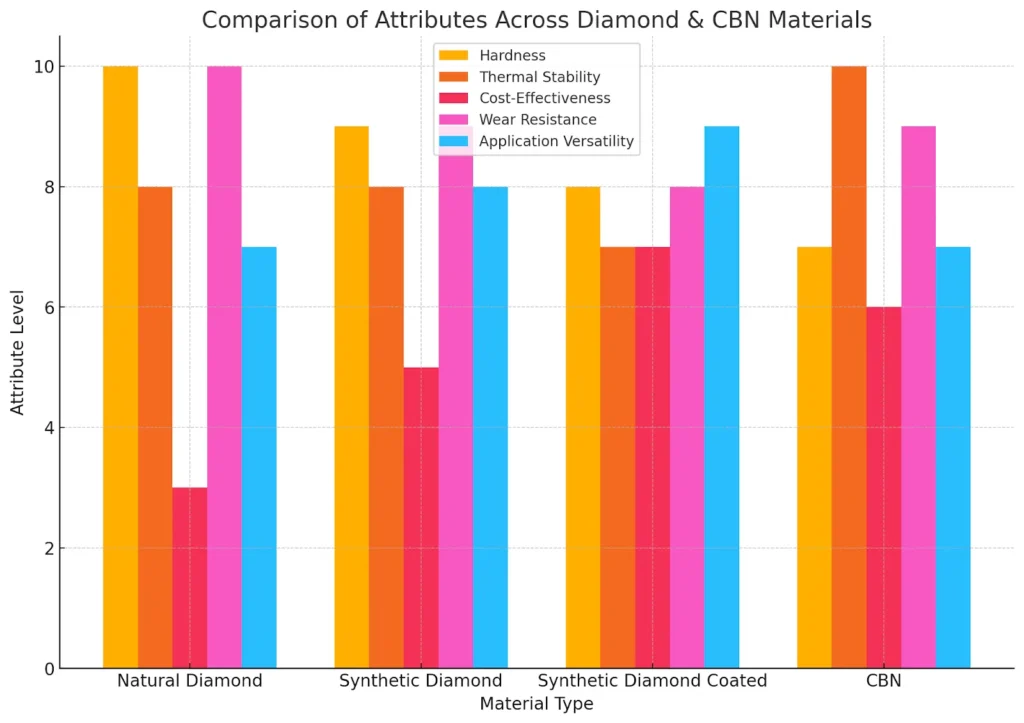
|
Attribute |
Natural Diamond |
Synthetic Diamond |
Synthetic Diamond Coated |
CBN (Cubic Boron Nitride) |
|---|---|---|---|---|
|
Hardness |
10 (Highest) |
10 (Highest) |
10 (Highest for the coating) |
9.5 (Very High) |
|
Thermal Stability |
High, but can degrade at very high temperatures |
High |
Moderate |
Very High, especially with ferrous materials |
|
Cost-Effectiveness |
Low due to rarity and high cost |
Moderate to High, depending on application |
High, as it offers a balance between performance and cost |
Moderate, more cost-effective for ferrous materials |
|
Wear Resistance |
Very High, excellent for cutting hard materials |
Very High, close to natural diamond |
High, though slightly less than pure synthetic diamond |
High, maintains cutting efficiency over time |
|
Application Versatility |
Versatile but primarily used in high-precision, high-cost applications |
Versatile across many industrial applications, including cutting, grinding, and drilling |
Very versatile, used in various industries due to balance of properties |
Versatile, particularly effective with ferrous materials and hardened steels |
Diamond & CBN Blade Edge Shapes and Their Applications
The edge shape, radius, and geometry of a diamond & cbn blade are critical factors that significantly influence its cutting performance, precision, and application suitability. These factors determine how the blade interacts with the material being cut, affecting everything from cutting speed and accuracy to the quality of the finished cut.
Diamond Edge Shape
The edge shape of a diamond & cbn blade refers to the physical contour or profile of the blade’s cutting edge. The edge shape is designed to optimize the blade’s performance for specific cutting tasks and materials. Common edge shapes include flat edges, tapered edges, and chamfered edges.
-
Flat Edge: A flat edge is characterized by a straight, uniform cutting edge without any angular variations. This type of edge is often used in applications that require smooth, precise cuts with minimal chipping, such as in cutting glass, ceramics, or semiconductor wafers.
-
Tapered Edge: A tapered edge gradually narrows from the base of the blade to the cutting edge. This design reduces the contact area between the blade and the material, which can reduce friction and improve cutting speed. Tapered edges are particularly useful for cutting dense or hard materials, where reducing friction can help manage heat buildup and extend blade life.
-
Chamfered Edge: A chamfered edge features a beveled or angled surface along the cutting edge. This design helps to reduce chipping and improve the blade’s ability to handle brittle materials. Chamfered edges are often used in applications involving delicate or easily damaged materials, such as ceramics or glass, where a smoother cut is required.
Diamond Edge Radius
The edge radius of a diamond blade refers to the curvature or roundness of the blade’s cutting edge. This radius is a critical parameter in determining the blade’s cutting performance, particularly in precision applications.
-
Small Radius (Sharp Edge): A smaller edge radius results in a sharper cutting edge, which can produce finer, more precise cuts. Sharp edges are ideal for applications where accuracy is paramount, such as in microelectronics or precision optics. However, sharper edges may wear out more quickly, especially when cutting hard or abrasive materials.
-
Large Radius (Blunt Edge): A larger edge radius produces a blunter cutting edge, which is more durable and resistant to wear. Blunter edges are suitable for heavy-duty applications where cutting speed and durability are more important than precision. For example, a larger edge radius is beneficial when cutting through thick, abrasive materials like concrete or stone, where the blade needs to withstand significant wear and tear.
Diamond Edge Geometry
The geometry of a diamond blade edge encompasses the overall shape, angle, and design of the cutting edge. This geometry plays a crucial role in determining how the blade will perform in specific cutting scenarios.
-
V-Shaped Geometry: A V-shaped edge is designed for making narrow, precise cuts. This geometry is often used in applications requiring fine grooves or slots, such as in electronics manufacturing or in the production of intricate metal parts. The V-shaped edge allows for detailed cutting with minimal material removal, making it ideal for delicate tasks.
-
U-Shaped Geometry: A U-shaped edge is typically used for cutting materials where chip clearance is important. This geometry helps to channel debris away from the cutting area, reducing the risk of clogging and improving cutting efficiency. U-shaped edges are common in blades used for cutting softer materials like plastics or rubber, where maintaining a clean cutting surface is essential for achieving a smooth finish.
-
Flat-Topped Geometry: Flat-topped edges are designed for making broad, shallow cuts. This geometry is effective in applications where a consistent, even cut is needed, such as in woodworking or in the processing of soft metals. The flat-topped edge distributes the cutting force evenly across the blade, resulting in a smooth, uniform cut.
Importance of Edge Shape, Radius, and Geometry
The choice of edge shape, radius, and geometry is critical to the success of a cutting operation. Selecting the right combination of these factors can optimize the blade’s performance for the material being cut, improve cutting speed, and enhance the quality of the finished product. For instance, a sharp edge with a small radius might be perfect for precision cutting of delicate materials, but it would wear out quickly if used on hard, abrasive surfaces. Conversely, a blunt edge with a large radius might not provide the necessary precision for fine work but would offer greater durability in heavy-duty applications.
Table that compares different diamond edge shapes, radii, and geometries
|
Edge Feature |
Type |
Characteristics |
Ideal Applications |
|---|---|---|---|
|
Edge Shape |
Flat Edge |
Straight, uniform cutting edge, minimal angular variation |
Precision cutting with smooth, chip-free finishes; glass, ceramics, semiconductor wafers |
|
Tapered Edge |
Gradually narrows from base to cutting edge, reduces friction |
Cutting dense or hard materials; improved cutting speed and reduced heat buildup |
|
|
Chamfered Edge |
Beveled or angled cutting surface, reduces chipping |
Delicate or brittle materials; ceramics, glass; smoother cuts |
|
|
Edge Radius |
Small Radius (Sharp Edge) |
Sharp cutting edge, fine and precise cuts |
High-precision applications; microelectronics, optics |
|
Large Radius (Blunt Edge) |
Blunt cutting edge, more durable and wear-resistant |
Heavy-duty cutting; thick, abrasive materials like concrete, stone |
|
|
Edge Geometry |
V-Shaped Geometry |
Narrow, precise cuts, minimal material removal |
Fine grooves or slots; electronics manufacturing, intricate metal parts |
|
U-Shaped Geometry |
Channels debris away, reduces clogging, improves efficiency |
Softer materials; plastics, rubber; clean cutting surface |
|
|
Flat-Topped Geometry |
Broad, shallow cuts, even force distribution |
Consistent, even cuts; woodworking, soft metals |
|
Relief Design: The relief design means that the blade has a thinner steel core compared to the diamond section. This configuration reduces the amount of material in contact with the cutting surface, minimizing friction and heat generation. As a result, the blade can cut more smoothly and efficiently, reducing wear and extending the blade's lifespan. Steel Core: The core of the blade is made of high-quality steel, providing the necessary strength and rigidity to handle high-load cutting operations. The steel core's thinner profile ensures flexibility and precision, making it ideal for intricate cuts and maintaining tight tolerances. Diamond Section Thickness: The diamond section is thicker than the steel core, providing a robust cutting edge that can handle various materials. The thickness of the diamond section ensures durability and long-lasting performance, even in demanding applications. |
1A1RDiamond Cut Off blade with relief. This blade has steel core. Core thickness is thinner than diamond section thickness. This is the most common diamond blade used in most diamond cut off operations, across wide variety of industries. Description: A flat, continuous rim blade with no slots. Application: Ideal for smooth, precision cutting with minimal chipping. Commonly used in applications requiring a fine finish, such as glass, ceramics, and delicate materials. |
|
The 1A1 wheel shape is one of the most common and straightforward wheel shapes used in grinding and cutting applications. The 1A1 diamond wheel shape is a flat, straight-edged wheel with a concentric circle design, where the abrasive diamond particles are embedded in the perimeter of the wheel.
Shape: The 1A1 wheel shape is flat and has a straight profile with no recesses or flaring. Edge: The edges are straight and perpendicular to the face of the wheel, providing a clear and precise cutting surface. Face: The face of the 1A1 wheel is typically flat and used for grinding or cutting. Diameter and Thickness: The diameter and thickness of the 1A1 wheel can vary based on the specific application requirements. |
1A1The 1A1 diamond blade features no relief, meaning the diamond section and core thickness are identical. This uniformity ensures stability and precision during cutting operations. Application: These blades are especially suited for gang saw applications involving hard brittle materials, glass, optics, and composites. The inherent rigidity of the blade makes it ideal for high load and deep cut depth processing. The cut depth is limited to the height of the diamond section. Kerf Thickness: The width of the cut made by the blade, which matches the core thickness. This consistent thickness ensures stability and precision during cutting. Typical kerf thickness ranges from 0.12 inches (0.3 mm) to 0.125 inches (3.2 mm). Core Thickness: The actual thickness of the blade itself, matching the kerf thickness. This consistency is crucial for maintaining the blade's structural integrity and providing precise cuts. Diamond Depth (Height): The maximum cutting depth is limited to the height of the diamond section on the blade, dictating how deep the blade can cut into a material. Available diamond depths range from 1.58 mm (1/16 inch) to 14 mm (9/16 inch), meaning the blade can only cut as deep as the diamond section extends. |
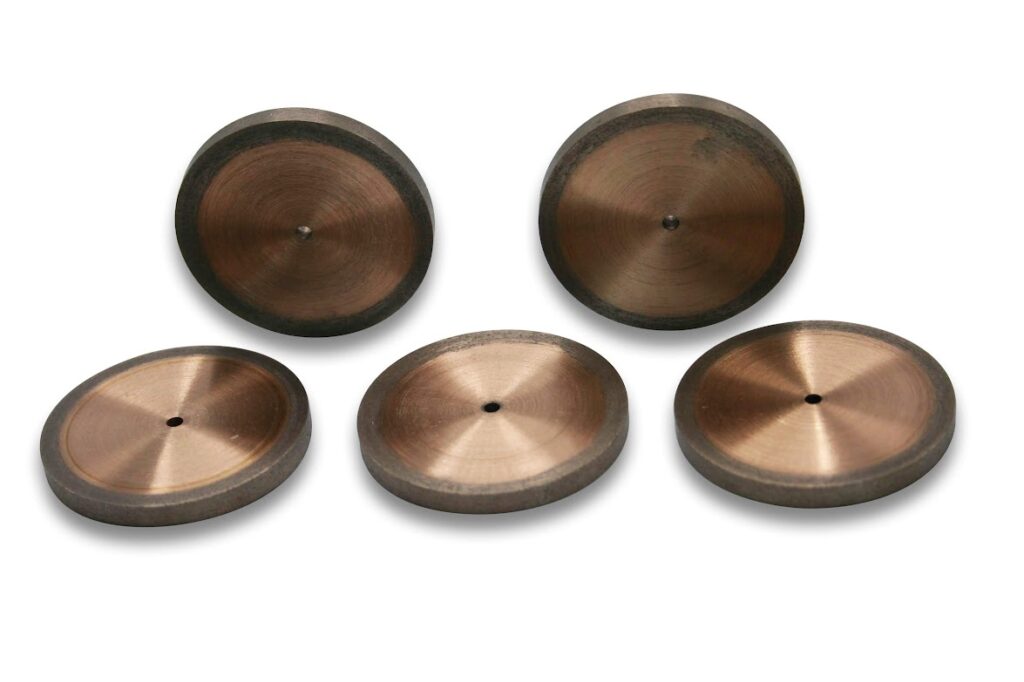
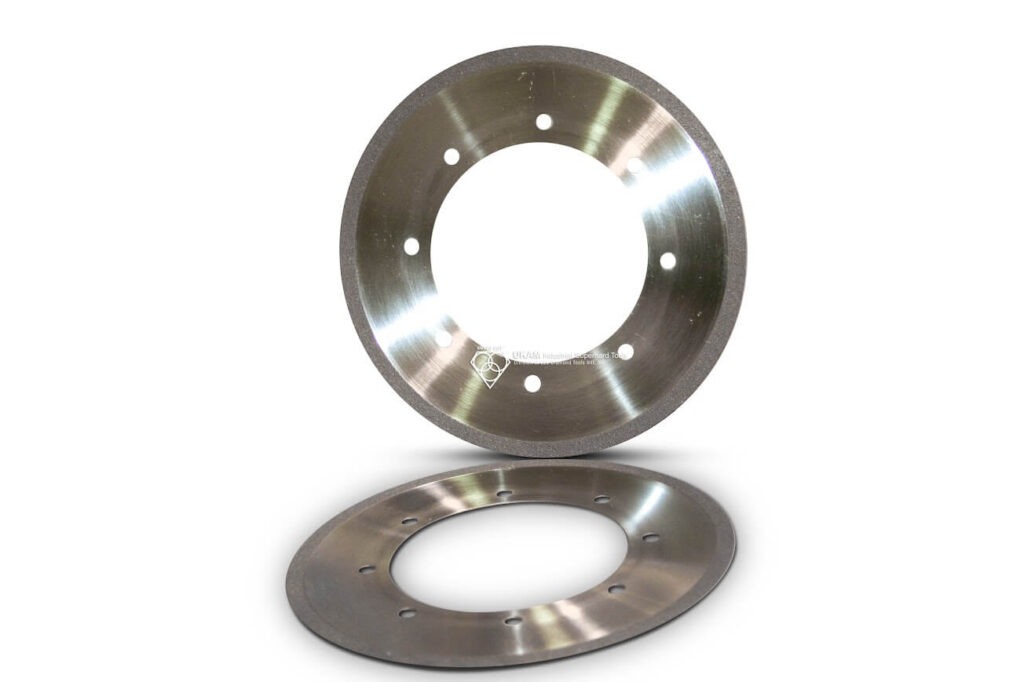
1E1 blade features a flat edge with segments along the rim, designed to enhance cooling and debris removal. This structure is particularly effective for cutting harder materials where heat dissipation is critical, such as concrete and masonry, making it suitable for construction environments where maintaining blade temperature and cleanliness is essential.
1M1 blade is characterized by a segmented rim with a modified shape to improve performance. This blade is engineered to cut through dense and abrasive materials, providing better cooling and reduced wear. It's often employed in construction and heavy-duty applications where durability and efficiency are key to handling tough materials.
1N1 blade incorporates a continuous rim with a specific profile tailored for specialized cutting tasks. It offers a balance between precision and speed, making it an excellent choice for industries like electronics and semiconductors. This blade excels in cutting hard substrates, where maintaining precision is as critical as efficiency.
1V1 blade has a continuous rim but with a v-shaped edge, making it ideal for creating v-grooves or precise angled cuts. It's particularly useful in applications that require detailed and accurate cutting, such as in the manufacturing of fine ceramics or optical components, where precision is paramount.
|
|
1A8 blade - fully impregnated with diamond and designed with a broad, flat edge to maximize contact with the material. It is well-suited for high-volume material removal in tough materials, providing consistent performance across a range of hard and brittle composites. This blade is ideal for applications requiring rapid, uniform cutting. 1E8 blade - features a flat edge profile and is also fully impregnated with diamond. It is tailored for demanding environments where durability and a consistent cutting edge are crucial. This blade excels in cutting hard, abrasive materials, ensuring long blade life and uniform cutting capabilities. 1M8 blade - fully impregnated with diamond, has a modified edge to enhance cutting strength and performance. It offers superior wear resistance and is ideal for slicing through dense, abrasive materials like advanced ceramics and metal matrix composites. This blade ensures precision cutting with minimal thermal damage. 1N8 blade - presents a continuous, smooth rim fully impregnated with diamond. It delivers excellent performance in delicate applications such as slicing semiconductor materials or intricate electronic components, where maintaining cut quality and component integrity is essential. 1V8 blade - fully impregnated with diamond and features a v-shaped edge designed for specialized tasks. This blade is particularly useful for making precise v-grooves or detailed angled cuts in the manufacturing of fine ceramics or optical components, where precision is of utmost importance. |
Grit Sizes for Diamond & CBN Blades
Diamond & CBN Grit Size, often referred to as mesh size, is a crucial factor in selecting diamond blades for specific cutting tasks. It denotes the size of diamond particles in the blade's matrix, measured by the number of meshes per linear inch in the screen used for sizing. For instance, a diamond with a 120 mesh size would pass through a 100 mesh screen but not a 150 mesh screen. According to U.S. standards, the mesh number roughly equals the number of sieve meshes per inch.

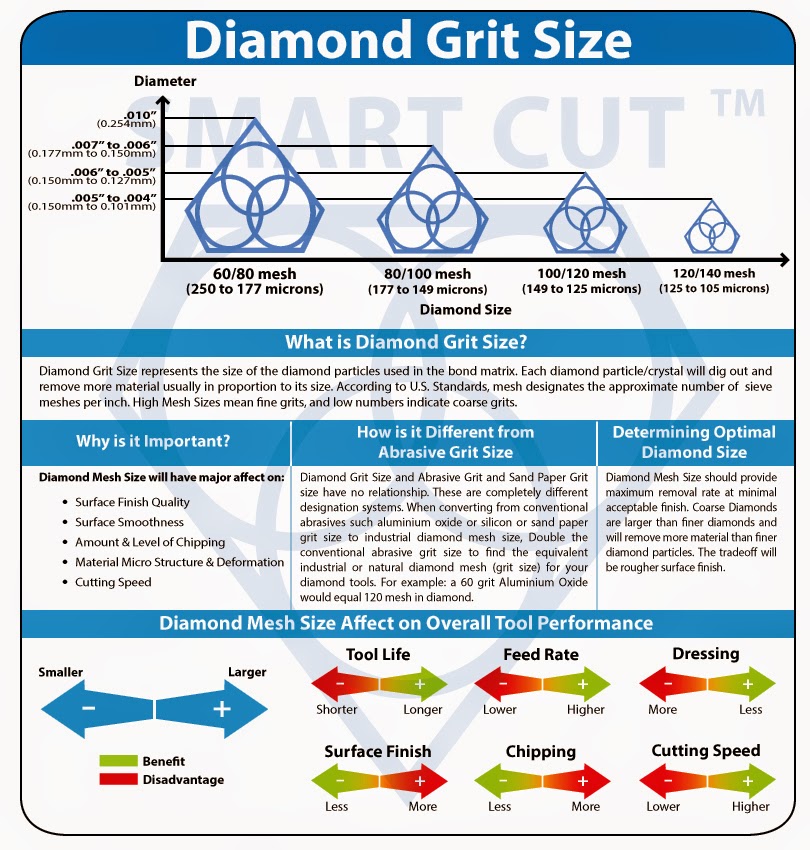
The mesh size significantly impacts several aspects of cutting performance. Finer grits, like 220 and 320 mesh, are smaller and produce a smoother surface finish with minimal chipping. These sizes are ideal for precise cutting of delicate materials such as lithium niobate, yttrium vanadate, gallium arsenide, and optical materials. On the other hand, coarser grits like 80 and 100 mesh are larger and remove more material per pass, suitable for faster cutting of harder materials such as silicon carbide, zirconia, aluminum oxide, stainless steels, and advanced ceramics. However, this often comes at the cost of increased microstructural damage to the material.
Choosing the right mesh size involves balancing the need for material removal rate with the desired surface finish. Coarser diamonds are more aggressive, enabling faster cuts but potentially harming delicate materials. In many cases, achieving the desired finish quality may require multiple steps, with initial cuts made using coarser grits followed by finer grits for lapping or polishing.
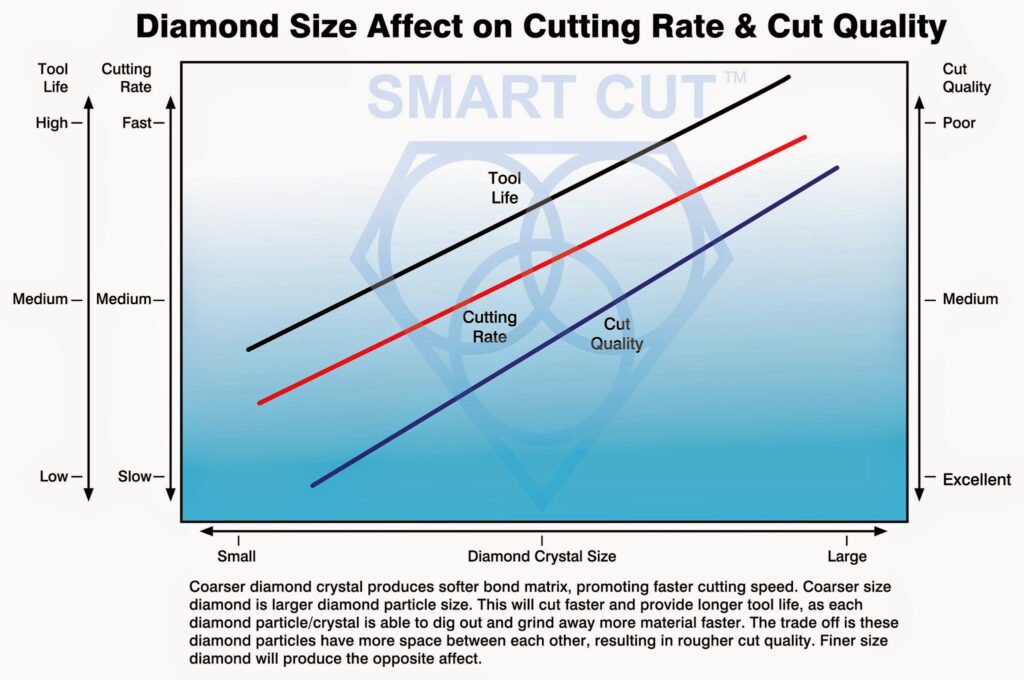
Factors such as the blade's bond type, blade thickness, the machinery used, and the specific industry requirements also influence the choice of mesh size. The type and flow of coolant used can further affect the blade's interaction with the material, impacting the effectiveness of different mesh sizes. Selecting the appropriate mesh size is essential for optimizing cutting operations across various materials, ensuring efficient processing while maintaining the integrity and quality of the cut surfaces.
When discussing diamond and CBN blades for cutting, it's crucial to understand that grit sizes and their implications can vary significantly depending on the bond type used in the blade's construction. These bond types include sintered (metal bond), resin bond, nickel bond, hybrid bond, and electroplated bond, each offering different characteristics suited to various cutting tasks and materials.
Diamond & CBN Diamond Grit Size Range for Various Applications:
Very coarse grit Size, ranging from 10 to 40 mesh, are typically utilized in blades designed for rapid material removal in tough applications such as large-scale demolition or rough shaping of stone.
Corse Grit Size, As grit sizes become slightly finer, in the 41 to 80 mesh range labeled as coarse, these are more commonly employed in general construction and masonry, cutting concrete, paving stones, and bricks effectively.
Medium grit size, which span from 81 to 180 mesh, provide a balance between aggressive cutting and achieving a smoother finish. These sizes are favored in industrial settings for cutting materials like ceramics, reinforced concrete, and hard stones.

Medium fine grit size, between 181 and 320 mesh, are used for finer, more precise cuts needed in detailed sculpting or in creating smooth finishes on materials like quartz and fine ceramics. This size range is essential for tasks requiring high accuracy but still needing to manage material removal efficiently.
Fine Grit Size, from 321 to 600 mesh, are selected for their ability to produce exceptionally smooth surfaces and are crucial in applications such as gemstone cutting or in the optical industry where precision and finish quality are important.

Variables that influence diamond grit size in blade cutting applications
|
Variable |
Influence on Grit Size |
Correlation with Grit Size |
|---|---|---|
|
Material Hardness |
Harder materials may require finer grit to prevent damage |
Inverse: Harder materials often benefit from finer grits to ensure clean cuts |
|
Material Abrasiveness |
More abrasive materials can wear down finer grits faster, requiring coarser grit |
Direct: Abrasive materials generally require coarser grits to withstand wear |
|
Desired Surface Finish |
Finer grits are needed for smoother finishes |
Direct: A smoother finish requires finer grits |
|
Cutting Speed |
Coarser grits increase cutting speed but may reduce precision |
Inverse: Higher cutting speeds are achieved with coarser grits but at the cost of finish quality |
|
Material Fracture Sensitivity |
Finer grits reduce the risk of damaging sensitive materials |
Direct: Finer grits are preferable for materials sensitive to cracking or chipping |
Concentration for Diamond & CBN blades
Diamond & CBN Concentration refers to the proportion and distribution of diamond abrasive particles within the blade, impacting its cutting performance, longevity, and cost. The concentration is typically quantified as a numeric value indicating the carats per cubic centimeter (ct/cm³) of the diamond layer volume, considering both the mesh size and the bond material. For instance, a concentration of 100 corresponds to 4.4 ct per cm³. This indicates that the diamond particles constitute approximately 25% of the diamond layer's volume, based on a diamond density of 3.52 g/cm³ and the conversion of 1 carat to 0.2 grams. The range of nominal diamond concentration in precision diamond blades spans from 0.5 ct/cm³ to 6 ct/cm³, which translates to concentrations from 8 to 135.


Factors Influencing the Selection of Diamond Concentration The optimal diamond concentration for a precision diamond sawing operation depends on several key factors:
-
 aterial Being Cut: The hardness and abrasiveness of the material dictate the needed concentration. Softer, more abrasive materials generally require higher concentrations to compensate for faster diamond erosion.
aterial Being Cut: The hardness and abrasiveness of the material dictate the needed concentration. Softer, more abrasive materials generally require higher concentrations to compensate for faster diamond erosion.
-
 Bond Type and Hardness: The bond holds the diamond particles in place. Its hardness and the type (metallic, resin, vitrified) should complement the diamond concentration to balance blade life and cutting efficiency.
Bond Type and Hardness: The bond holds the diamond particles in place. Its hardness and the type (metallic, resin, vitrified) should complement the diamond concentration to balance blade life and cutting efficiency.
-
 Diamond Mesh Size: Larger diamonds (lower mesh size) may require different concentrations compared to smaller diamonds (higher mesh size) to achieve the desired cutting surface and performance.
Diamond Mesh Size: Larger diamonds (lower mesh size) may require different concentrations compared to smaller diamonds (higher mesh size) to achieve the desired cutting surface and performance.
-
 Cutting Speeds: Higher speeds often require adjustments in concentration to prevent premature diamond shedding and excessive heat generation.
Cutting Speeds: Higher speeds often require adjustments in concentration to prevent premature diamond shedding and excessive heat generation.
-
 Coolants Used: The type and flow of coolant can affect the blade's temperature and the rate of diamond erosion, influencing the suitable diamond concentration.
Coolants Used: The type and flow of coolant can affect the blade's temperature and the rate of diamond erosion, influencing the suitable diamond concentration.
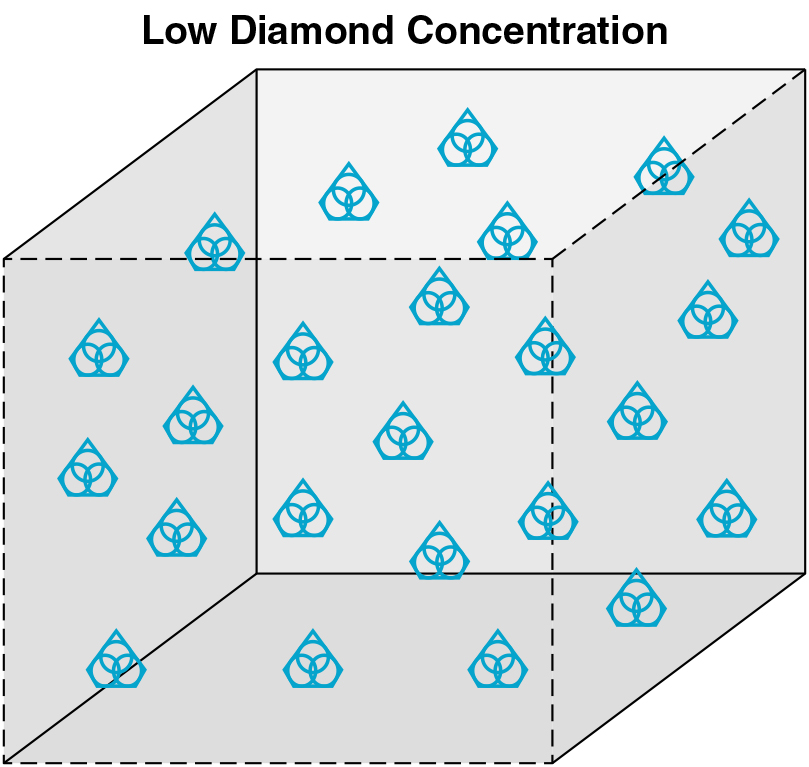
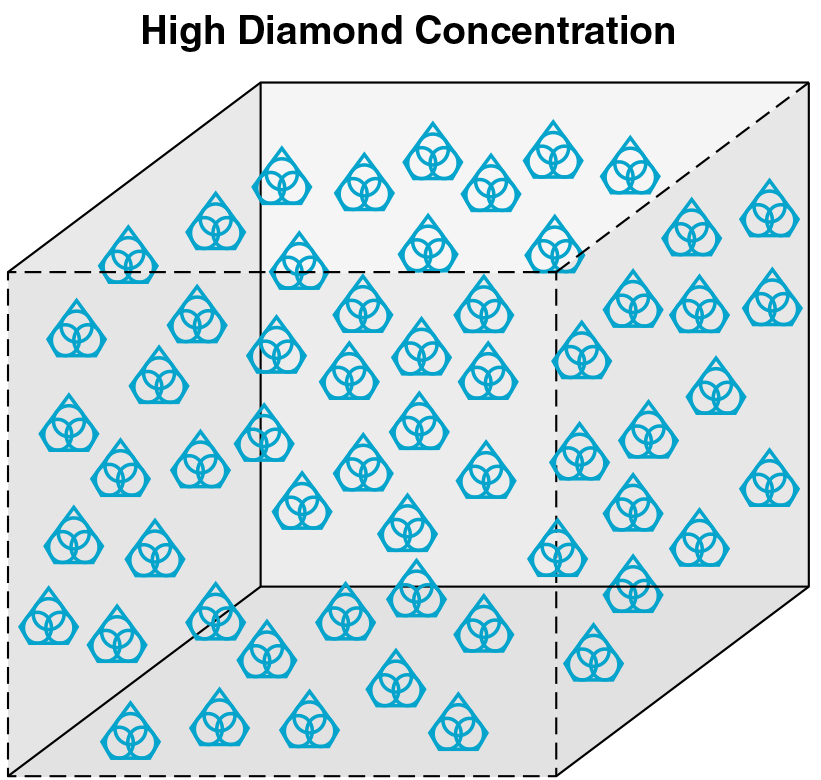
Diamond & CBN concentration is crucial for determining the cutting speed and the lifespan of diamond & cbn blades. Higher concentrations are typically favored for cutting softer, more abrasive materials because they provide more cutting points and distribute wear more evenly. However, this can lead to reduced cutting speeds as more material must be removed to create a path for the blade. Conversely, lower concentrations are preferred for ultra-hard and brittle materials to prevent blade overload and premature breakage.
The concentration range for diamond blades used in cutting tile, stone, and construction applications typically varies depending on the specific needs of the material and the application. However, these blades often feature lower diamond concentrations usually from 5 to 20%, which is significantly lower compared to those used for more specialized or industrial applications.
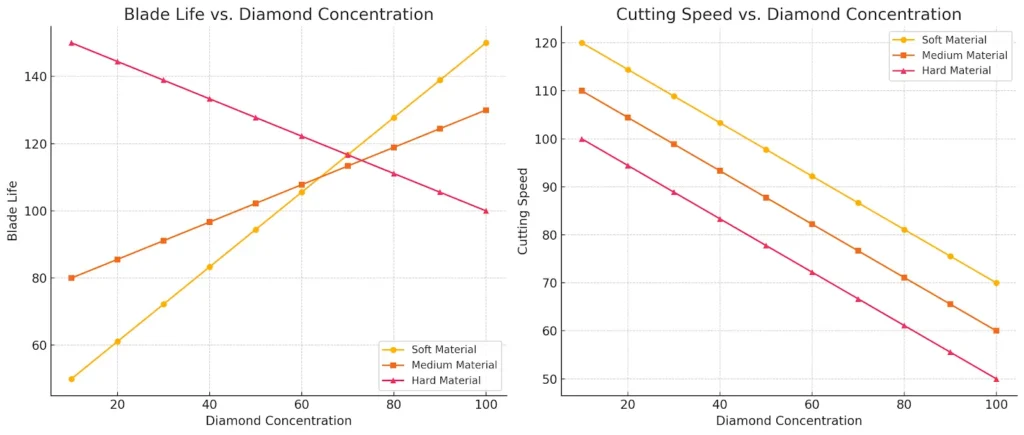
Examples of Diamond Concentration Applications
-
 Concentration 25: Suitable for cutting soft, non-abrasive materials. This concentration might not suffice for high-production environments due to faster wear and tear.
Concentration 25: Suitable for cutting soft, non-abrasive materials. This concentration might not suffice for high-production environments due to faster wear and tear.
-
 Concentration 50: Recommended for a broad range of materials. It balances cutting efficiency with blade longevity, making it suitable for production settings.
Concentration 50: Recommended for a broad range of materials. It balances cutting efficiency with blade longevity, making it suitable for production settings.
-
 Concentration 100: Ideal for extremely hard and dense materials. This higher concentration ensures smoother cuts and tighter tolerances, essential in applications requiring high precision.
Concentration 100: Ideal for extremely hard and dense materials. This higher concentration ensures smoother cuts and tighter tolerances, essential in applications requiring high precision.
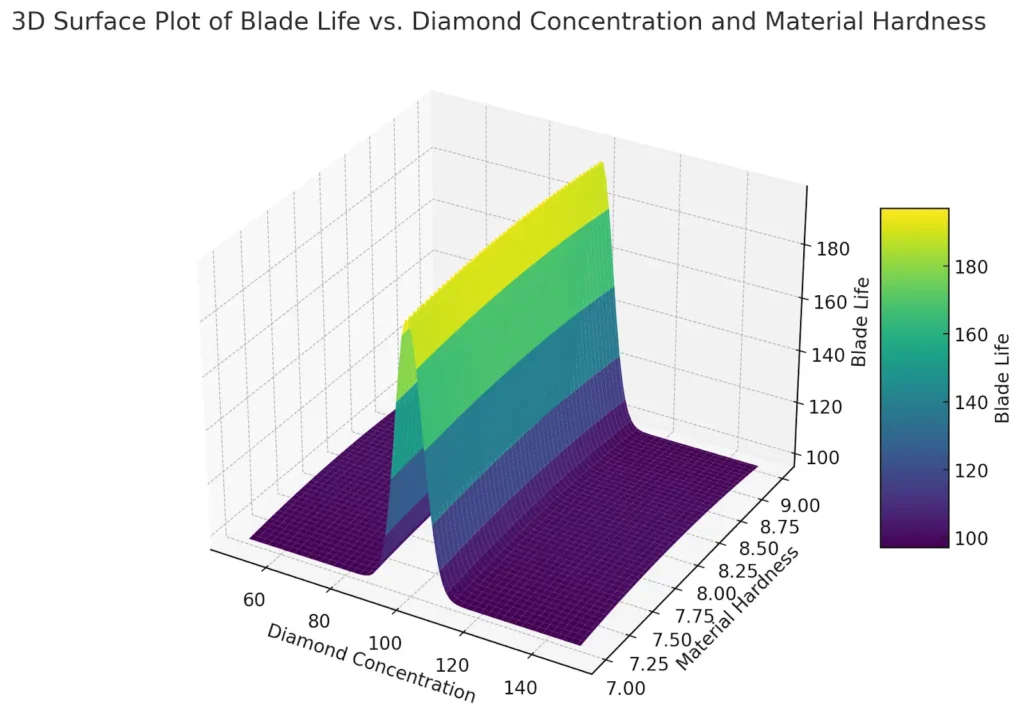
Various variables affect diamond and CBN blade concentration
|
Variable |
Impact on High Concentration |
Impact on Low Concentration |
|---|---|---|
|
Material Hardness |
Less effective for very hard materials; can lead to premature wear |
Preferred for cutting ultra-hard and brittle materials to avoid blade overload |
|
Material Abrasiveness |
More effective as it distributes wear evenly, useful for highly abrasive materials |
Less effective as fewer diamonds are available to share the wear, leading to faster blade degradation |
|
Cutting Speed |
Can decrease due to increased friction and material interaction |
Can increase as less material resistance is encountered |
|
Blade Lifespan |
Potentially increased as wear is distributed over more diamonds |
Potentially reduced due to concentrated wear on fewer diamonds |
|
Material Fracture Risk |
Can increase risk of material damage in brittle materials |
Reduces risk of cracking or damaging brittle materials |
Diamond & CBN Blade Bond Hardness
Bond Hardness – Ability of the bond matrix to hold diamonds. As the hardness of the bond is increased, its diamond retention capabilities increase as well. However the trade off is slower cutting speed. Life of the diamond & cbn blade is usually increased with hardness of its bond matrix. Bonds are designated on their scale of hardness from Soft, Medium, and Hard. There are dozens of variations and classification schemes based on bond degree of hardness or softness. Using diamond blades with optimum bond hardness for your application is important to successful precision diamond sawing operation. Bond matrix that is too soft for the material being cut will release diamond particles faster than needed, resulting in faster wear and shorter diamond blade life. On other hand bond matrix that is too hard will result in much slower cutting speeds and require constant dressing to expose the next diamond layer. As rule of thumb, harder materials such as sapphire and alumina generally require a softer bond. Whereas softer and more brittle materials require a harder bond.

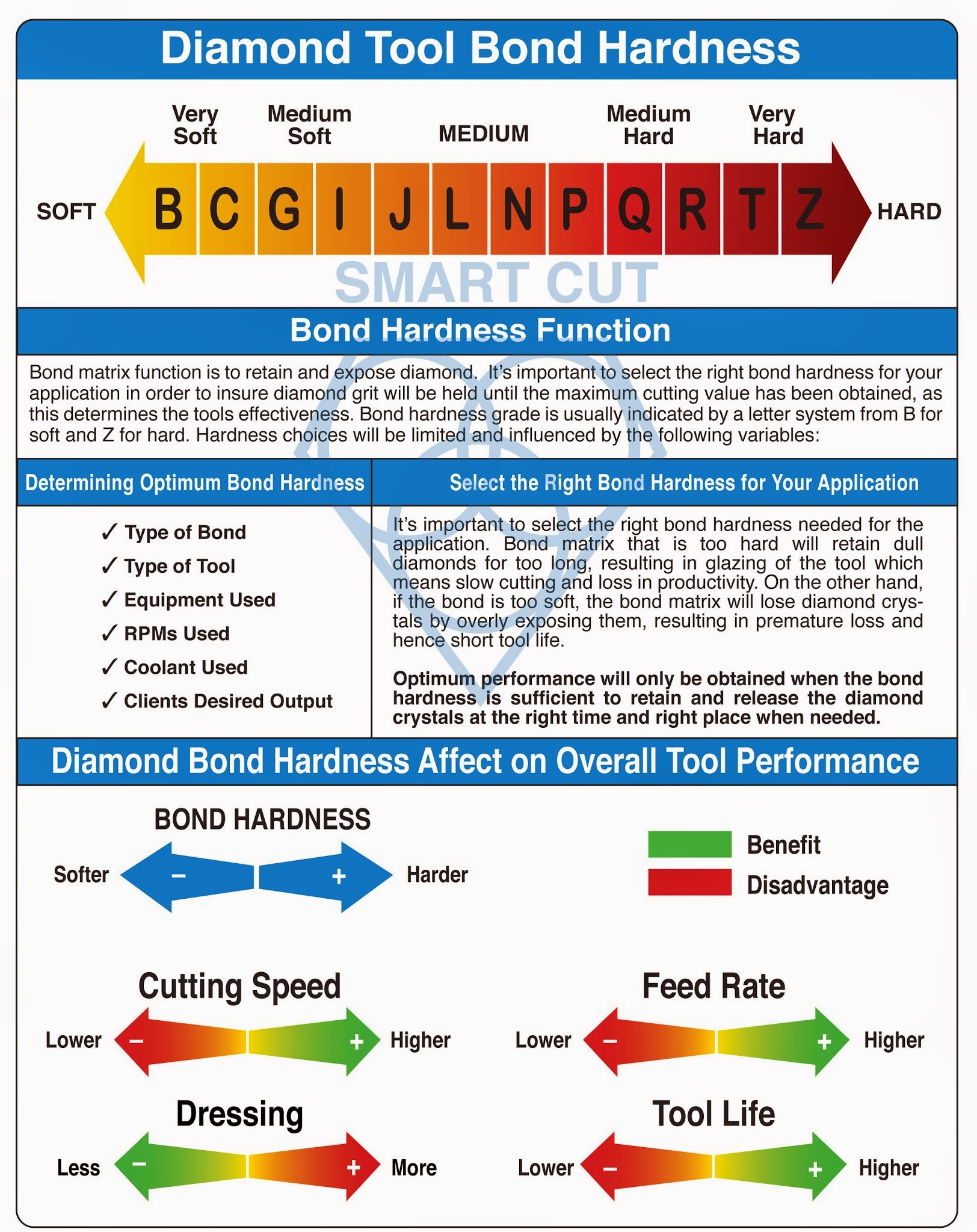
Bond Harnesses for Sintered Metal Bond Diamond & CBN Blades
When selecting a diamond blade, the choice of sintered metal bond hardness is crucial for achieving optimal performance and longevity. The metal bond serves as the matrix that holds the diamond particles in place during the cutting process. Understanding the properties and applications of various metal bond types can significantly enhance the effectiveness of a diamond blade in specific cutting scenarios.
Overview of Sintered Metal Bonds - Sintered metal bonds are composed of various metal alloys that are engineered to wear at a controlled rate. This wear is necessary to continually expose fresh, sharp diamond edges, ensuring effective cutting throughout the blade's lifespan. The metal bond's primary function is twofold: it securely holds the diamond particles until they are worn down, and it releases them at an appropriate rate, allowing new, sharp diamonds to come into contact with the material being cut. The balance between diamond retention and release is critical and is often referred to as the "wear factor" of the blade.

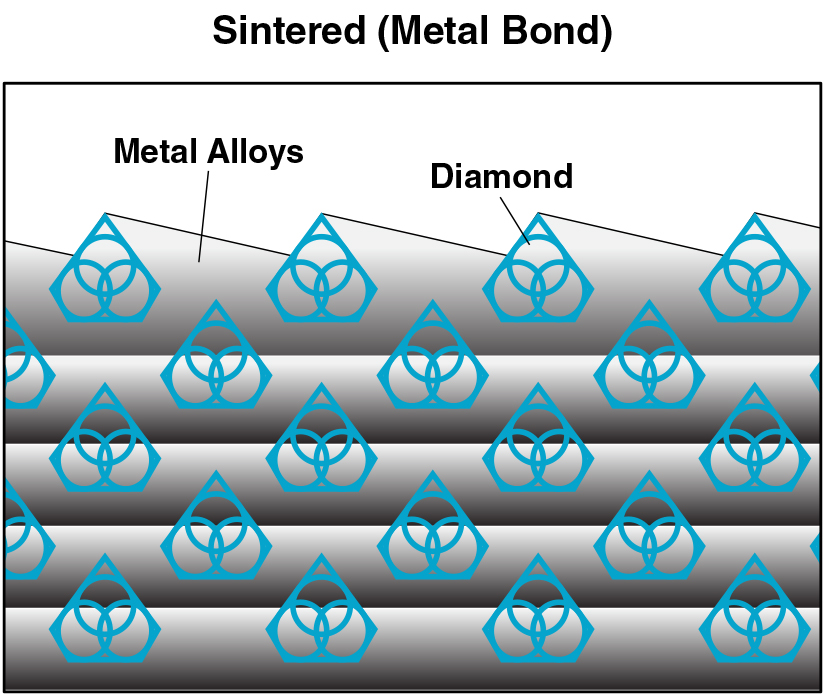
Bond Grading and Its Significance - The bond grading system indicates the relative strength or holding power ("holding powder") of the bond. This grading helps users select a blade that matches the hardness of the material to be cut. A properly graded bond will optimize the blade's cutting speed, quality, and durability. Each bond type is designed to cater to specific material properties and cutting conditions.
The hardness of the bond is a key factor in its performance. A softer bond tends to wear away more quickly, which allows the diamond particles to be exposed more frequently. This can be advantageous when cutting very hard materials, as the fresh exposure of diamond ensures a consistently sharp cutting edge. However, the trade-off is that the blade may wear down faster, requiring more frequent replacements.
On the other hand, a harder bond is designed to wear more slowly, which is beneficial when cutting softer or less abrasive materials. This slower wear rate helps extend the blade's life, making it more cost-effective over time. However, in some cases, the slower exposure of diamond particles can lead to a reduction in cutting speed, particularly with harder materials where more aggressive cutting action is needed.
Each bond type is optimized for specific applications, balancing cutting speed, durability, and the quality of the cut. Selecting the appropriate bond type for a diamond blade requires a deep understanding of the specific cutting application. This involves considerations such as the hardness and abrasiveness of the material to be cut, as well as the desired outcomes like cut speed and finish. Each bond type is crafted to optimize performance in certain scenarios:
-
 Material Hardness: Generally, harder bonds are employed for softer materials to mitigate premature wear. Conversely, softer bonds are preferred for harder materials as they facilitate quicker diamond exposure and accelerate the cutting process.
Material Hardness: Generally, harder bonds are employed for softer materials to mitigate premature wear. Conversely, softer bonds are preferred for harder materials as they facilitate quicker diamond exposure and accelerate the cutting process.
-
 Abrasive Conditions: In situations involving highly abrasive materials, harder bonds are favored because they resist wear better, which helps to prolong the blade's lifespan.
Abrasive Conditions: In situations involving highly abrasive materials, harder bonds are favored because they resist wear better, which helps to prolong the blade's lifespan.
-
 Desired Cut Quality and Speed: Softer bonds tend to cut faster as they expose new diamonds more quickly. However, this can lead to a reduced overall lifespan of the blade due to quicker wear.
Desired Cut Quality and Speed: Softer bonds tend to cut faster as they expose new diamonds more quickly. However, this can lead to a reduced overall lifespan of the blade due to quicker wear.
Comparison table of various bond harnesses used for sintered (metal bond) diamond & cbn blades
|
Bond Type |
Hardness |
Description |
Typical Applications |
Advantages |
|---|---|---|---|---|
|
A Bond |
Soft |
Friable, designed for fast diamond exposure. |
Hard materials like sapphire, tungsten carbide. |
Rapid cutting speed, frequent diamond renewal. |
|
B Bond |
Soft to Medium |
Friable, allows for smooth and fast cuts. |
Quartz, ferrite, hard ceramics, glass. |
Fast, smooth cutting; good for very hard materials. |
|
C Bond |
Medium to Hard |
Tough, designed for abrasive and soft materials. |
Carbon, graphite, plastics, fiberglass. |
Durable in abrasive conditions; extended blade life. |
|
M Bond |
Medium |
Balanced durability and performance. |
General industry materials. |
Good longevity and performance across various materials. |
|
N Bond |
Hard |
Controlled wear, medium hardness. |
Natural stone, composites, medium-grade ceramics. |
Balances durability and cutting efficiency. |
|
S Bond |
Very Hard |
Resists highly abrasive conditions. |
Asphalt, green concrete, abrasive stone. |
Maximizes blade life in abrasive environments. |
|
G Bond |
Specialized |
Optimized for cutting glass and brittle materials. |
Glass and similar brittle materials. |
Reduces chipping, enhances cut quality. |
|
E Bond |
Very Hard |
Designed for extreme conditions and hard materials. |
Very hard and dense materials. |
Prolongs blade life, withstands tough conditions. |
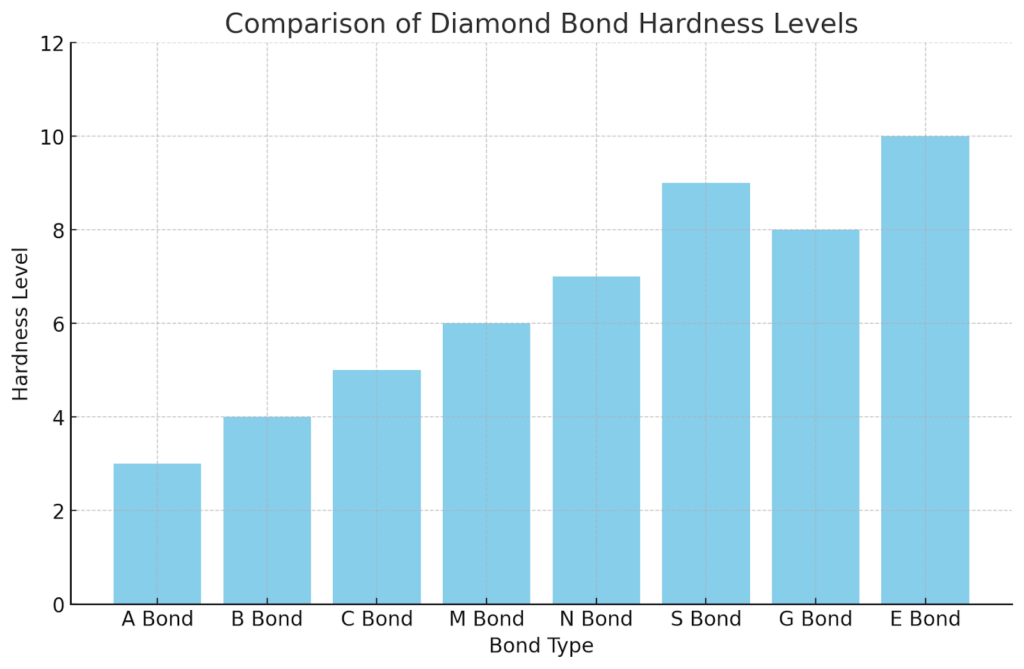
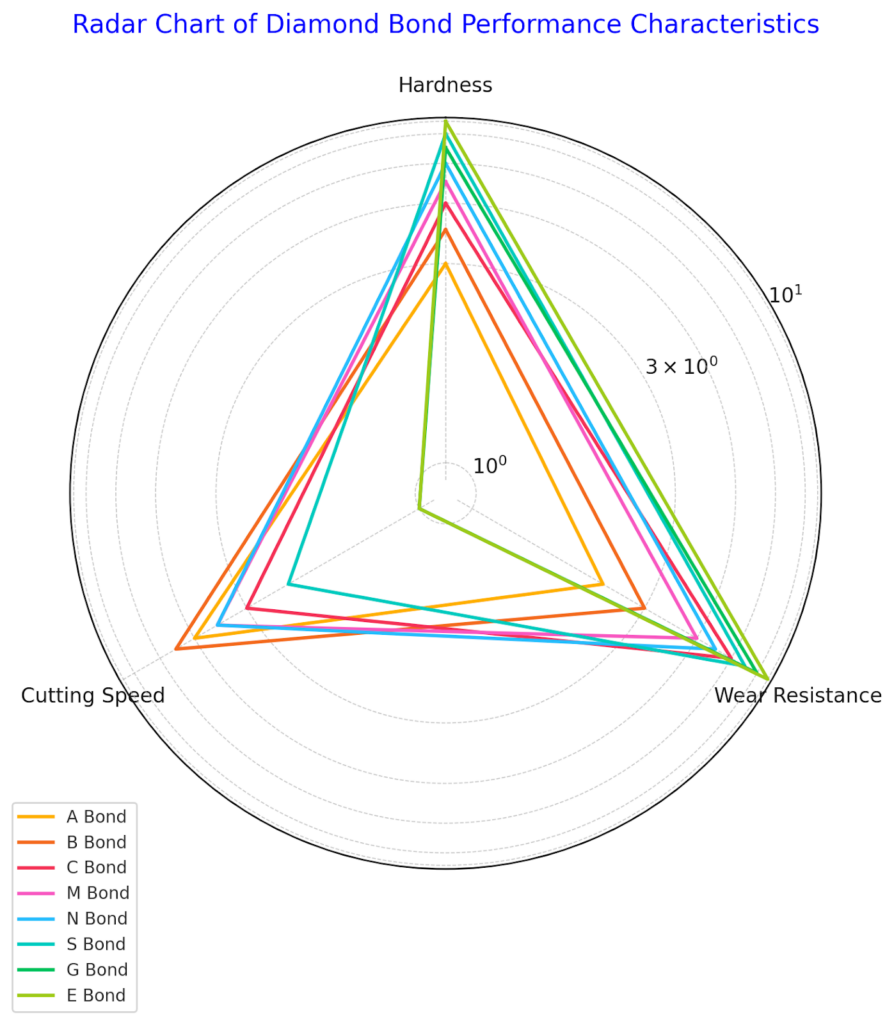
This bar graph shows the comparison of diamond bond hardness levels for various bond types. Each bar represents the relative hardness level of a specific bond type, making it easy to visually compare their characteristics.
Resin Bond Diamond & CBN Blade Bond Hardness
When selecting a resin bond diamond or CBN blade, understanding the hardness of the bond is essential for optimizing performance and ensuring the longevity of the blade. Resin bonds play a critical role in holding the abrasive particles in place during cutting, and their properties directly influence the effectiveness and efficiency of the blade in various cutting applications.
Resin bonds are typically composed of a mixture of resin and fillers, which are engineered to wear at a controlled rate. This wear process is essential for exposing fresh abrasive particles, such as diamond or CBN, to maintain sharpness and cutting efficiency throughout the blade's life. The primary function of the resin bond is to securely hold the abrasive particles while they are cutting and to release them at the appropriate time to continue the cutting process effectively. The balance between retaining and releasing the abrasive particles is often referred to as the "wear factor" and is a key determinant of the blade's performance.

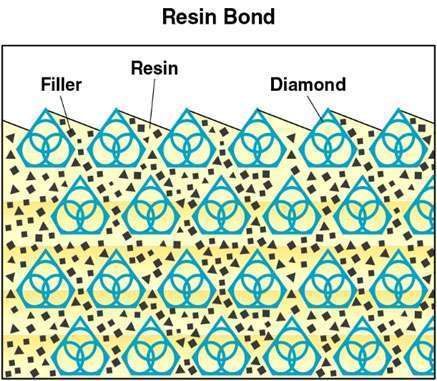
The hardness of the resin bond is a crucial factor in determining how well the blade will perform with different materials. Softer bonds tend to wear away more quickly, which is advantageous when cutting hard, brittle materials because it allows for faster exposure of new abrasive particles, maintaining a sharp cutting edge. However, this also means that the blade may wear out more quickly, leading to more frequent replacements.
In contrast, harder resin bonds wear more slowly, making them suitable for cutting softer or less abrasive materials. The slower wear rate helps extend the blade's life, making it more cost-effective in the long run. However, in some cases, the slower exposure of new abrasive particles can reduce the cutting speed, especially when working with harder materials that require more aggressive cutting action.
Each resin bond type is optimized for specific applications, balancing factors such as cutting speed, blade durability, and the quality of the cut. Selecting the appropriate bond type involves considering the material's hardness, abrasiveness, and the desired outcomes, such as cut speed and surface finish. Here’s a general guide:
-
 Material Hardness: For softer materials, harder bonds are typically preferred as they prevent premature wear. Conversely, for harder materials, softer bonds are favored because they allow quicker exposure of new abrasive particles, accelerating the cutting process.
Material Hardness: For softer materials, harder bonds are typically preferred as they prevent premature wear. Conversely, for harder materials, softer bonds are favored because they allow quicker exposure of new abrasive particles, accelerating the cutting process.
-
 Abrasive Conditions: In cutting highly abrasive materials, harder bonds are often selected because they resist wear better, which helps prolong the blade's lifespan.
Abrasive Conditions: In cutting highly abrasive materials, harder bonds are often selected because they resist wear better, which helps prolong the blade's lifespan.
-
 Desired Cut Quality and Speed: Softer bonds generally enable faster cutting as they expose new abrasive particles more rapidly. However, this can result in a shorter overall blade lifespan due to quicker wear.
Desired Cut Quality and Speed: Softer bonds generally enable faster cutting as they expose new abrasive particles more rapidly. However, this can result in a shorter overall blade lifespan due to quicker wear.
This table compares the different resin bond harnesses for diamond and CBN blades
|
Bond Type |
Characteristics |
Typical Applications |
Advantages |
|---|---|---|---|
|
E Bond |
Extra soft, quick wear, high diamond exposure |
Very brittle or delicate materials |
Maximizes cutting speed, minimizes sub-surface damage |
|
A Bond |
Soft, high diamond exposure |
Hard, brittle materials like glass and ceramics |
Fast cutting rate, excellent for smooth finishes |
|
B Bond |
Medium-soft, balanced wear and exposure |
Medium-hard materials |
Balances cutting speed with reasonable durability |
|
M Bond |
Medium hardness, versatile |
Wide range of materials, including metals and stones |
Good for varied materials, balances precision and wear |
|
N Bond |
Medium-hard, durable, slower diamond exposure |
Softer materials that are abrasive |
Enhances blade life, maintains performance under less abrasion |
|
H Bond |
Hard, durable, very slow diamond exposure |
Harder, less abrasive materials |
Extends blade life significantly, ideal for continuous use |
|
P Bond |
Designed for porcelain, balanced |
Hard materials like porcelain |
Optimal for hard materials, minimizes chipping, good blade longevity |
|
S Bond |
Very hard, slow wear |
Highly abrasive materials |
Maximizes lifespan in abrasive environments |
|
X Bond |
Extra hard, maximum longevity |
Highly abrasive materials |
Sustains performance, very stable in challenging environments |
|
T Bond |
Tough, resistant to shock and impact |
Materials causing blade deflection |
Durable against mechanical stresses, prolongs life |
|
F Bond |
Flexible, adapts to uneven surfaces |
Thin stone, composite materials |
Reduces breakage, allows for adaptive cutting |
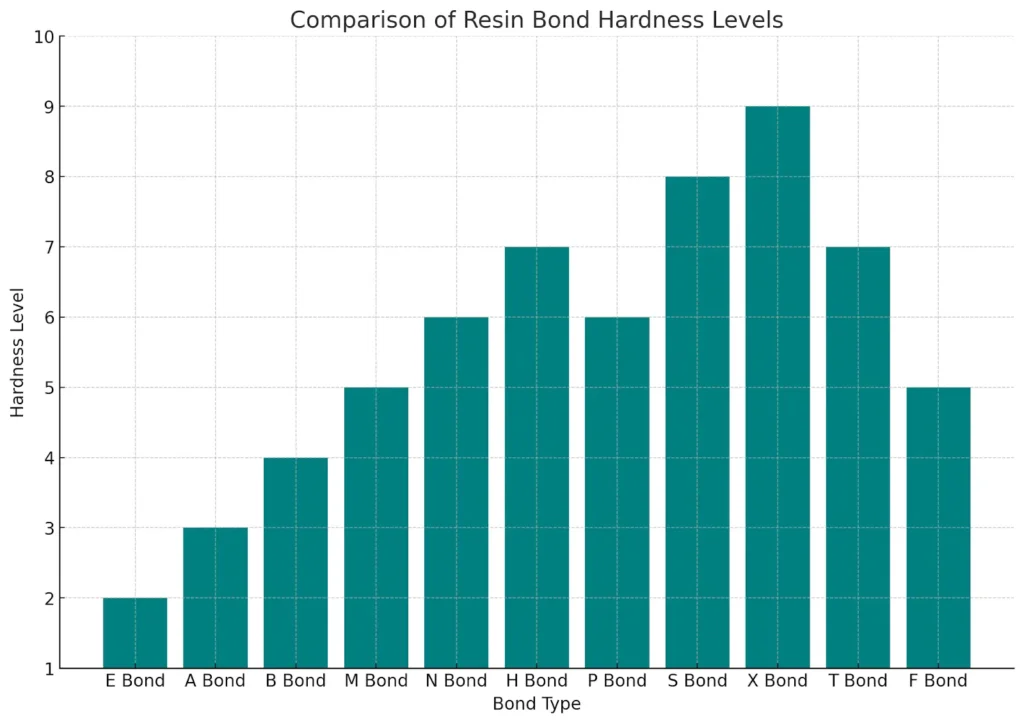
This bar graph shows the comparison of resin bond hardness levels for various bond types. Each bar represents the relative hardness level of a specific bond type, providing a visual representation of their differences. This chart can help in selecting the appropriate bond type based on the hardness
requirement for specific cutting applications.
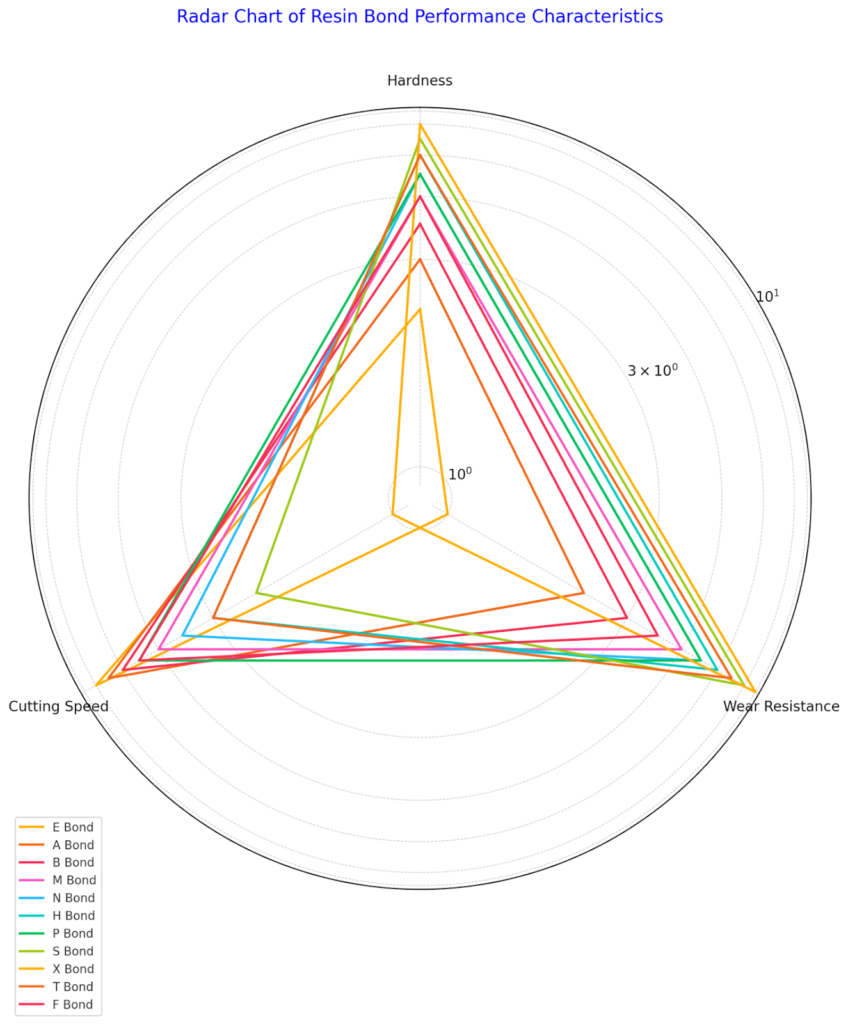

RPM’s (Cutting Speed)
Revolutions Per Minute (RPM) is a critical factor in the operation of diamond and CBN blades, directly influencing the efficiency, quality, and overall performance of the cutting process. RPM refers to the number of times the blade completes a full rotation in one minute, and this measurement plays a vital role in determining the material removal rate, blade life, and surface finish.
Operating a blade at the correct RPM is essential for optimal cutting performance. Higher RPM typically increases the rate at which material is removed, but it must be balanced carefully to avoid overheating or damaging the material being cut. Proper RPM settings also contribute to extending the life of the blade by reducing unnecessary wear and tear. Furthermore, the right RPM can result in a smoother surface finish, as the cutting action becomes more refined and precise.
Different materials respond uniquely to various RPM settings. For example, harder materials like ceramics or metals often require lower RPMs to prevent excessive heat generation, which could lead to damage. On the other hand, softer materials might allow for higher RPMs, enabling faster cutting rates without compromising the integrity of the blade or the material.
Diamond blades are designed to operate within specific RPM ranges depending on their diameter and the hardness of the material being cut. Small diameter blades, such as those ranging from 2 to 4 inches, are typically run at higher RPMs, often between 10,000 to 15,000 RPM, making them ideal for precise, delicate cuts on thin materials. Medium diameter blades, ranging from 6 to 12 inches, usually operate within the range of 4,000 to 10,000 RPM and are versatile, suitable for a variety of materials including metals, ceramics, and composites. Larger diameter blades, from 14 to 36 inches, generally run at lower RPMs, around 1,000 to 4,000 RPM, and are used for heavy-duty cutting of thick materials.
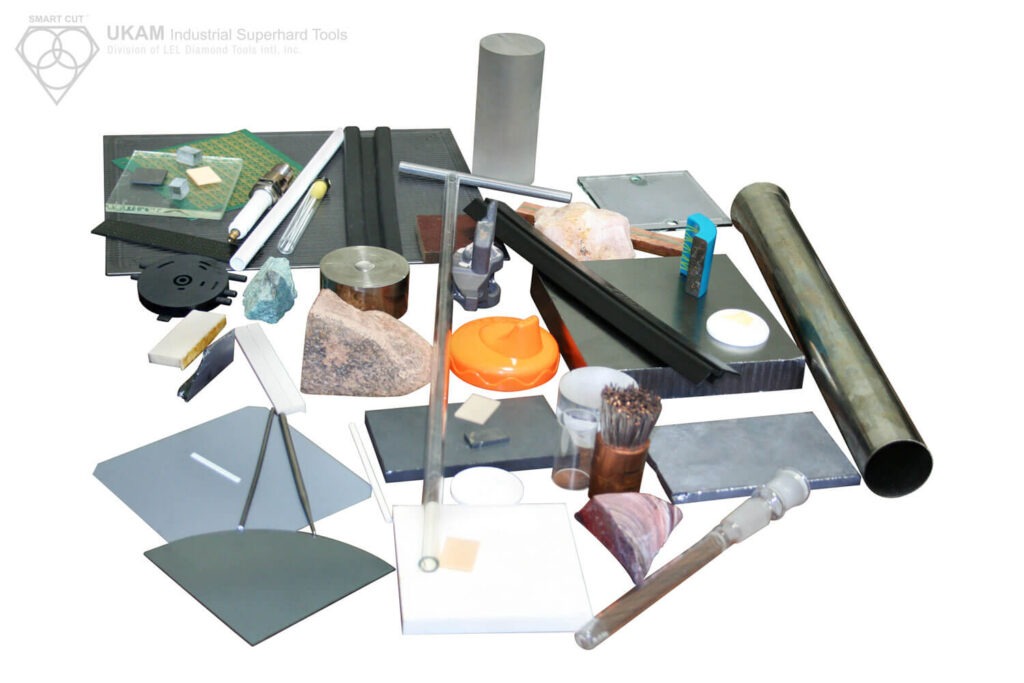
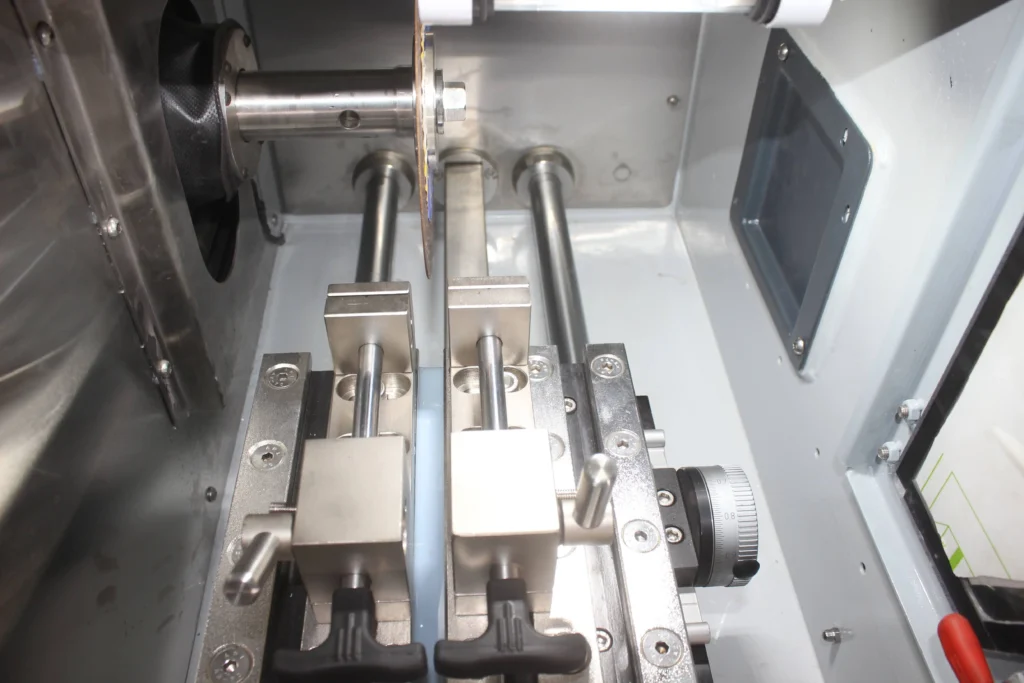
CBN blades, optimized for high-speed operations, are particularly effective when cutting ferrous materials. Small diameter CBN blades are often used at higher RPMs, around 8,000 to 12,000 RPM, for fast and efficient cutting of hardened steel and other tough materials. Medium to large diameter CBN blades typically operate in the range of 3,000 to 8,000 RPM, balancing speed with the need for controlled, precise cuts.
There is an important inverse relationship between blade diameter and RPM. As the diameter of the blade increases, the optimal RPM decreases. This is because larger blades have a higher peripheral speed at the same RPM, which can lead to overheating and excessive wear if not properly adjusted. For instance, a 4-inch diamond blade might operate at 12,000 RPM, providing a peripheral speed suitable for cutting hard materials like ceramics. In contrast, a 24-inch diamond blade would typically operate at around 2,500 RPM to maintain a similar peripheral speed, ensuring effective cutting without compromising blade integrity.
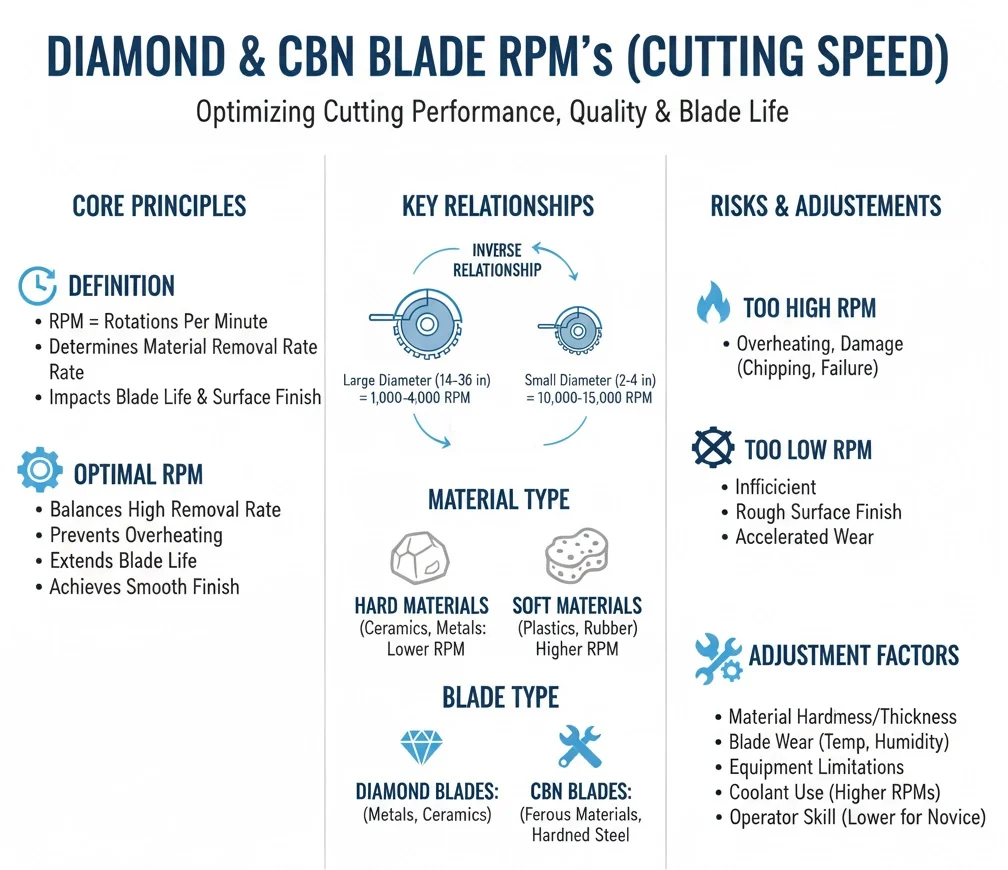
Using an incorrect RPM setting can lead to several issues. If the RPM is too high, it can cause the blade to overheat, which may damage both the blade and the material, leading to chipping or even complete blade failure. Excessive RPMs also accelerate wear on the blade’s cutting edges, shortening its useful life, and may result in a rough or uneven surface finish due to increased vibration and instability. Conversely, running a blade at too low of an RPM can lead to inefficient cutting, with slower progress and increased cutting force. This may also cause the blade to stall or bind in the material, potentially damaging both the blade and the workpiece, while requiring more force to achieve the desired cutting action, leading to higher stress on both the blade and the equipment.
Adjusting the RPM based on the material being cut is essential. Harder materials, such as steel or ceramics, typically require lower RPMs to avoid excessive heat build-up, while softer materials can generally be cut at higher RPMs, allowing for faster material removal without damaging the blade. As a blade wears, its cutting efficiency decreases, which may necessitate adjustments in RPM. New blades can often be operated at higher RPMs within their recommended range, but as the blade wears, reducing the RPM can help maintain cutting performance and prevent further degradation. Environmental factors, such as temperature and humidity, can also affect the optimal RPM. In hot environments, reducing the RPM can help manage heat build-up, while humidity may alter material properties, requiring slight RPM adjustments to maintain cutting efficiency. Additionally, not all cutting equipment can handle the same RPM ranges, so it is important to understand your machine’s limitations. High-speed equipment is typically designed for small diameter blades and faster cutting operations, whereas low-speed equipment is better suited for large diameter blades and heavy-duty cutting tasks.
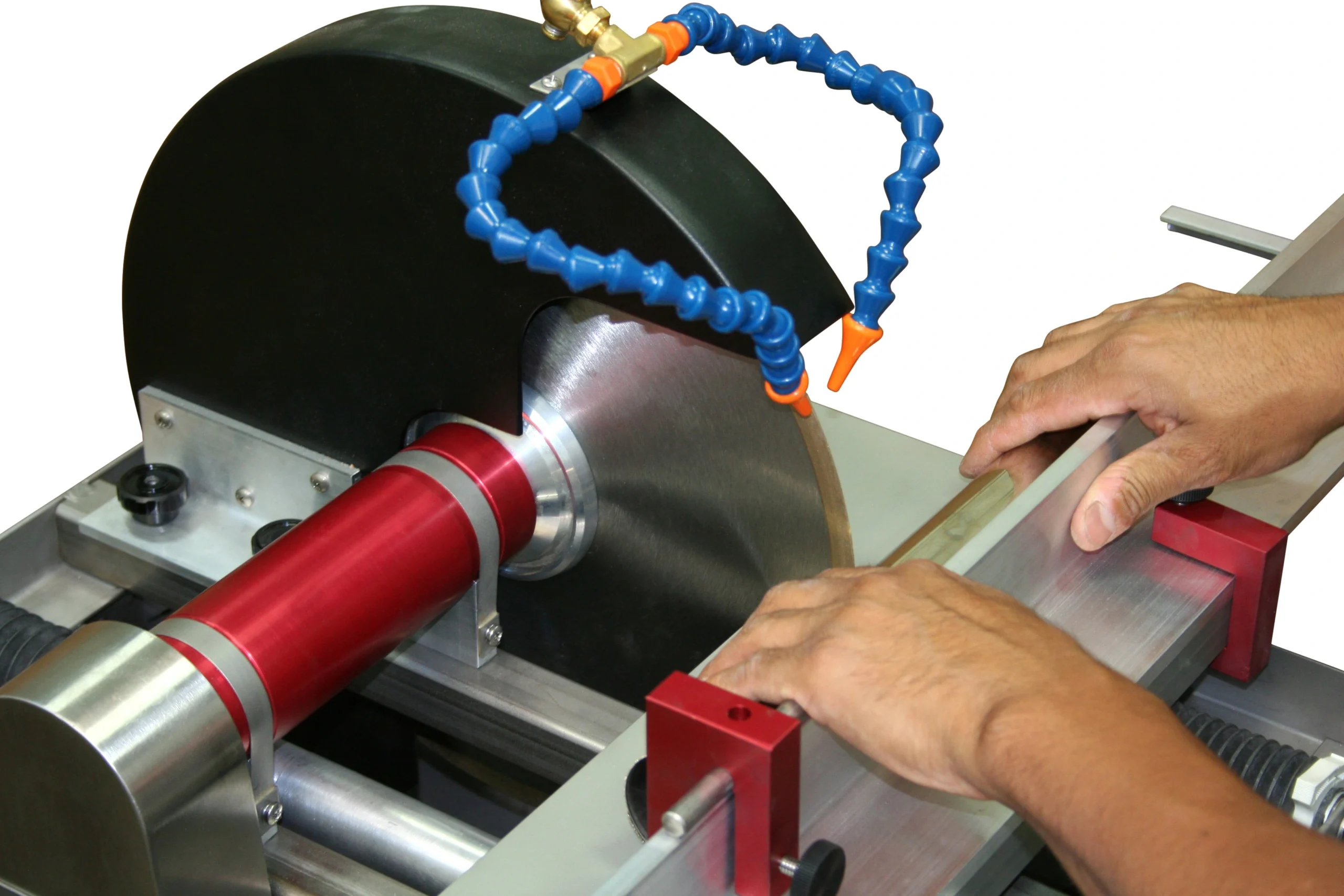
Ensuring that your cutting machine is calibrated to operate at the correct RPM is important for achieving the desired cutting results. Tools like digital tachometers can accurately measure the RPM and ensure it matches the recommended settings for your blade. Periodic checks and calibration of the equipment’s speed controls can prevent RPM drift and maintain cutting accuracy. Continuous monitoring of RPM during operation is also necessary to adapt to changing conditions. Some advanced machines allow for real-time RPM adjustments based on load and material feedback, ensuring optimal performance throughout the cutting process.
Operating blades at the correct RPM is not only about performance but also safety. Adhering to the manufacturer’s guidelines for RPM settings is essential to avoid dangerous situations such as blade shattering or overheating. Improper RPM settings can lead to serious accidents, including catastrophic blade failure, which can result in injury, or excessive heat from high RPMs, which can cause fires or burns. Regular maintenance helps ensure that RPM settings remain safe and effective. Ensuring that lubrication and cooling systems are functioning correctly is vital for managing heat at higher RPMs, and regular inspection of blades for signs of wear may require RPM adjustments or blade replacement.
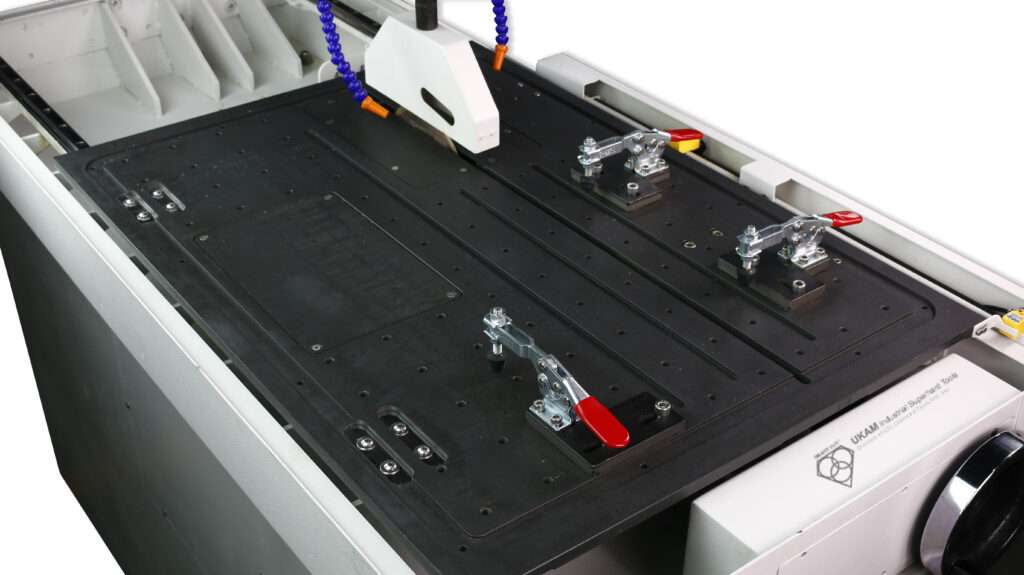
Cutting Rates (Output)
The cutting rate, or the speed at which the material is cut, is a fundamental performance metric that directly influences both productivity and efficiency in cutting operations. Achieving the optimal cutting rate requires a delicate balance between the need for speed, the quality of the cut, and the longevity of the blade. This balance is crucial for ensuring that the cutting process meets the specific requirements of the application, whether the focus is on maximizing throughput, achieving high precision.
High Cutting Rate: Prioritizing a high cutting rate is often the strategy of choice in applications where productivity is highly important. In environments such as mass production or situations where time is of the essence, a high cutting rate allows for a significant volume of material to be processed in a short period.
This typically involves the use of blades designed for aggressive cutting action, which can quickly cut through material with minimal resistance. However, this approach comes with trade-offs. The aggressive nature of high-speed cutting can lead to increased blade wear, as the blade encounters more friction and stress. Additionally, the cut quality may be compromised, with potential issues such as rough edges, increased chipping, or heat-affected zones on the material surface. These factors must be carefully considered, particularly when the final product's appearance or structural integrity is critical.
Moderate Cutting Rate: For many applications, a moderate cutting rate strikes the best balance between speed and quality. This approach is ideal in scenarios where both productivity and cut quality are important, but neither can be compromised.

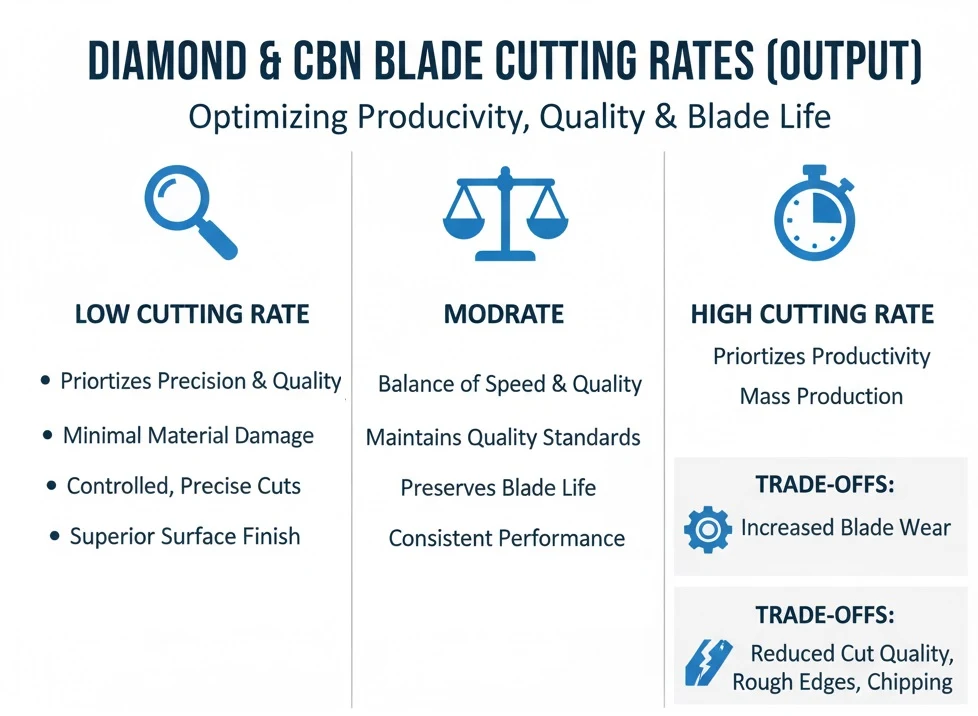
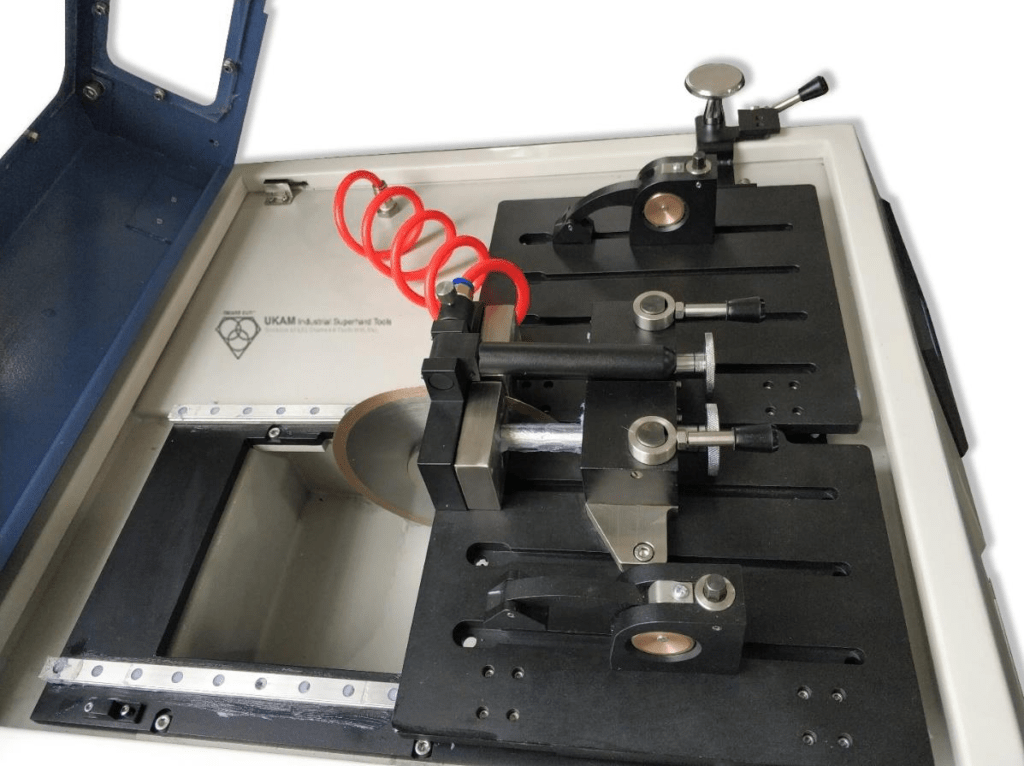
By maintaining a moderate cutting rate, the operator can achieve reasonable throughput while ensuring that the quality of the cut remains within acceptable standards. This balance is particularly important in industries such as automotive or aerospace manufacturing, where both precision and efficiency are required to meet production targets and quality control standards. A moderate cutting rate also helps to preserve blade life, as it reduces the level of wear and tear experienced during high-speed cutting, leading to more consistent performance over time.
Low Cutting Rate: In precision applications, where the quality of the cut and the surface finish are critical, a low cutting rate is often necessary. This approach is common in industries such as optics, medical device manufacturing, or any field where the exact dimensions and surface integrity of the cut material is important such as sample preparation and metallography.
By operating at a lower cutting rate, the blade encounters less friction and heat, which significantly reduces the risk of material damage such as cracking, chipping, or distortion. Additionally, a slower cutting process allows for more controlled, precise cuts, ensuring that the final product meets the stringent quality requirements typical of these industries. While this method may decrease overall productivity, the trade-off is justified by the superior cut quality and extended blade life. The reduced rate of wear on the blade means fewer replacements are necessary, which can be particularly important when using high-cost blades or when working with materials that are expensive or difficult to replace.
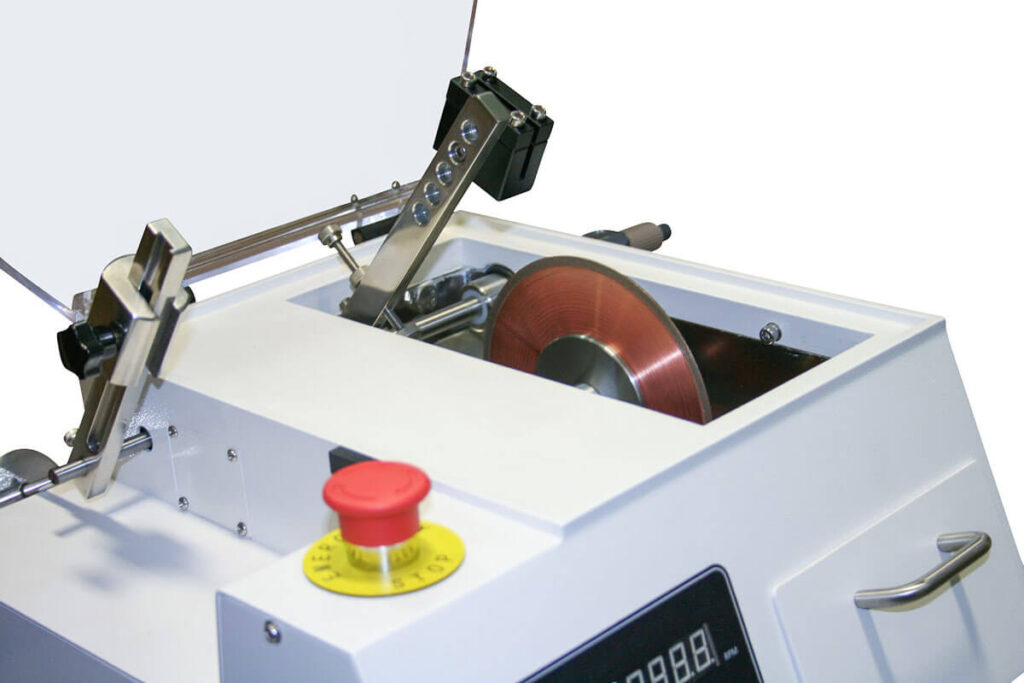
Standard or Custom Diamond & CBN Blade Specifications
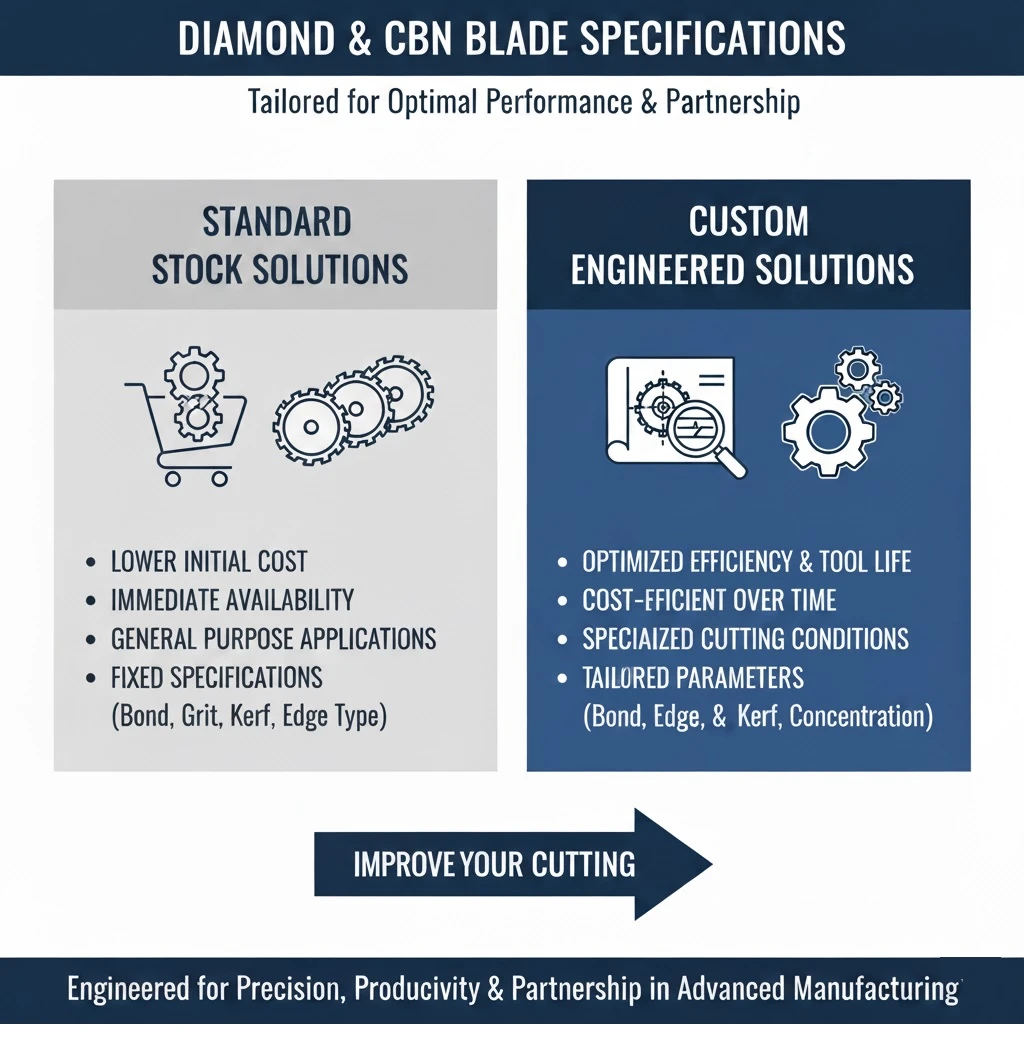 However, we also recognize that not every application falls within standard parameters. When you face specialized cutting conditions, unique material properties, or require specific features, specifications or functionality beyond what our standard stock blades can offer, our custom diamond and CBN blades provide the tailored solution you need. Custom blades are designed and manufactured to meet the exact specifications of your application, ensuring optimal performance. Whether it’s optimizing cutting speed, improving surface finish, or extending blade life, our custom blades are engineered to handle the precise challenges of your materials and cutting environment.
However, we also recognize that not every application falls within standard parameters. When you face specialized cutting conditions, unique material properties, or require specific features, specifications or functionality beyond what our standard stock blades can offer, our custom diamond and CBN blades provide the tailored solution you need. Custom blades are designed and manufactured to meet the exact specifications of your application, ensuring optimal performance. Whether it’s optimizing cutting speed, improving surface finish, or extending blade life, our custom blades are engineered to handle the precise challenges of your materials and cutting environment.
We can customize every aspect of the blade, from bond type, edge design to kerf thickness and diamond or CBN concentration, and much more. This level of customization allows us to create blades that not only fit your specific machinery but also maximize tool life and reduce operating costs. While custom blades may involve a higher initial investment, they often prove to be more cost-efficient over time by reducing wear, minimizing material loss, and improving overall cutting efficiency. And depending on quantity the cost can often be singicantly lower .
Let us be your partner in success, we are committed to helping you make the best choice for your cutting needs. Whether you opt for one of our standard stock solutions or require a custom blade crafted to your exact specifications, we are here to provide you with the highest quality products and expert guidance to ensure the best possible results for your application.

CUSTOM MADE
Have A Unique Requirement?
Let us make custom diamond & CBN Blades specifically designed for your application/ requirements
Just about any diamond/cbn blade can be Designed and manufactured per your drawing or specifications

No Minimum
Order Quantity

Fast Lead
Times

Precision Tolerances

Free
Consultation

Limitless
Possibilities
When selecting the right diamond or CBN cutting blade for your application, you can choose between our standard stock solutions or custom blades designed specifically for your needs. We understand that each option has its unique benefits, and the right choice depends on the specific demands of your application, the materials you are working with, and your production requirements.
Our standard stock diamond and CBN blades are designed to meet a wide range of of requirements for many different materials, industries, and applications. These blades are readily available in various sizes, thicknesses, bond types, diamond grit sizes, concentrations, bond hardnesses, etc, making them a convenient and cost-effective choice for many applications. Because these blades are mass-produced, they are often more affordable and can be delivered quickly, allowing you to minimize downtime and keep your production on schedule.
Custom
Diamond & CBN Manufacturing Process
The following process describes custom tool manufacturing process form initial first inquiry to final delivery.
-
1

Discovery
We discuss your specific requirement in detail to determine the best solution for your needs.
-
2

Recommend Solution
We provide you with recommend options for your application based on your requirements along with quotation and lead time.
-
3

Prepaire To Implement
When you are ready to order, we send you confirmation of the tool specification always in writting. Your order is placed in que to be produced within the quoted lead time.
-
4

Implement & Deliver
The finished products go through quality control process and also inspected for conformance to specification agreed upon. The order is packaged and shipped to you using your requested shipping method. Certificate of conformance or any other documentation can be provided upon request.
-
5

Service & Support
We follow up with you to receive feedback on the tool performance. We also provide usage recommendatios and technical support if needed.
However, we also recognize that not every application falls within standard parameters. When you face specialized cutting conditions, unique material properties, or require specific features, specifications or functionality beyond what our standard stock blades can offer, our custom diamond and CBN blades provide the tailored solution you need. Custom blades are designed and manufactured to meet the exact specifications of your application, ensuring optimal performance. Whether it’s optimizing cutting speed, improving surface finish, or extending blade life, our custom blades are engineered to handle the precise challenges of your materials and cutting environment.
We can customize every aspect of the blade, from bond type, edge design to kerf thickness and diamond or CBN concentration, and much more. This level of customization allows us to create blades that not only fit your specific machinery but also maximize tool life and reduce operating costs. While custom blades may involve a higher initial investment, they often prove to be more cost-efficient over time by reducing wear, minimizing material loss, and improving overall cutting efficiency. And depending on quantity the cost can often be singicantly lower .
Let us be your partner in success, we are committed to helping you make the best choice for your cutting needs. Whether you opt for one of our standard stock solutions or require a custom blade crafted to your exact specifications, we are here to provide you with the highest quality products and expert guidance to ensure the best possible results for your application.

Ayan Sadyk is a materials scientist and process engineer with over two decades of experience in the industrial diamond tooling sector. His expertise lies in integrating ultra-thin diamond blades, CBN wheels, and advanced cutting systems into precision manufacturing workflows for applications in optics, semiconductors, and technical ceramics.
With a background in materials behavior and surface integrity, Mr. Sadyk brings a data-driven, application-specific approach to cutting and grinding process development. He has worked closely with manufacturers and R&D facilities across Eastern Europe, North America, and the Middle East, helping optimize tool life, surface finish, and process stability.
As an author, he focuses on bridging materials science with tooling innovation—writing on topics such as blade wear mechanisms, thermal effects in hard material sectioning, and adaptive process design.

ARE YOU USING RIGHT DIAMOND & CBN BLADES
FOR YOUR APPLICATION?
LET US
HELP YOU
HAVING ISSUES WITH
YOUR CURRENT DIAMOND & CBN BLADES?
Knowledge Center
How to Properly Use Precision Diamond & CBN Blades
Precision & Ultra Thin Diamond Blade Guide
How to Improve & Optimize Your Diamond Sawing Operation
Evaluating & Comparing Diamond Blades
Top 5 Diamond & CBN Cutting Blade Performance Metrics
Diamond & CBN Cutting Blade Performance Metrics that you Should Know
Total Cost of Ownership & Why its Important
Understanding Tradeoffs- Searching for Perfect Diamond & CBN Blade

Ayan Sadyk is a materials scientist and process engineer with over two decades of experience in the industrial diamond tooling sector. His expertise lies in integrating ultra-thin diamond blades, CBN wheels, and advanced cutting systems into precision manufacturing workflows for applications in optics, semiconductors, and technical ceramics.
With a background in materials behavior and surface integrity, Mr. Sadyk brings a data-driven, application-specific approach to cutting and grinding process development. He has worked closely with manufacturers and R&D facilities across Eastern Europe, North America, and the Middle East, helping optimize tool life, surface finish, and process stability.
As an author, he focuses on bridging materials science with tooling innovation—writing on topics such as blade wear mechanisms, thermal effects in hard material sectioning, and adaptive process design.
























































